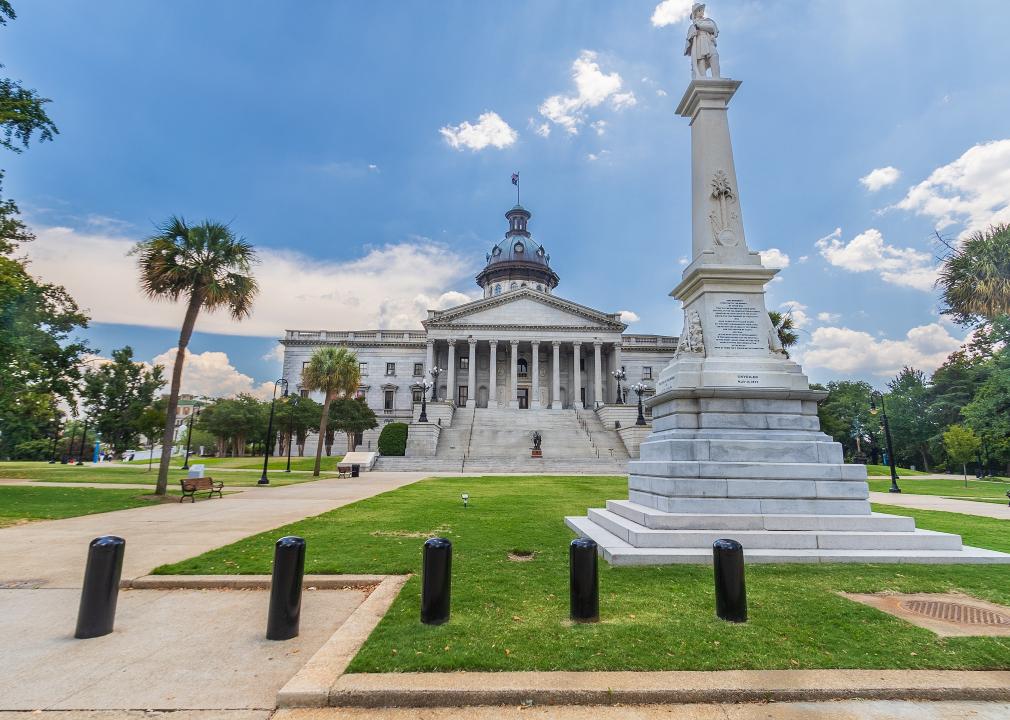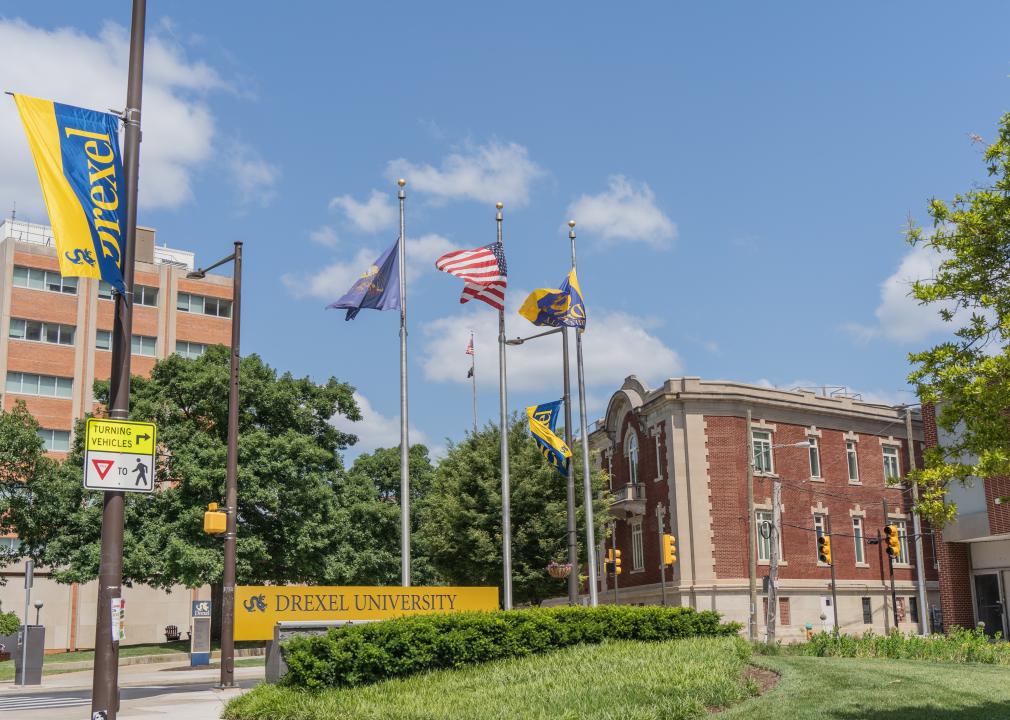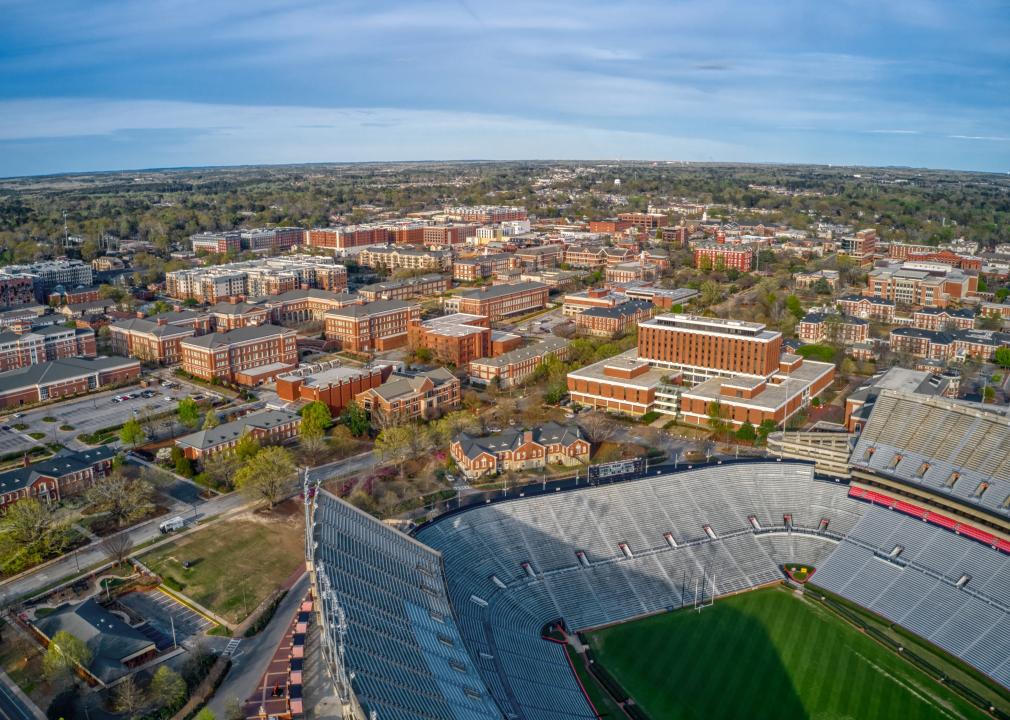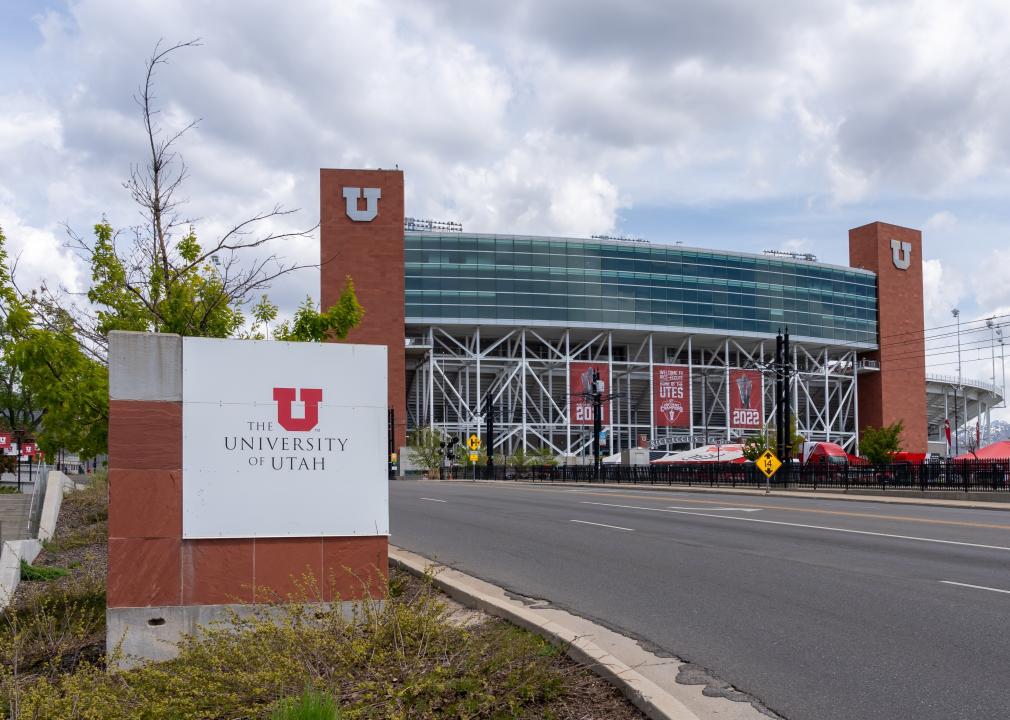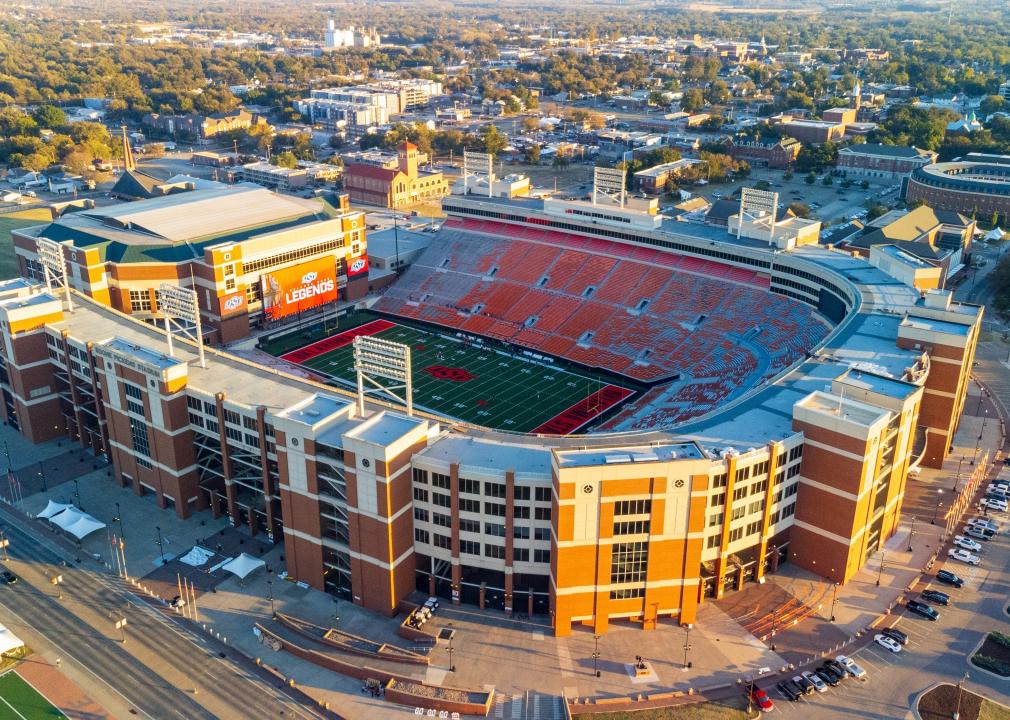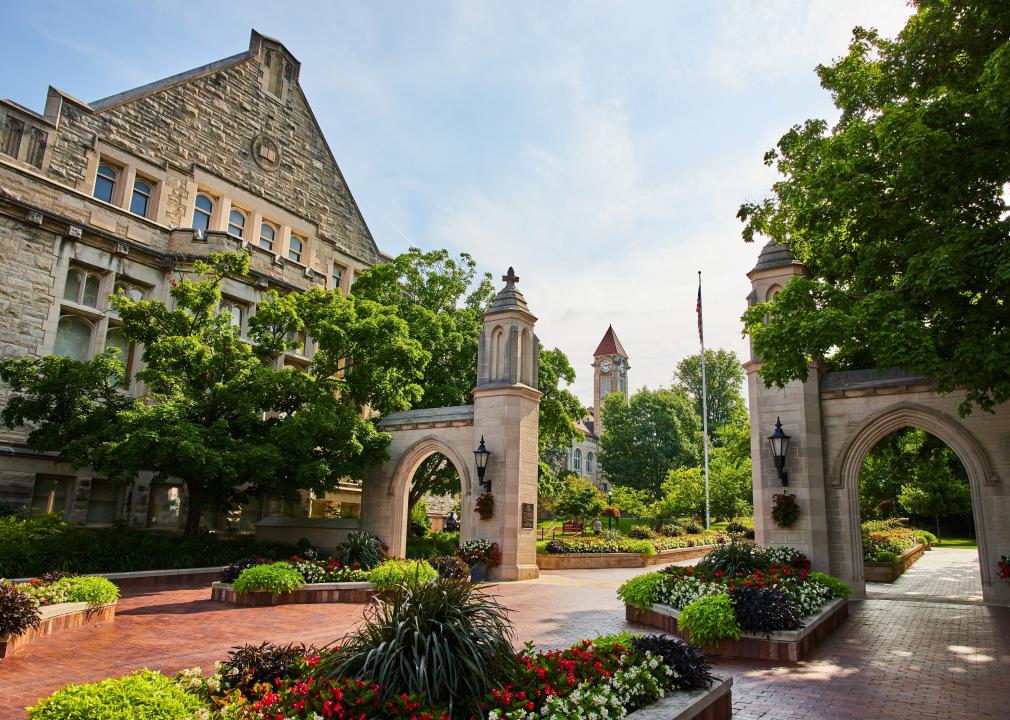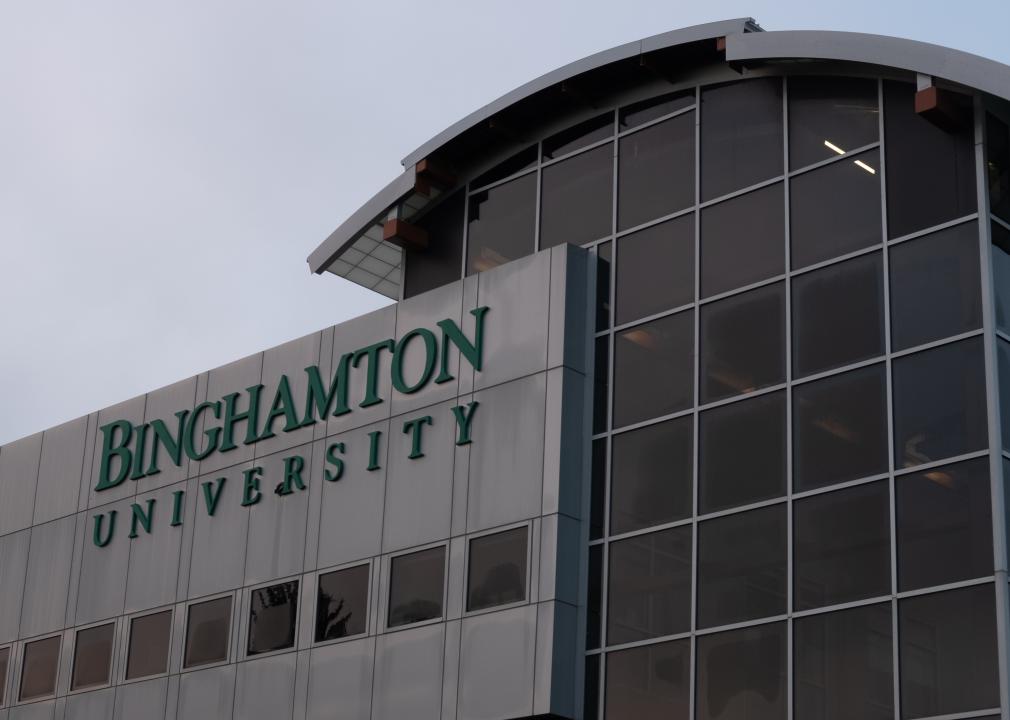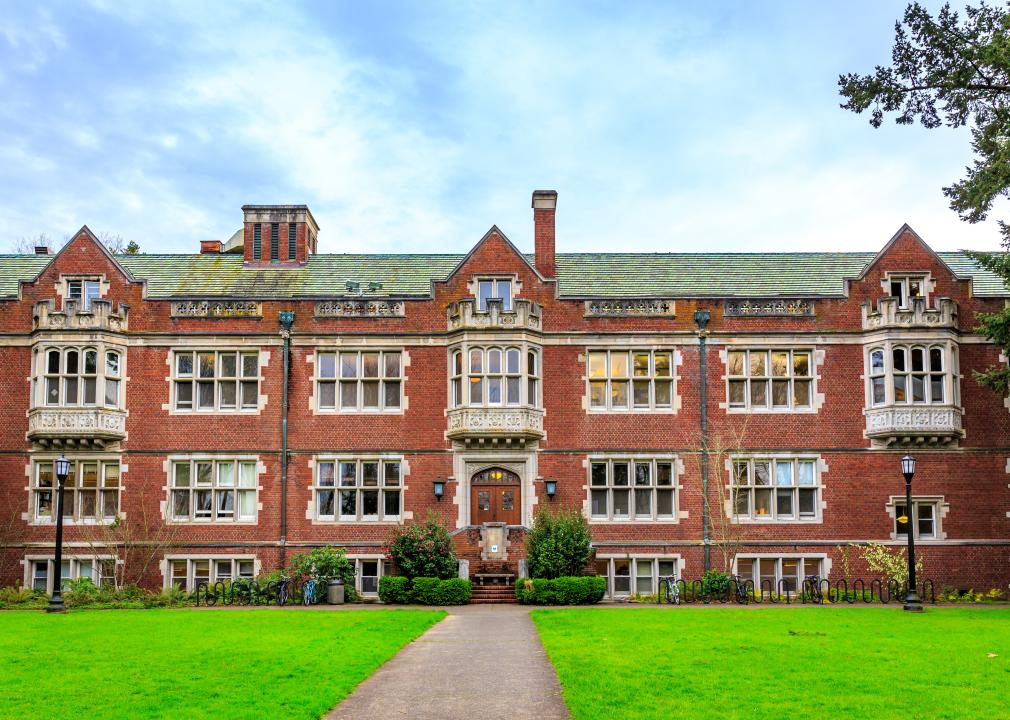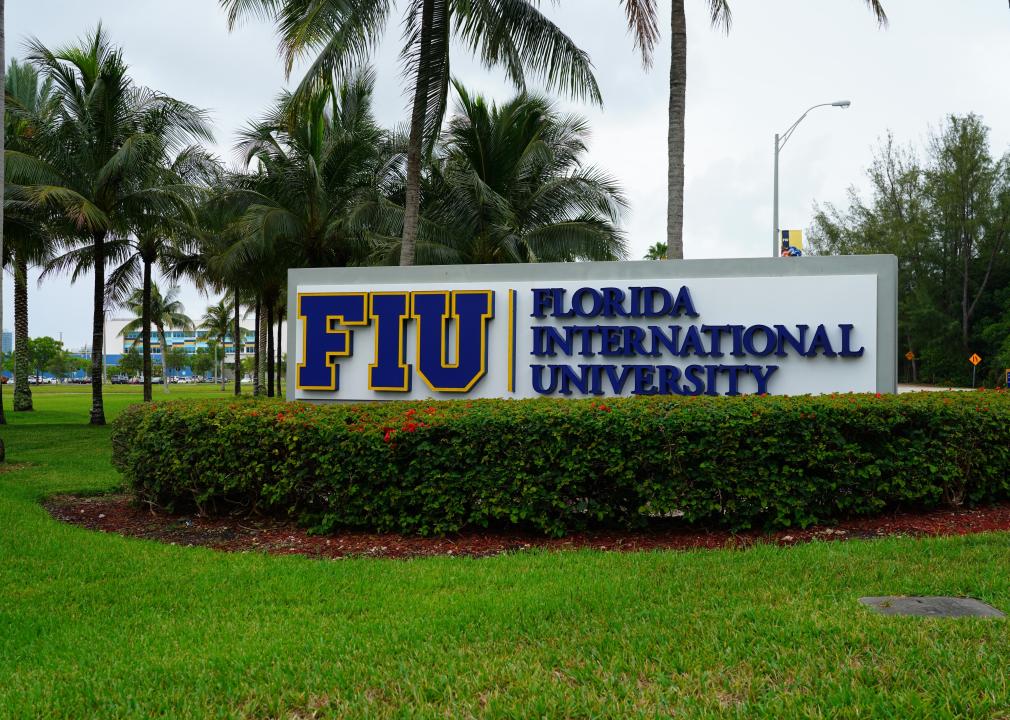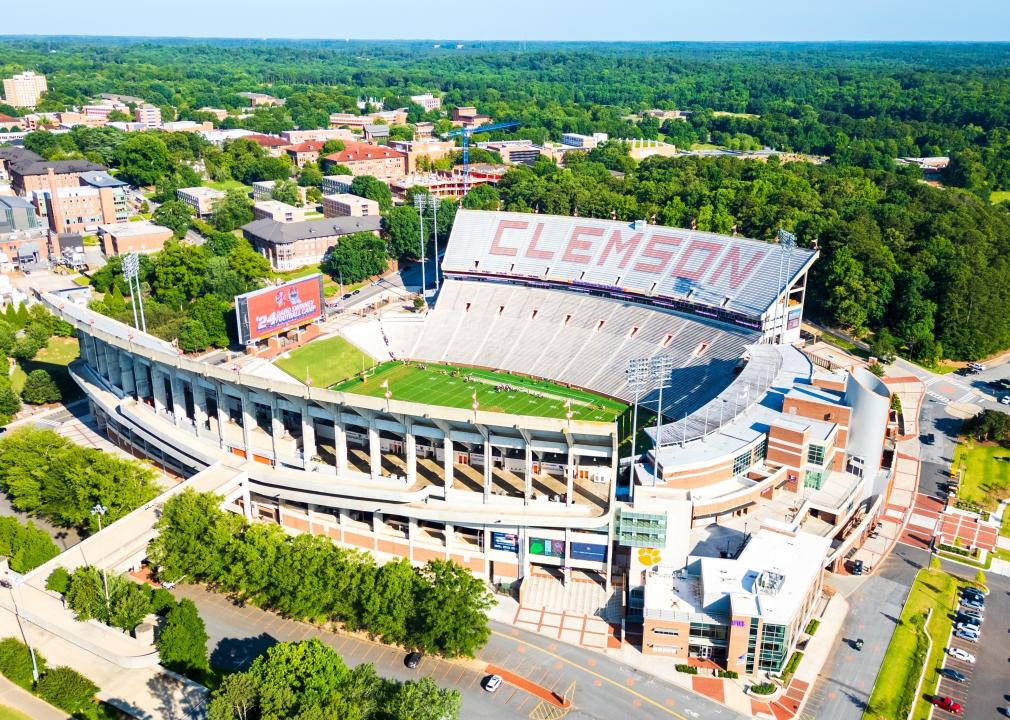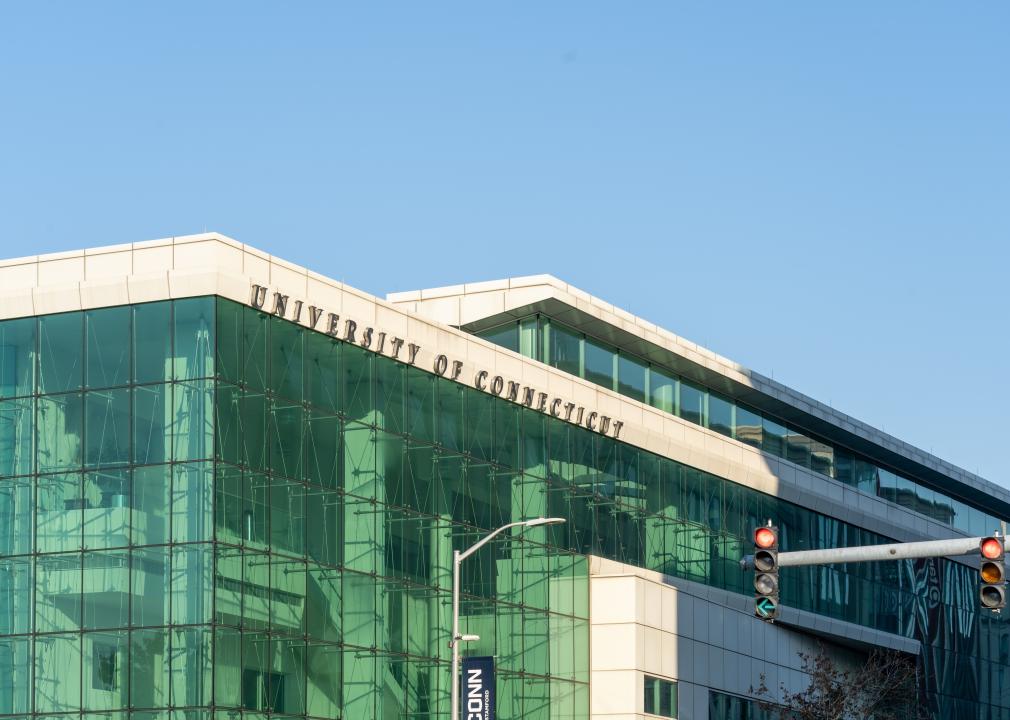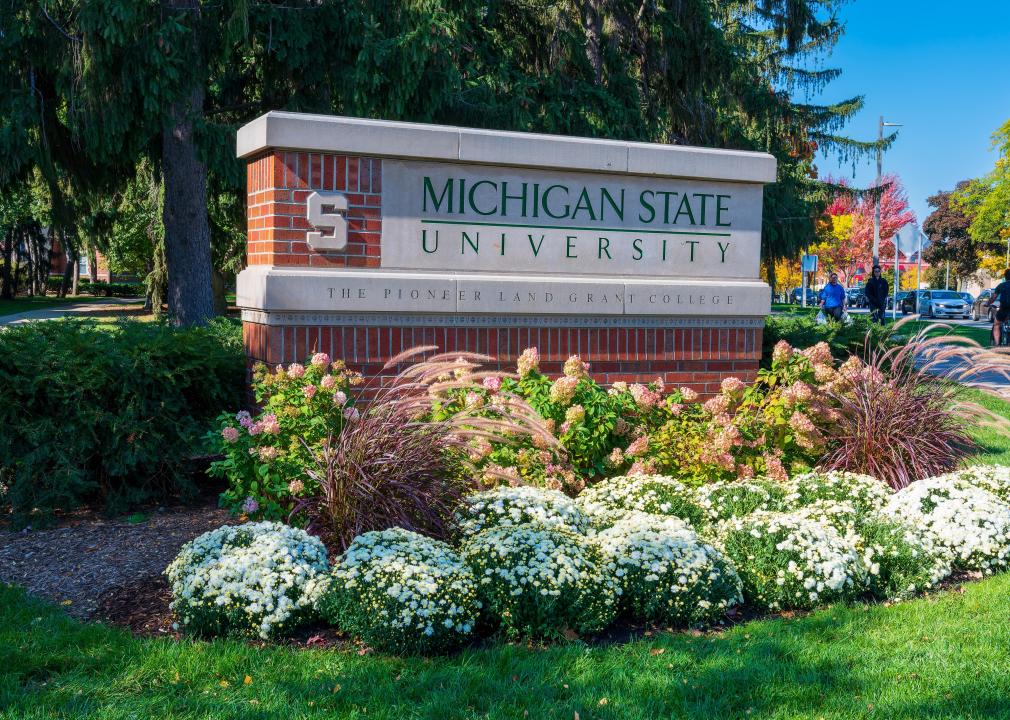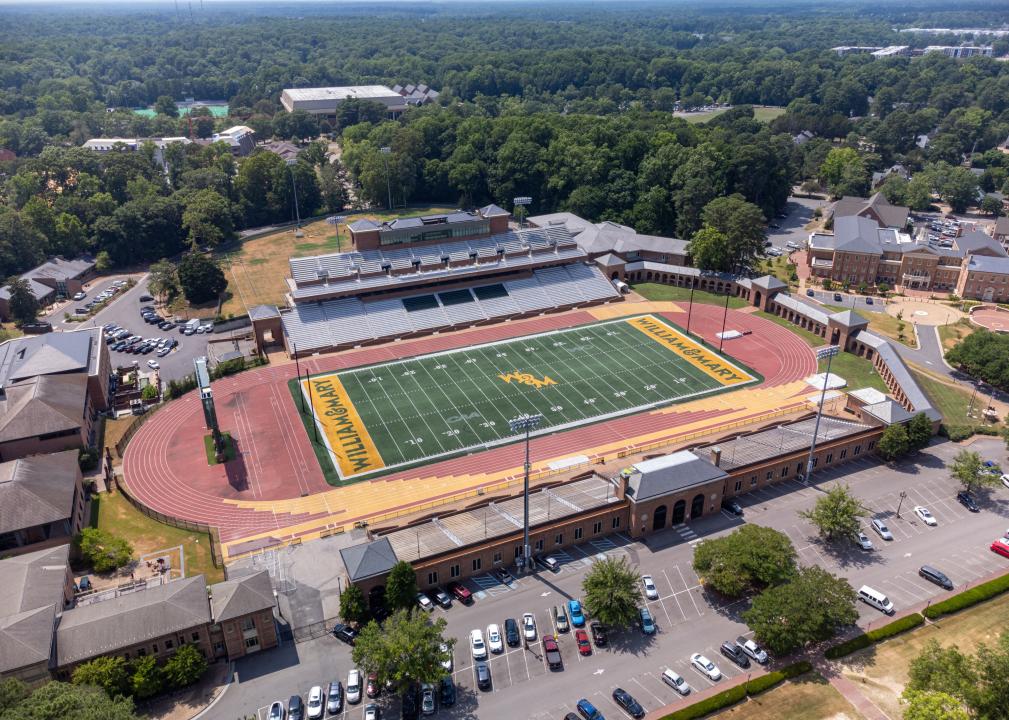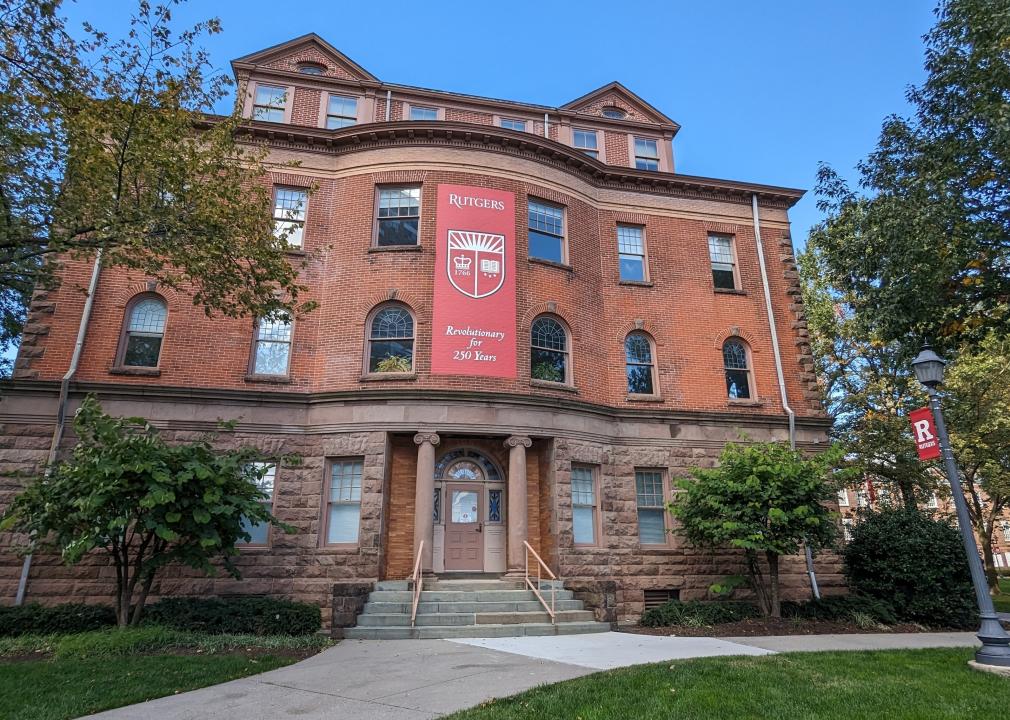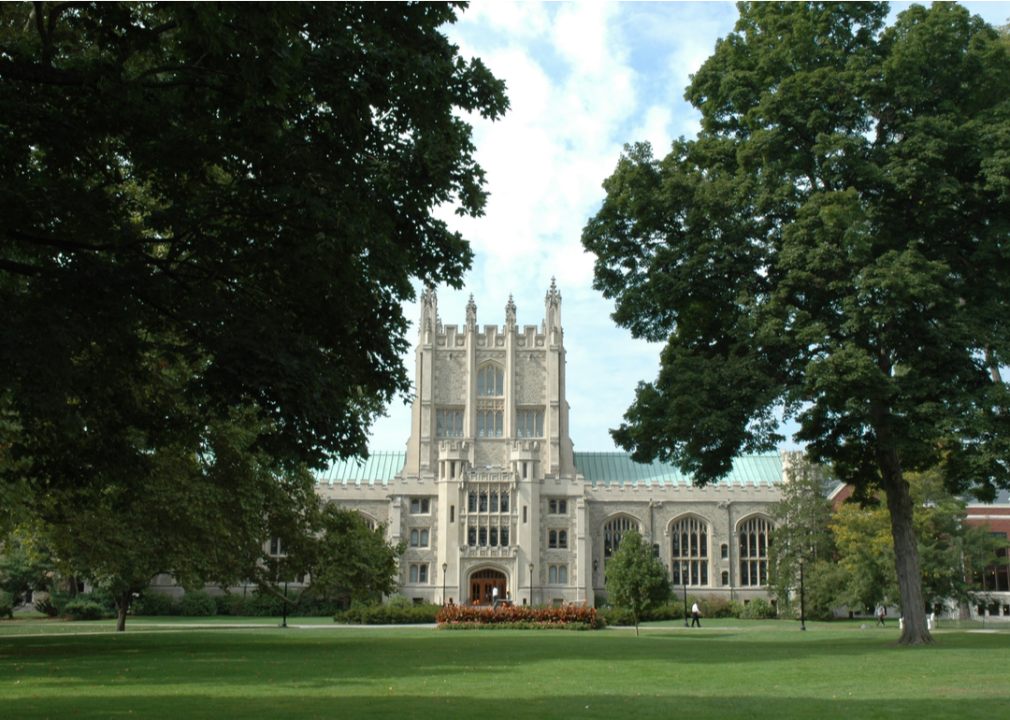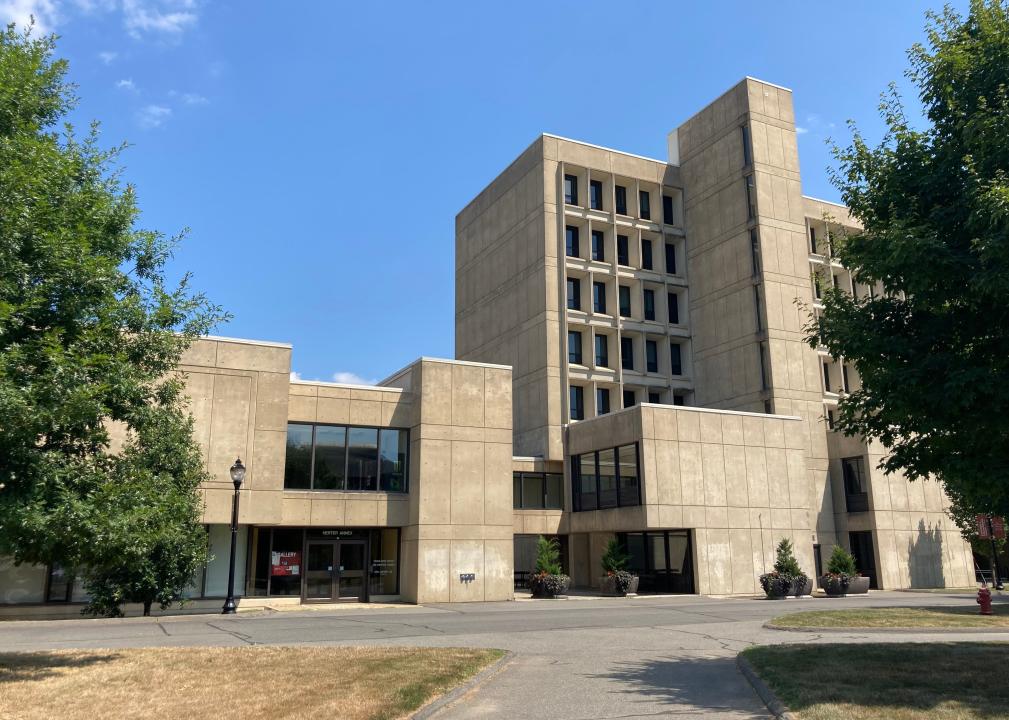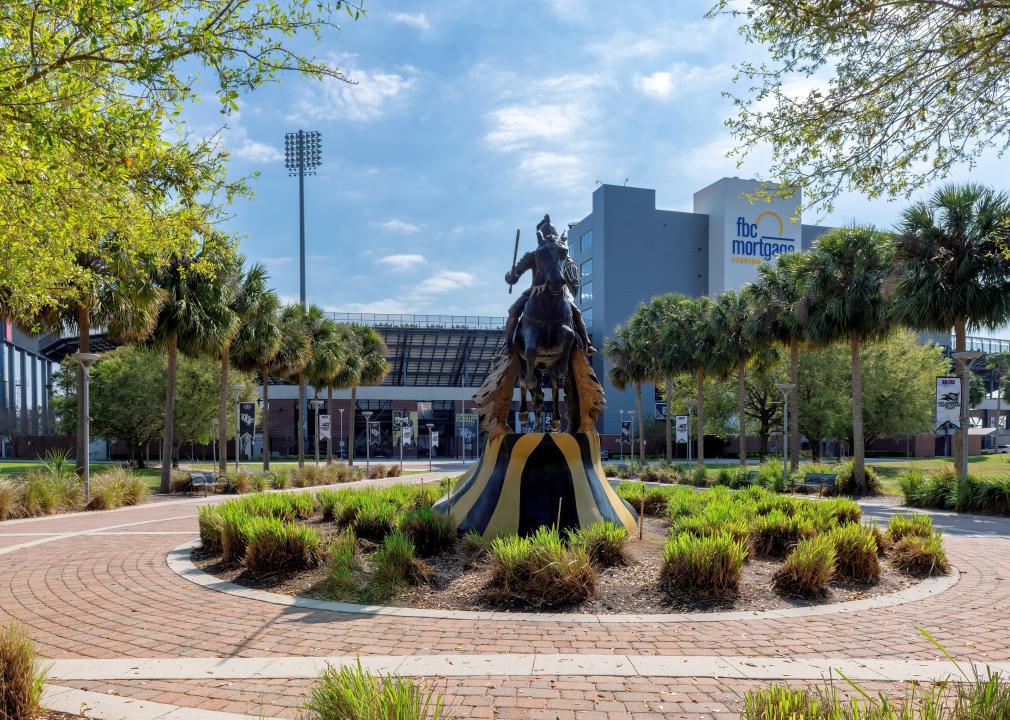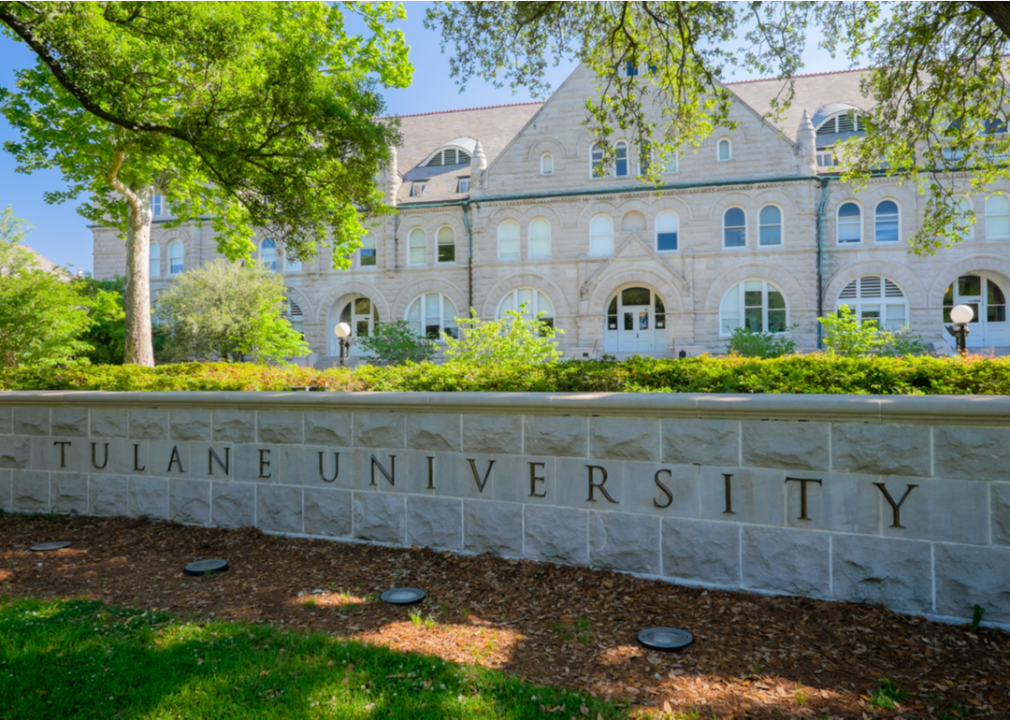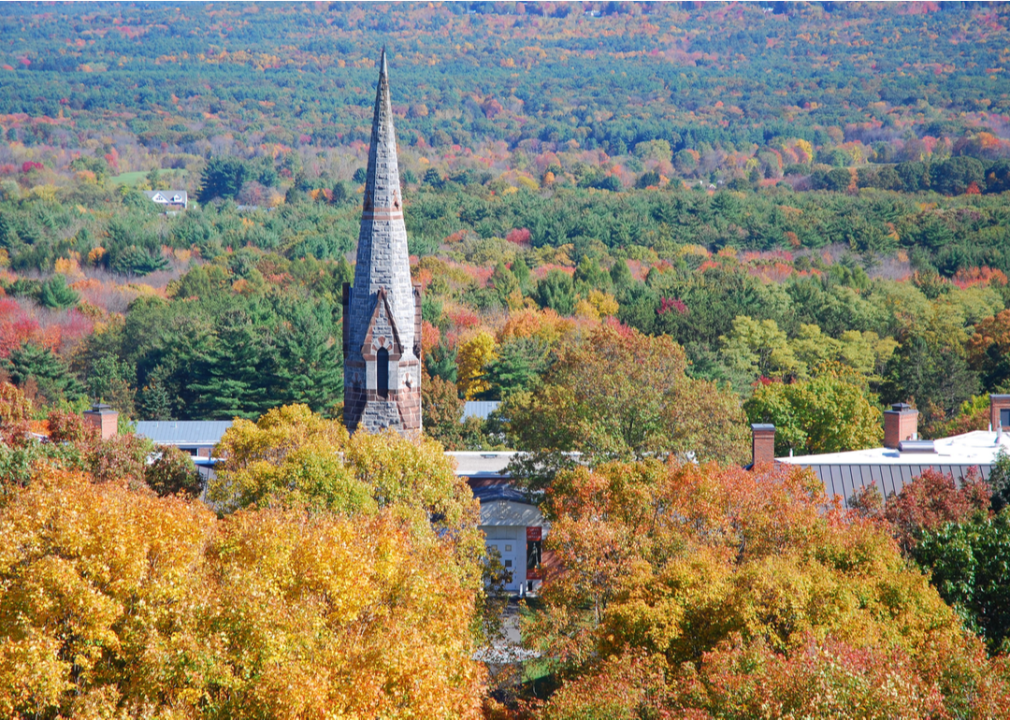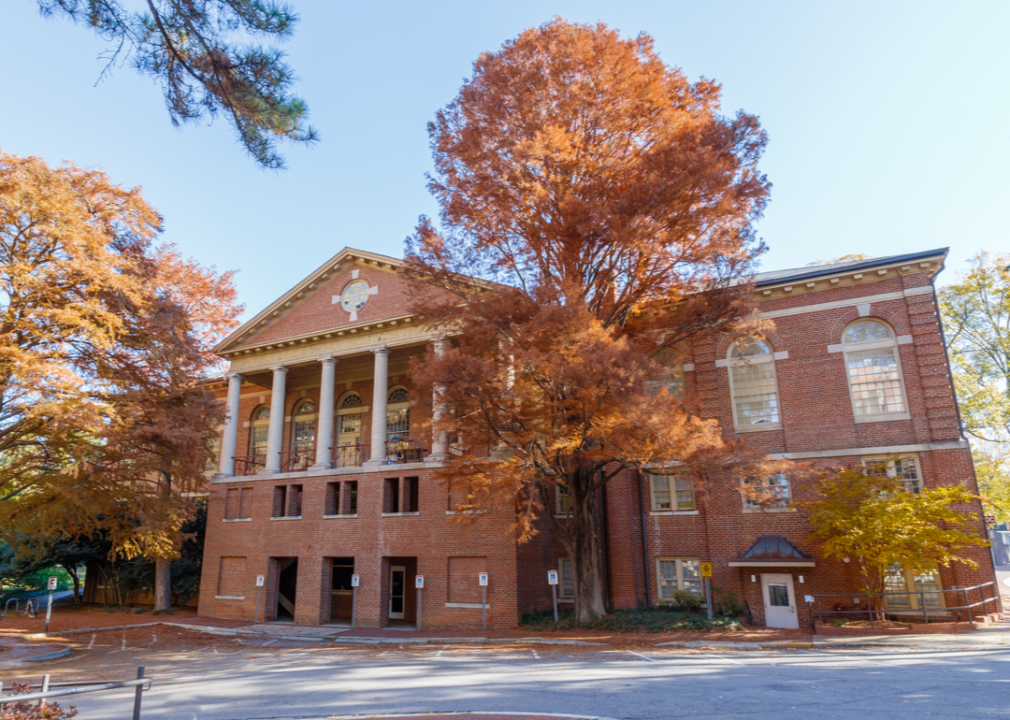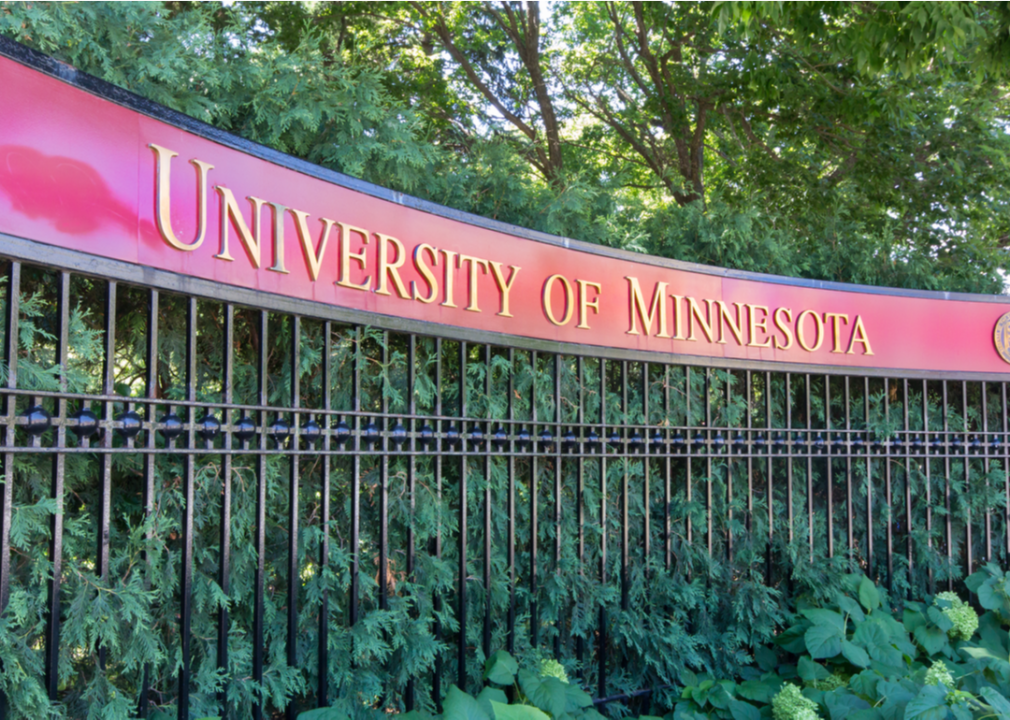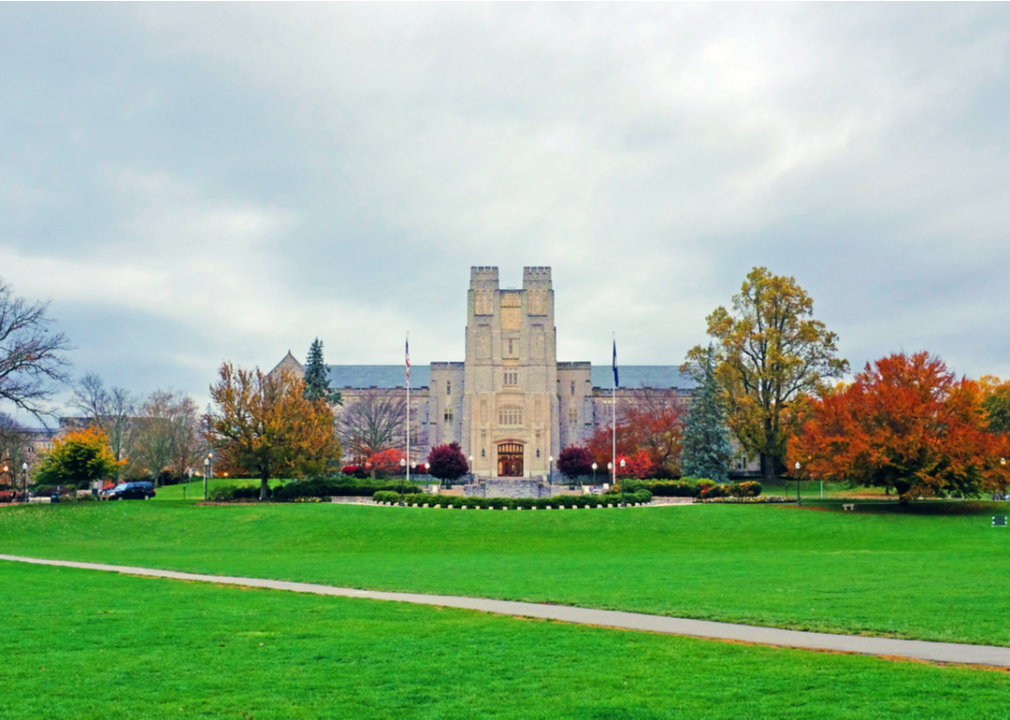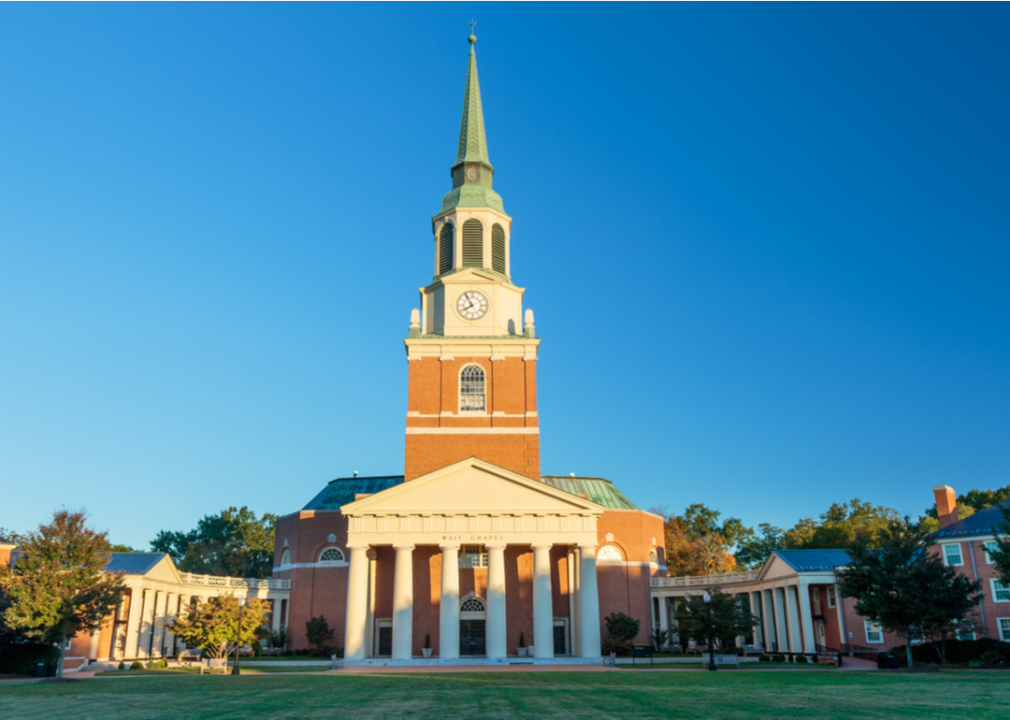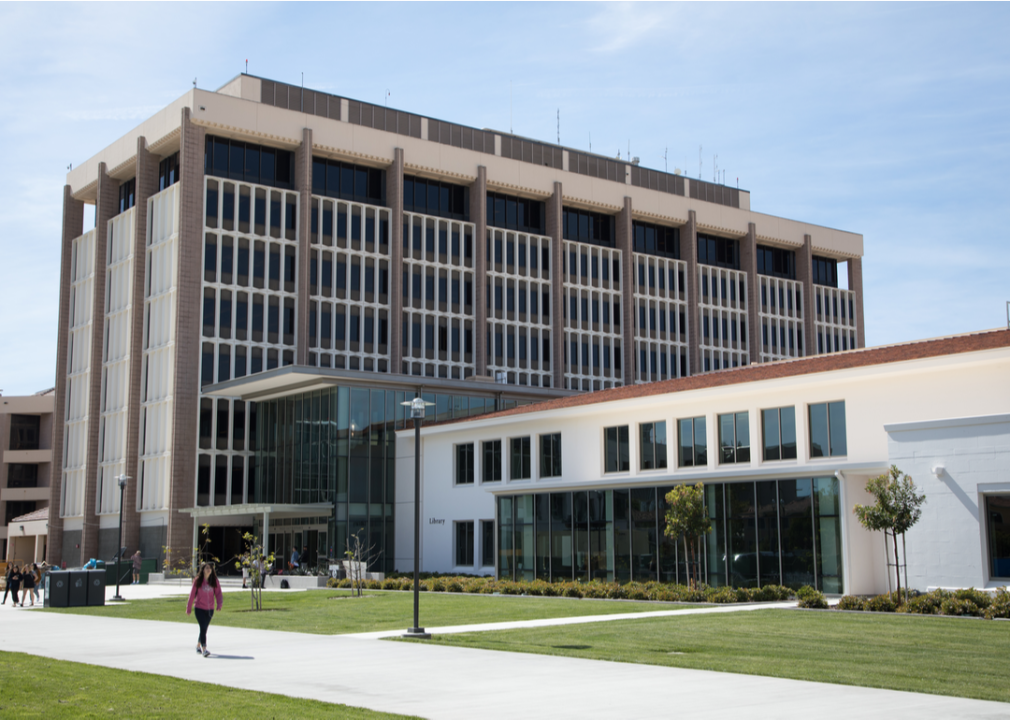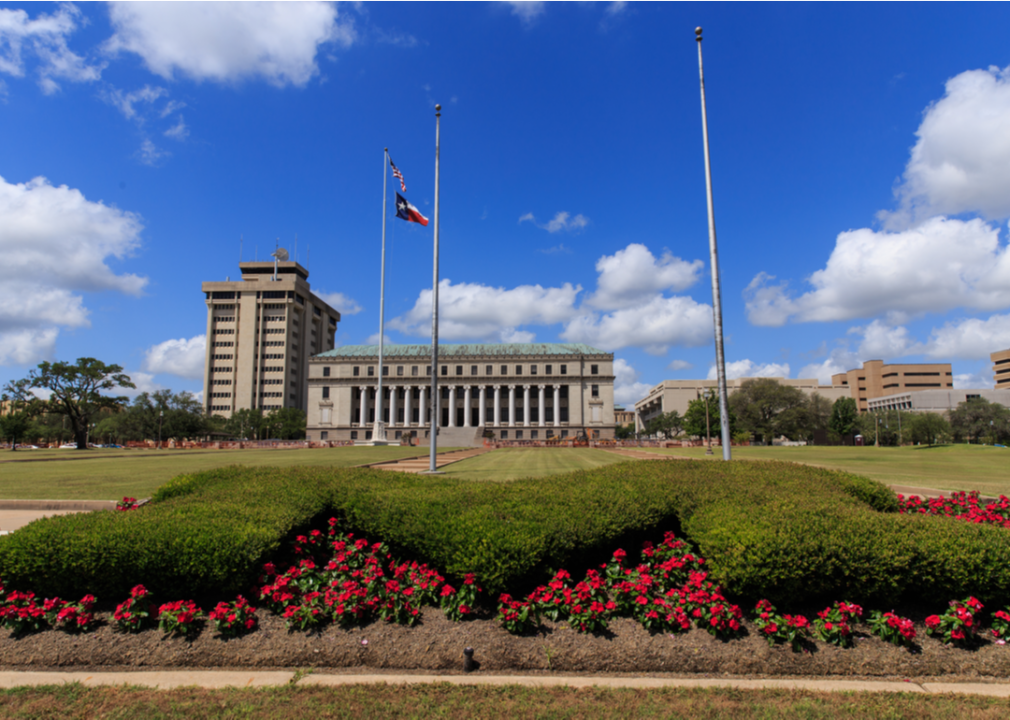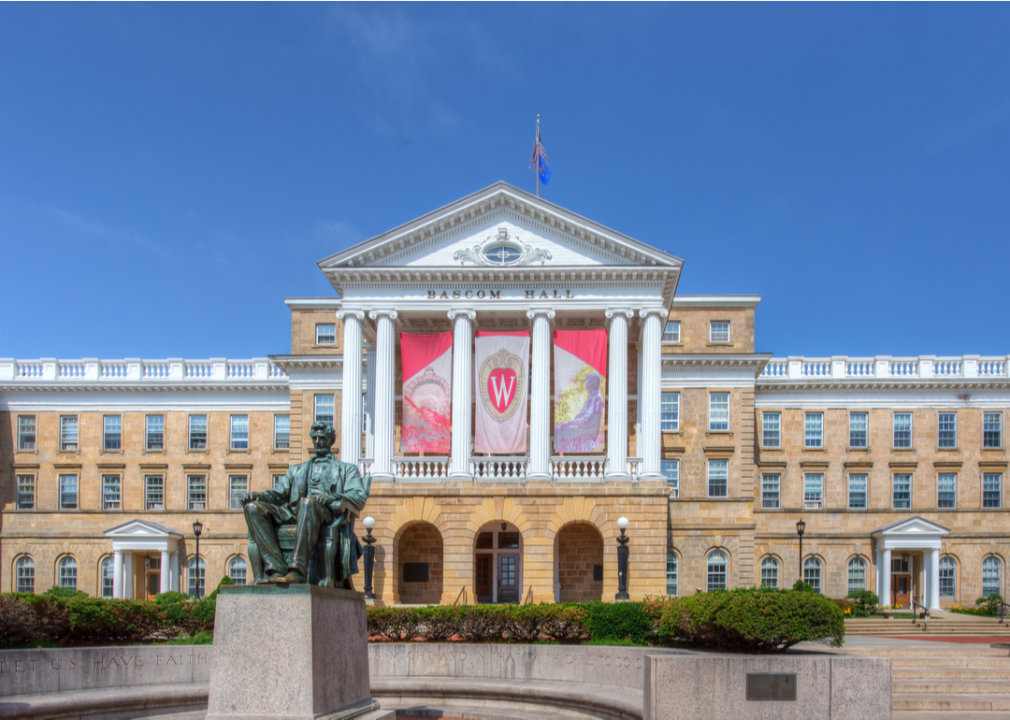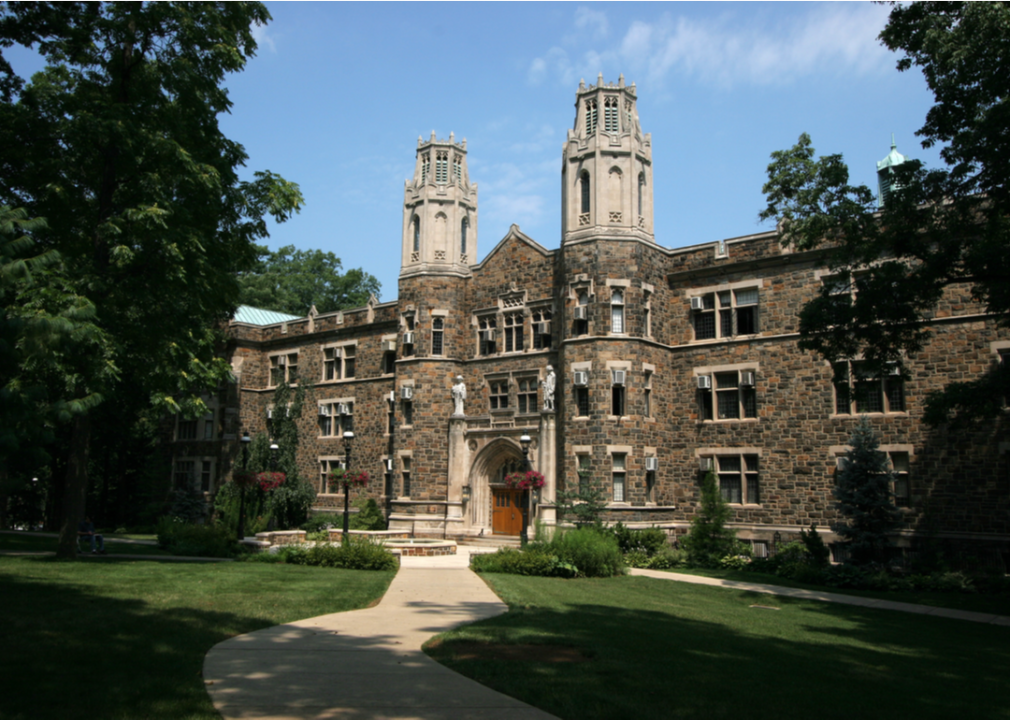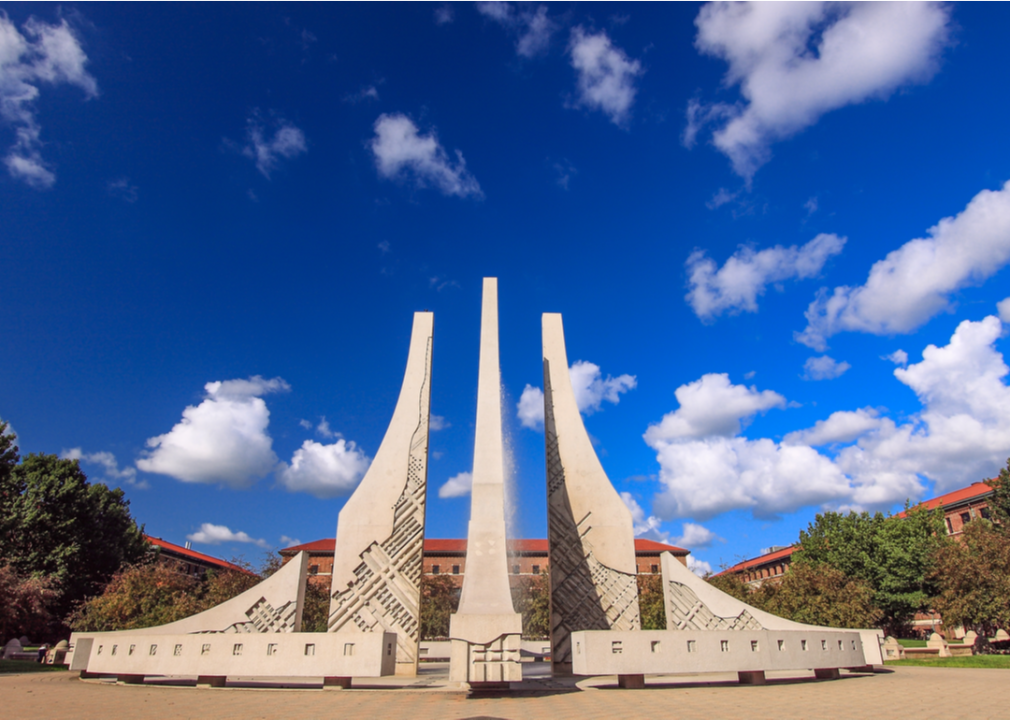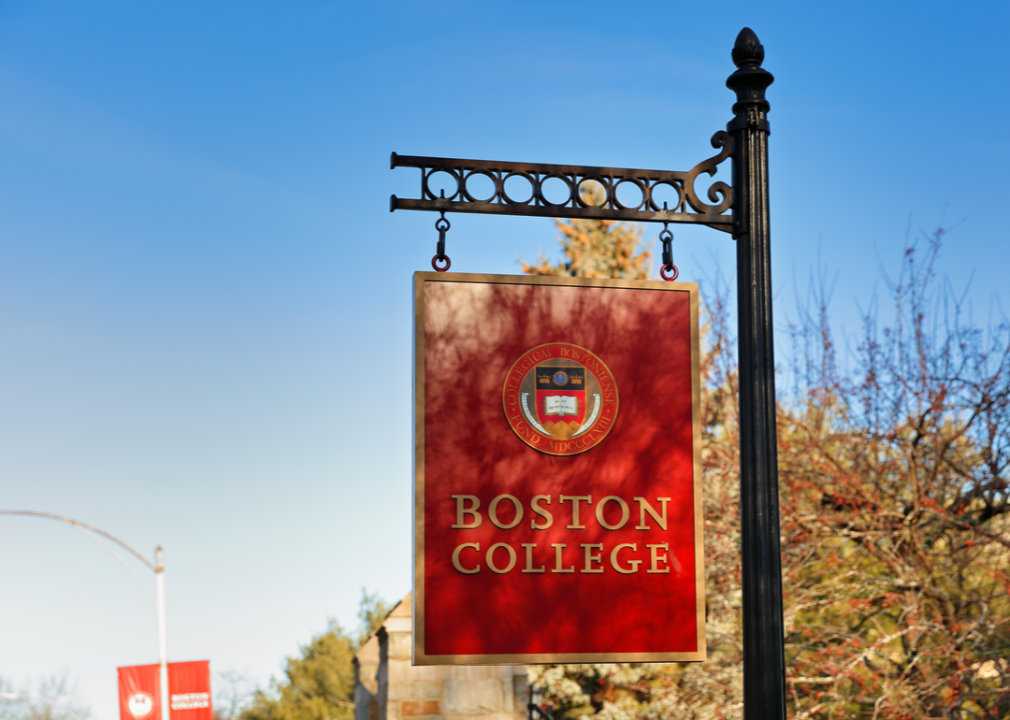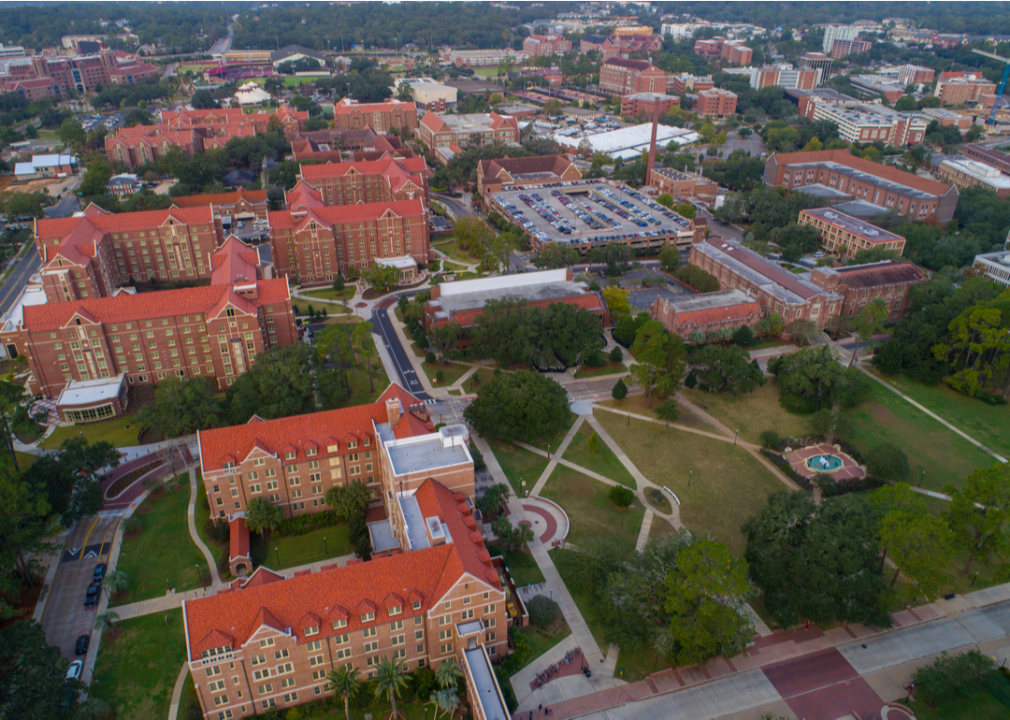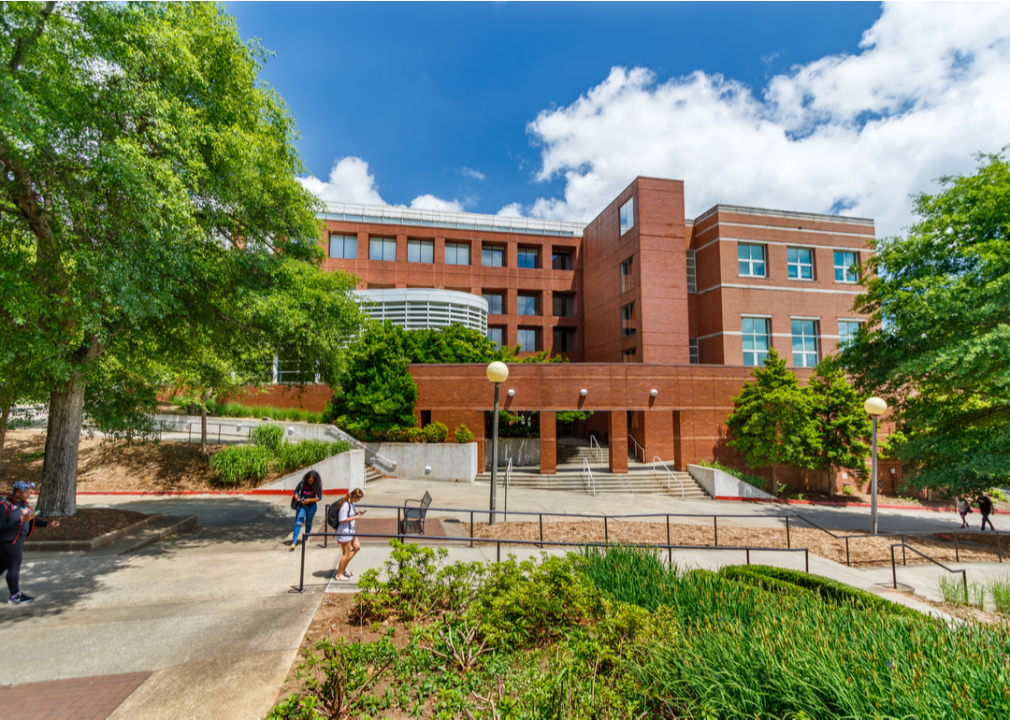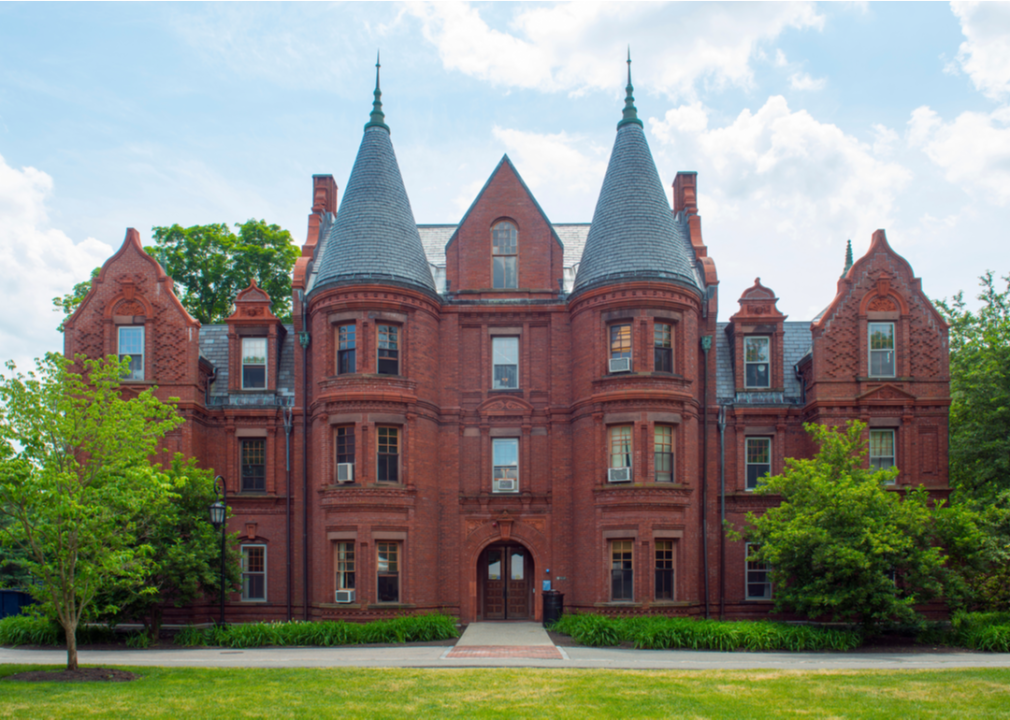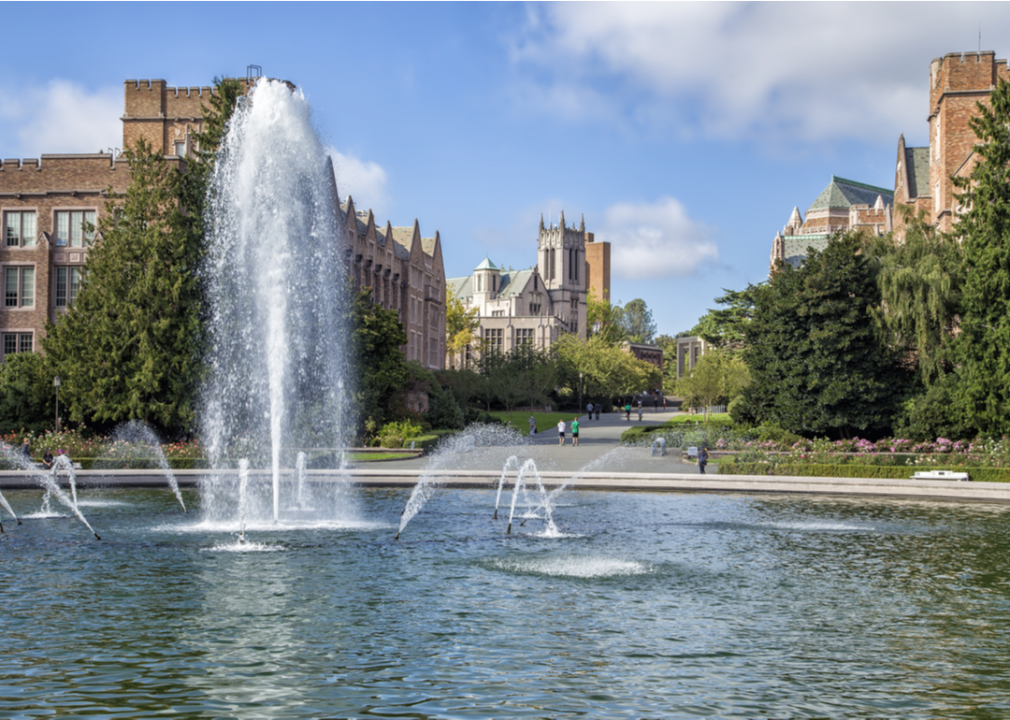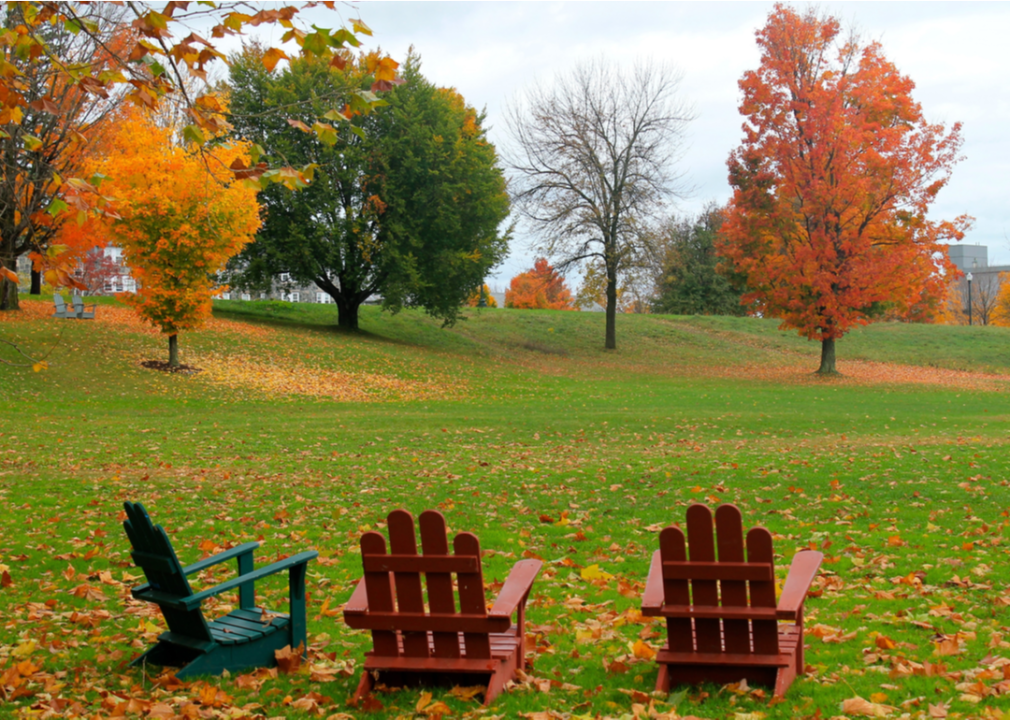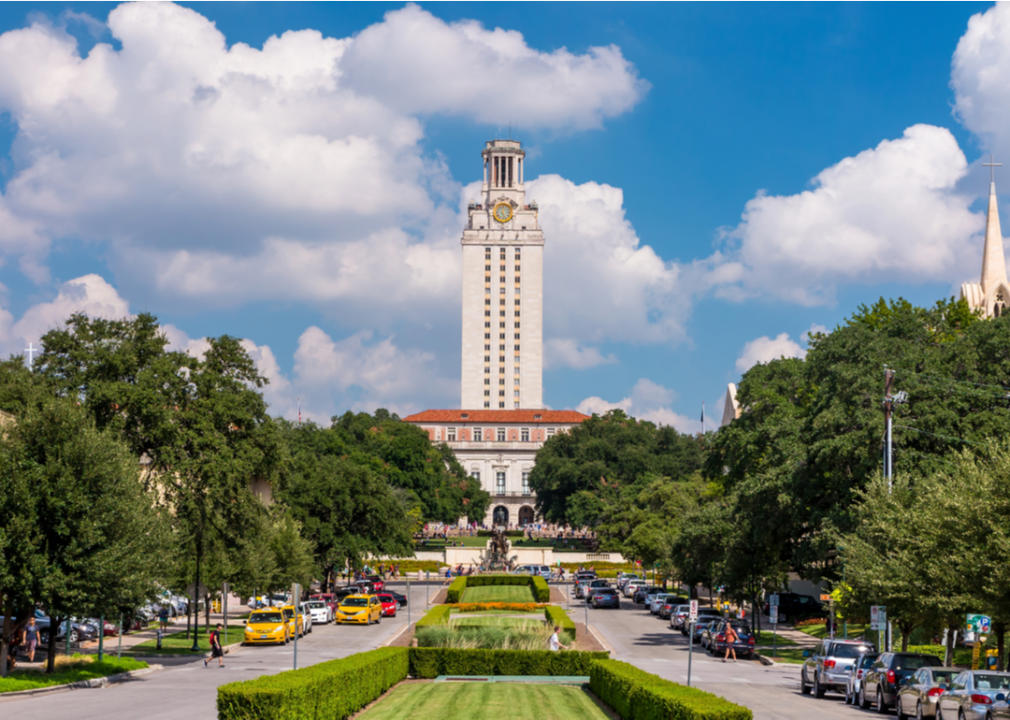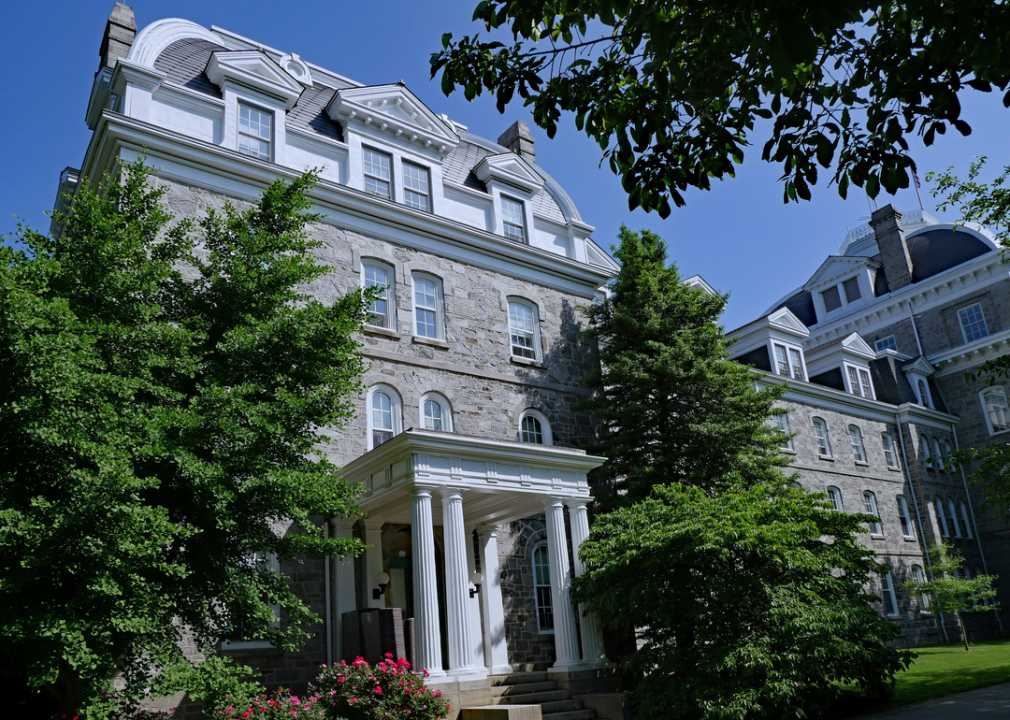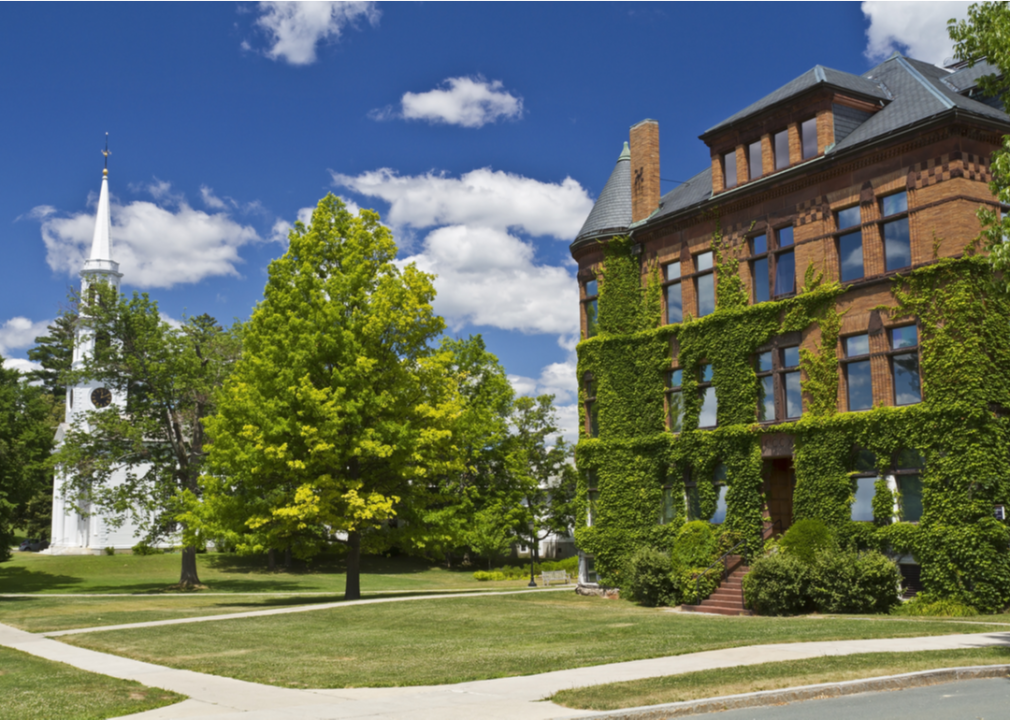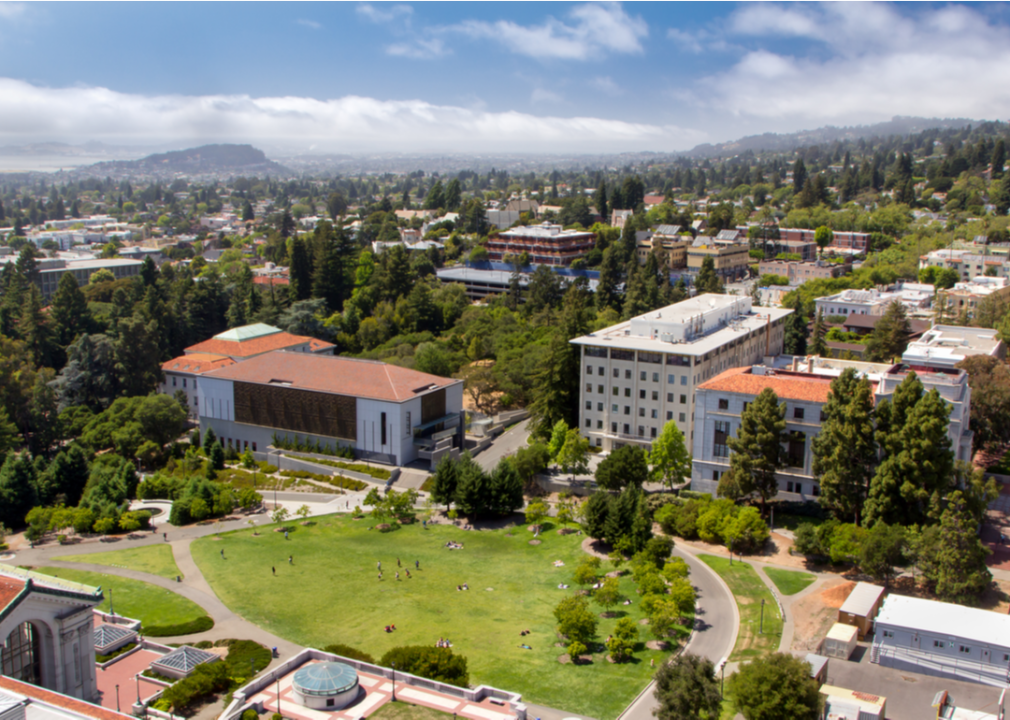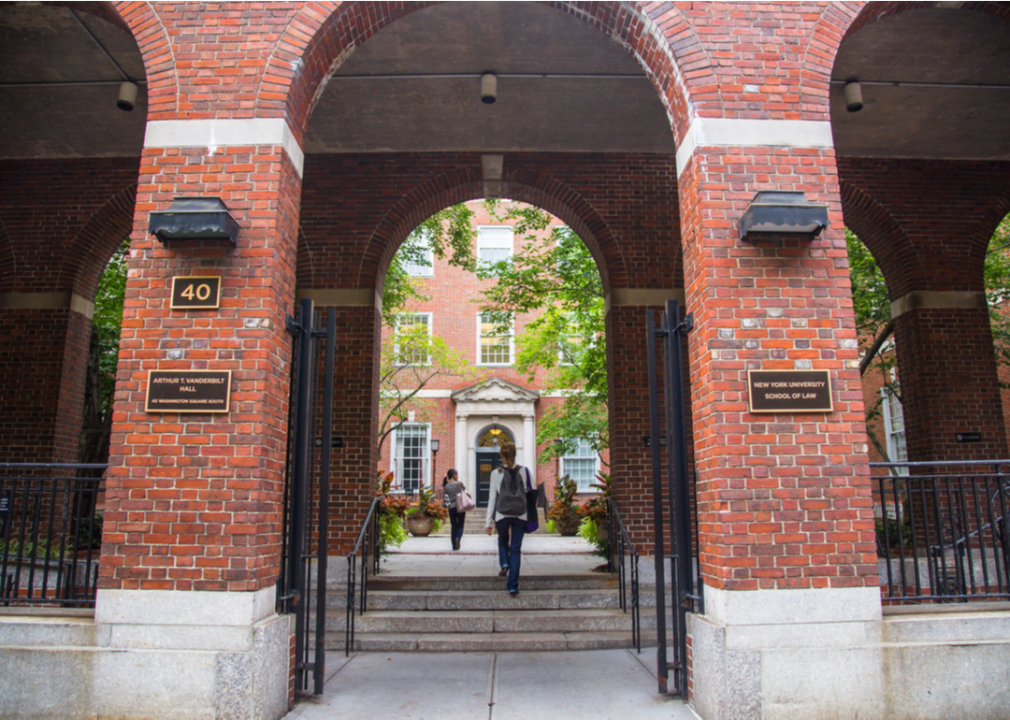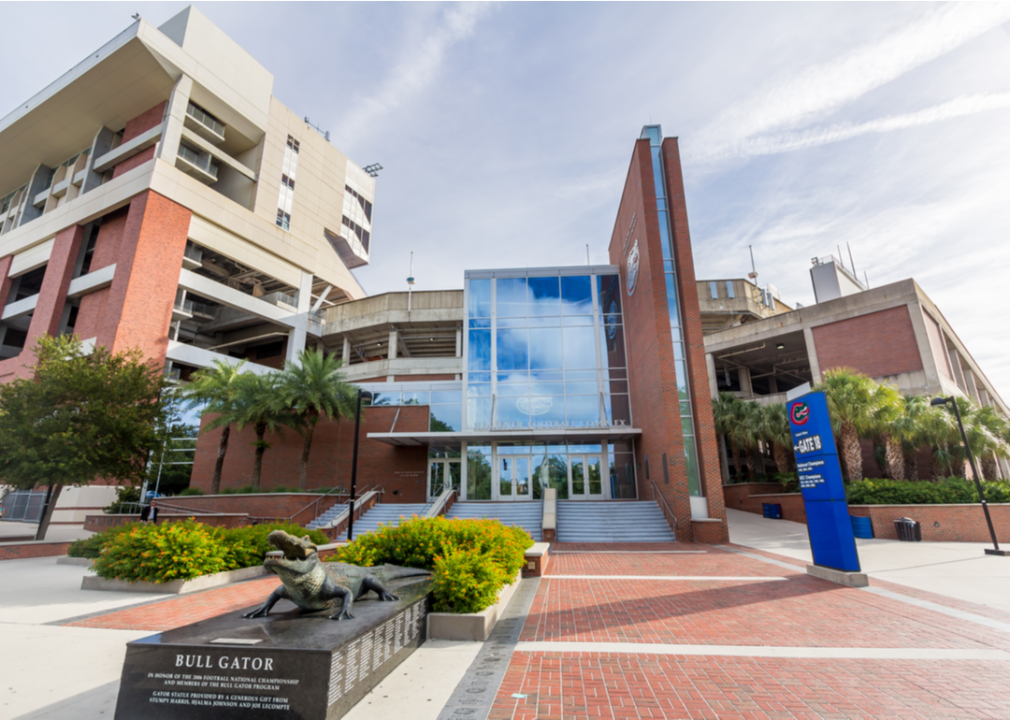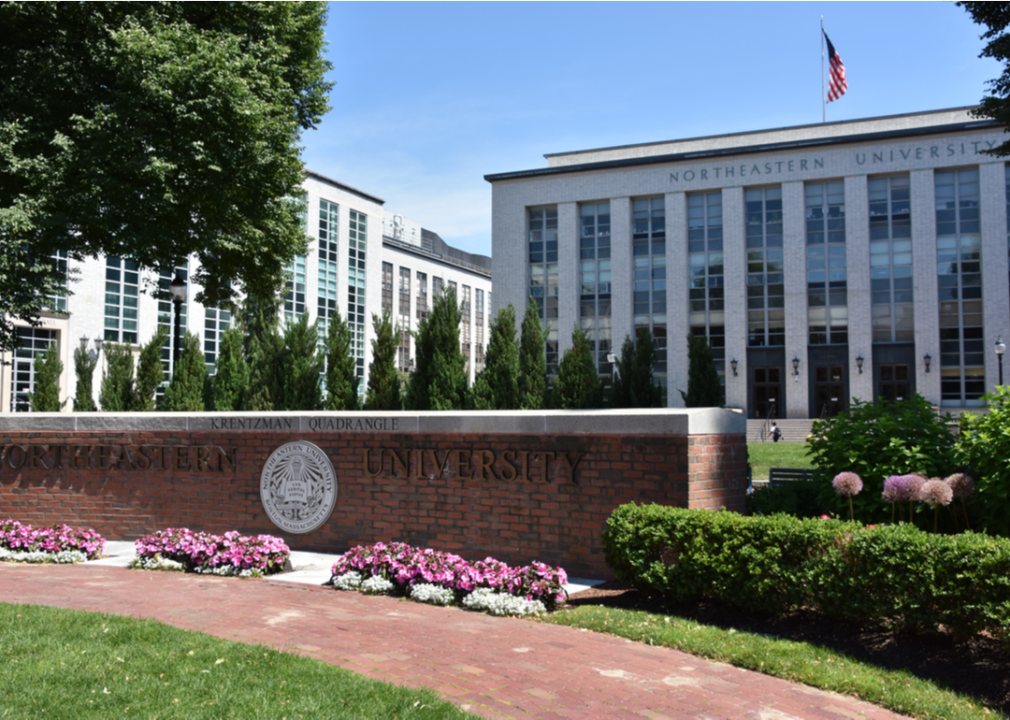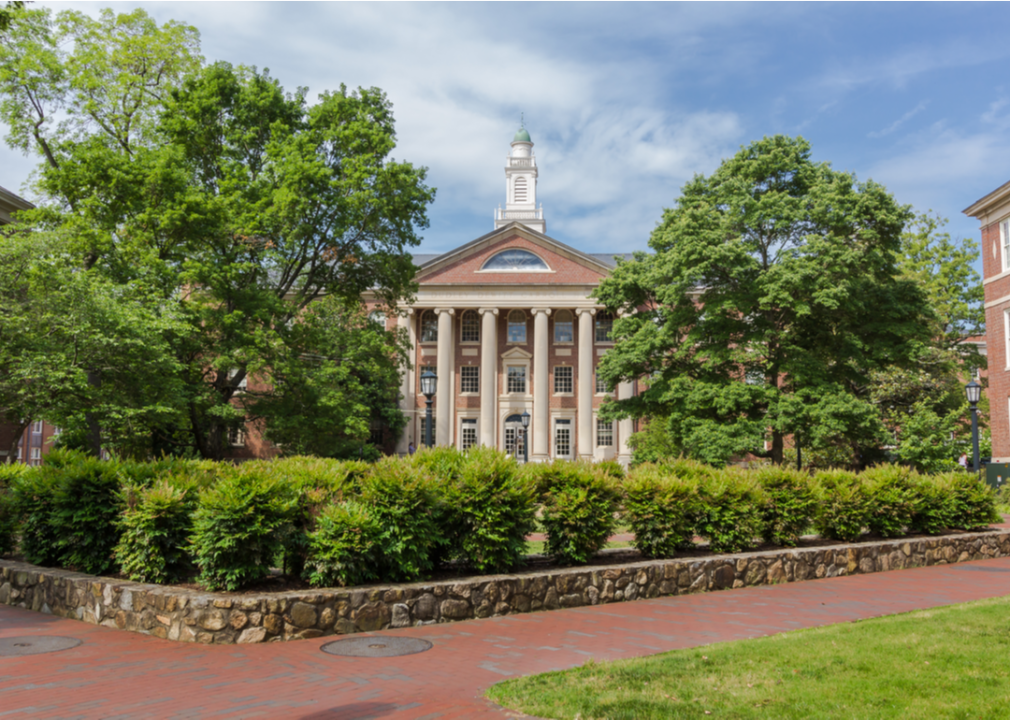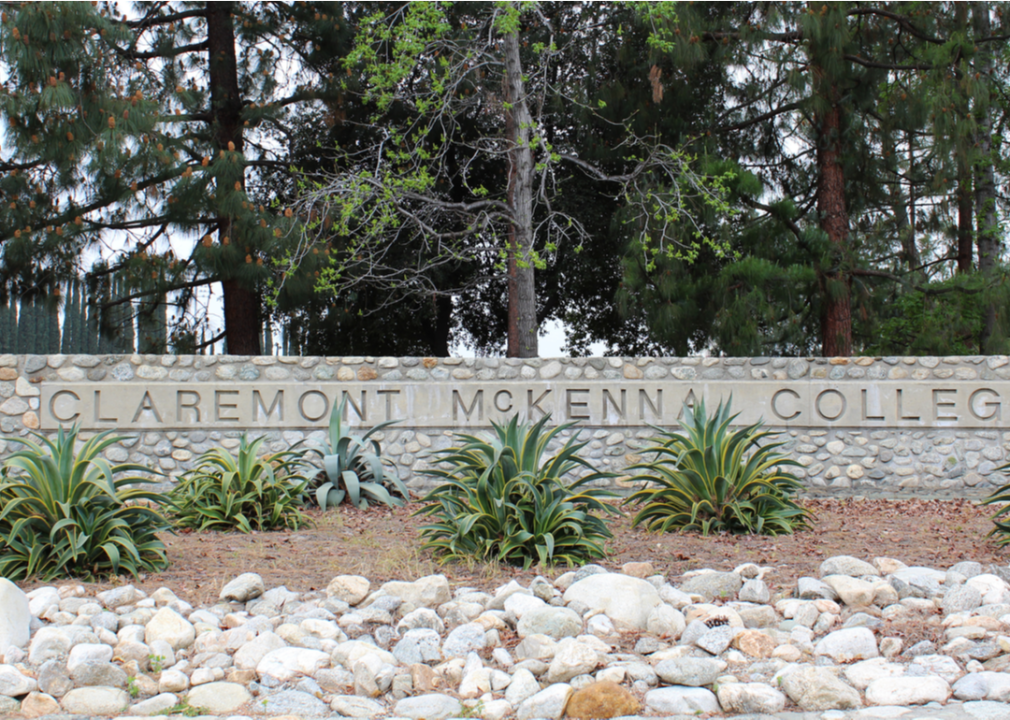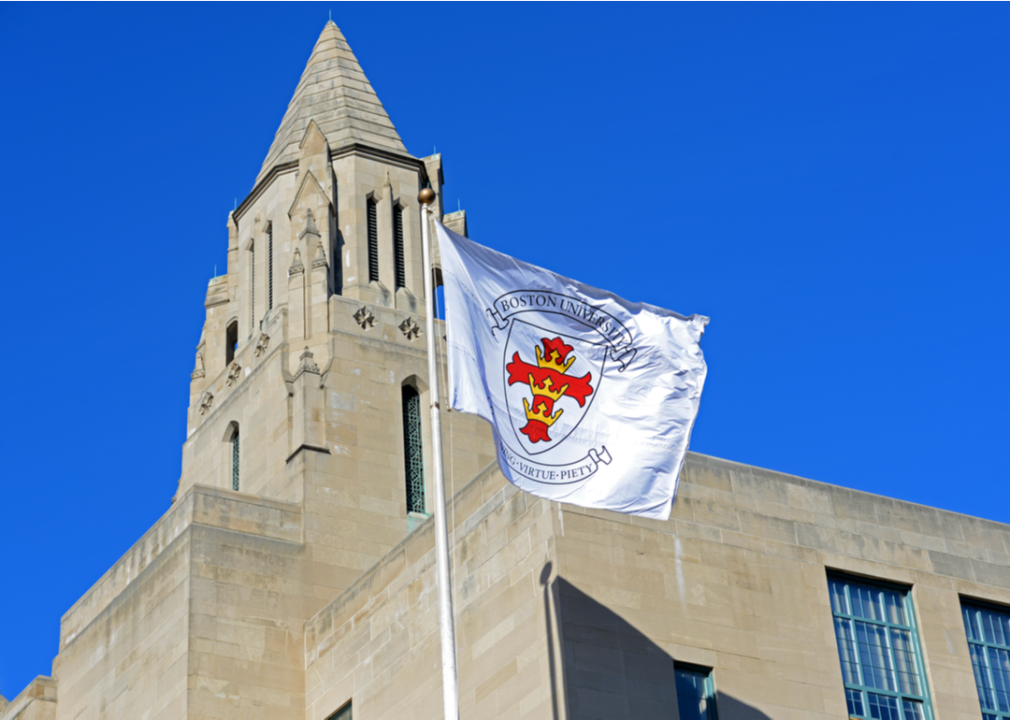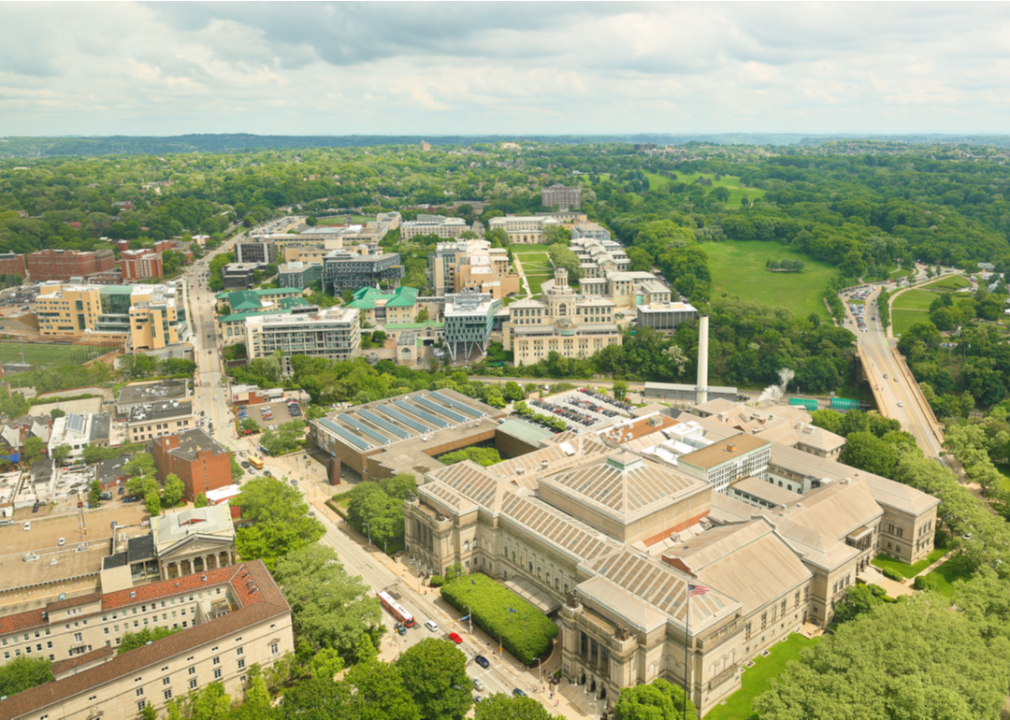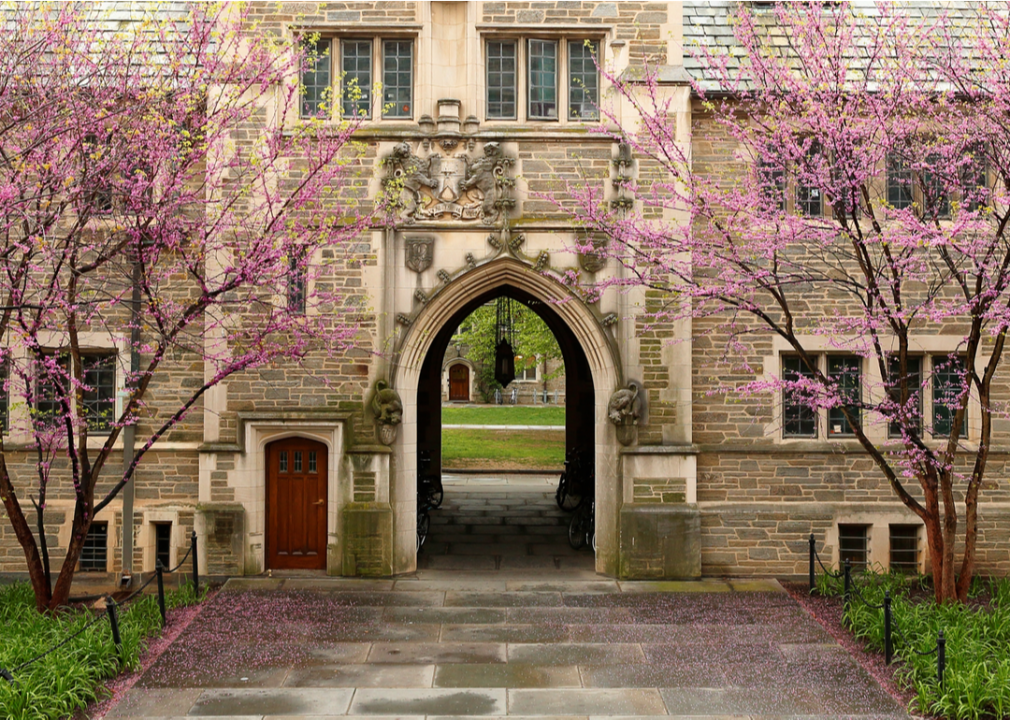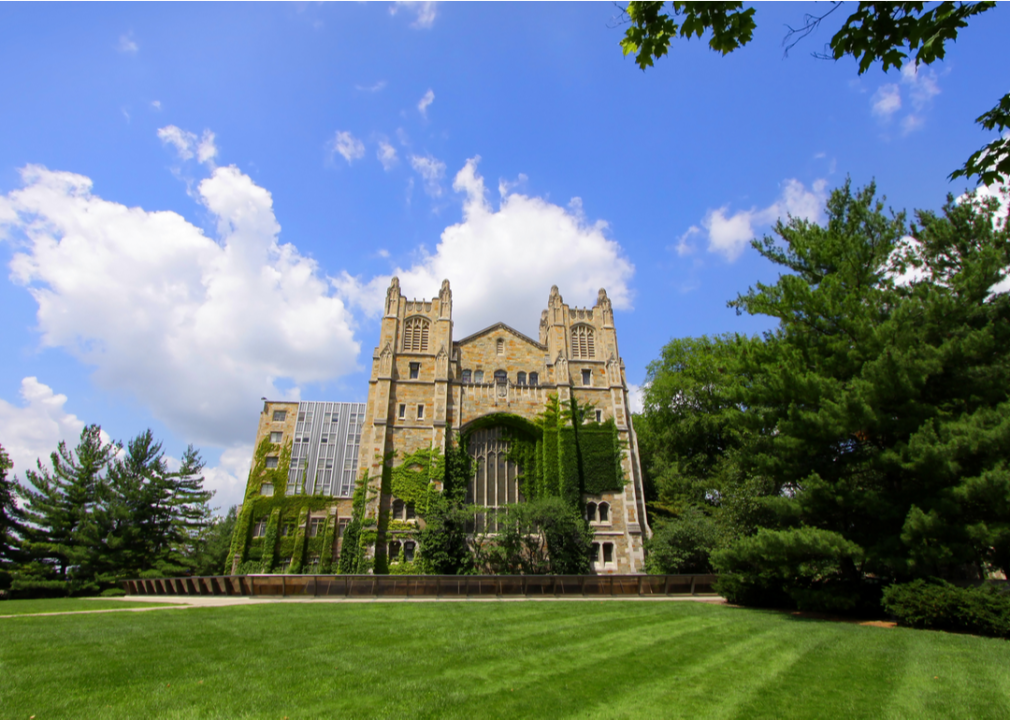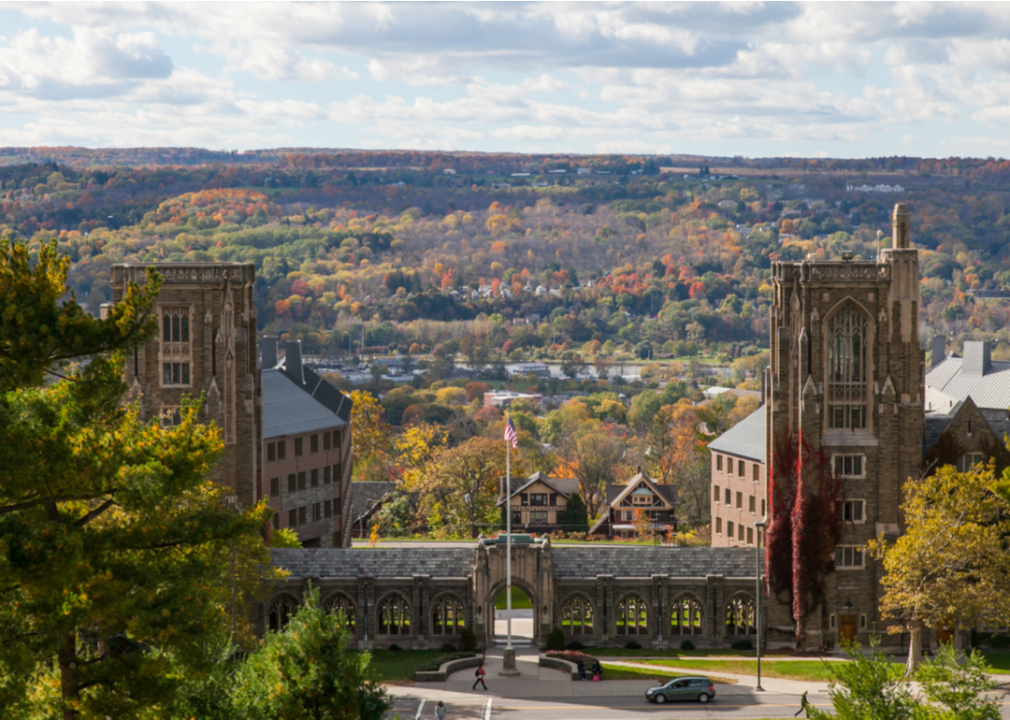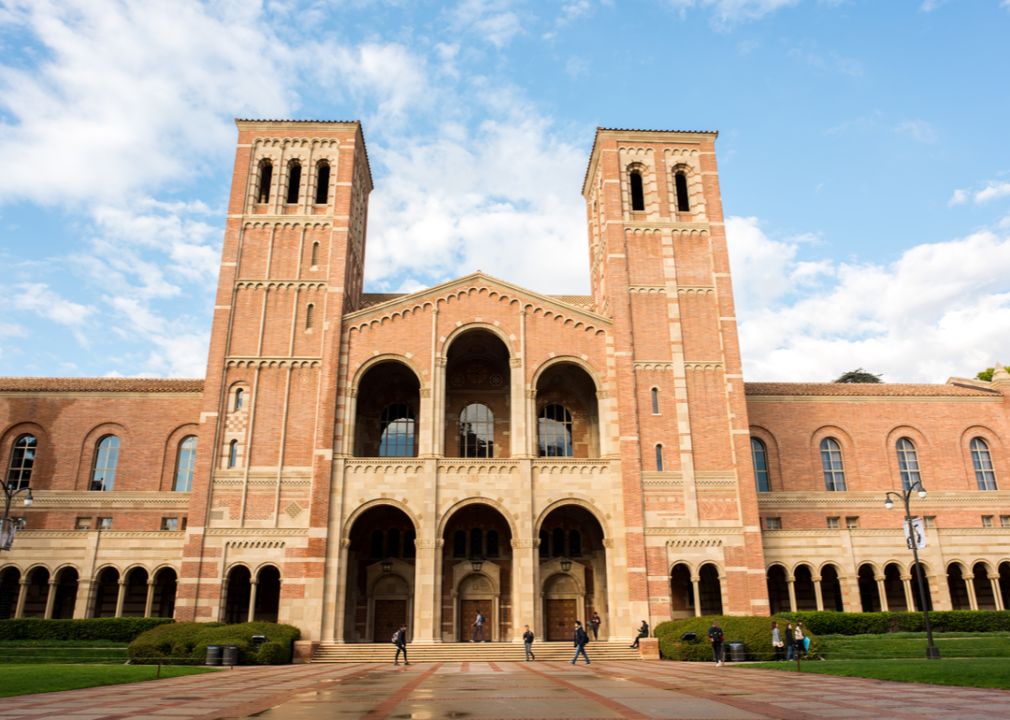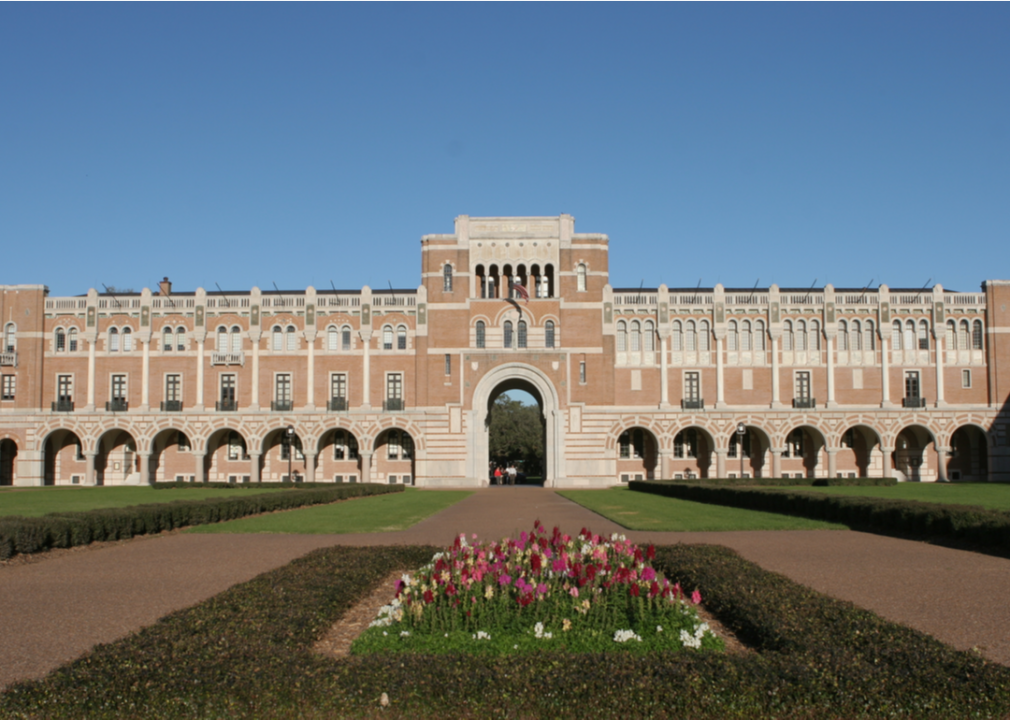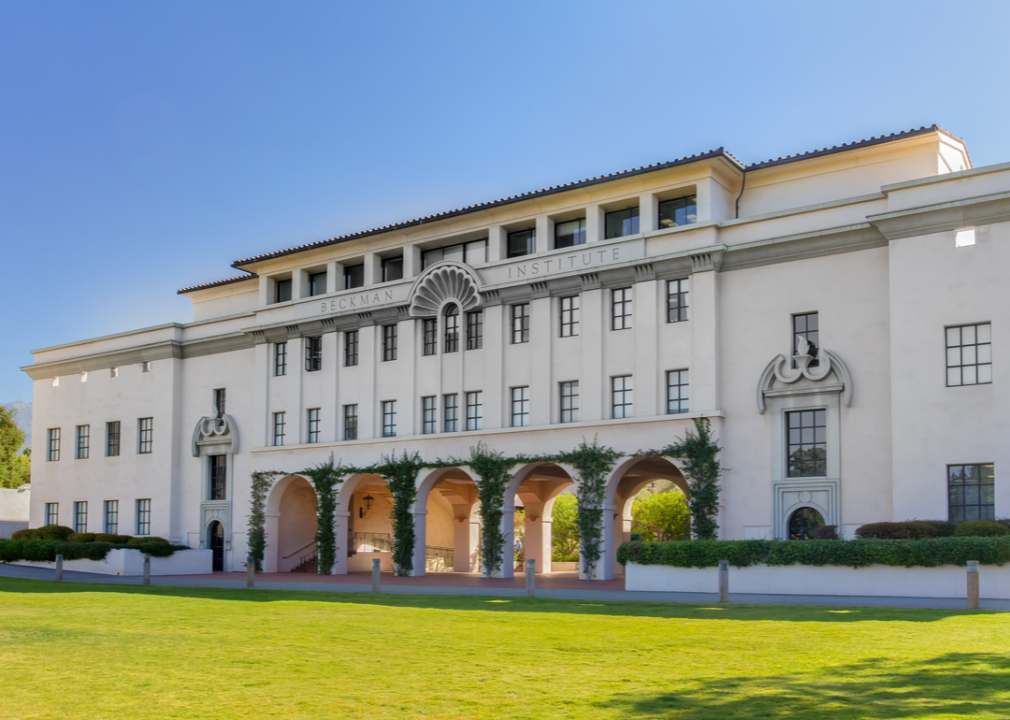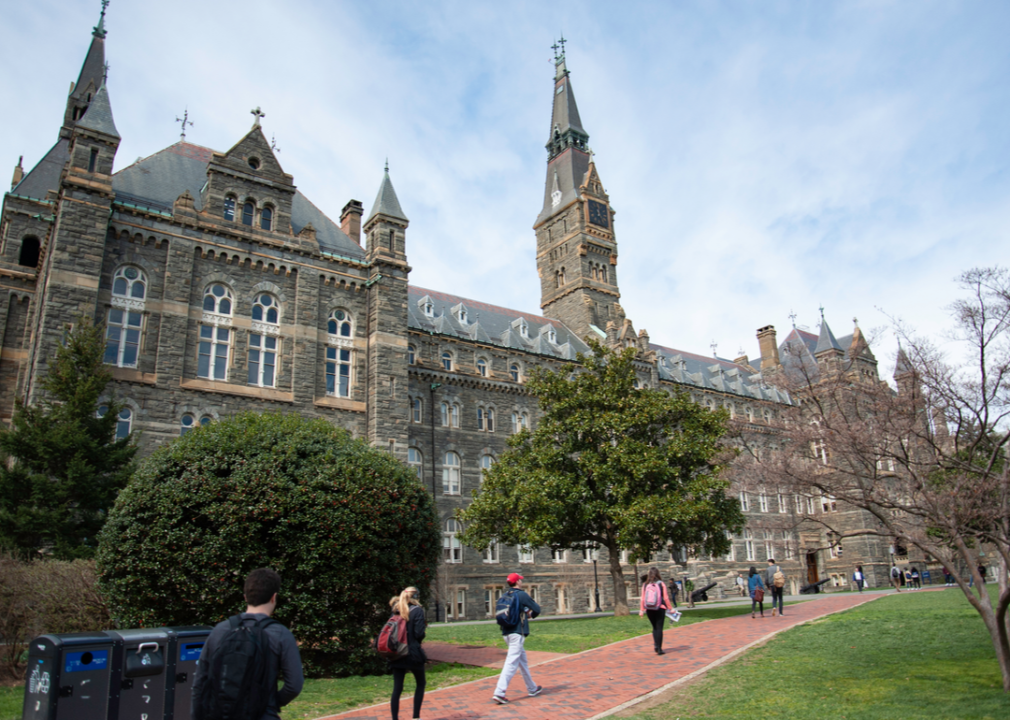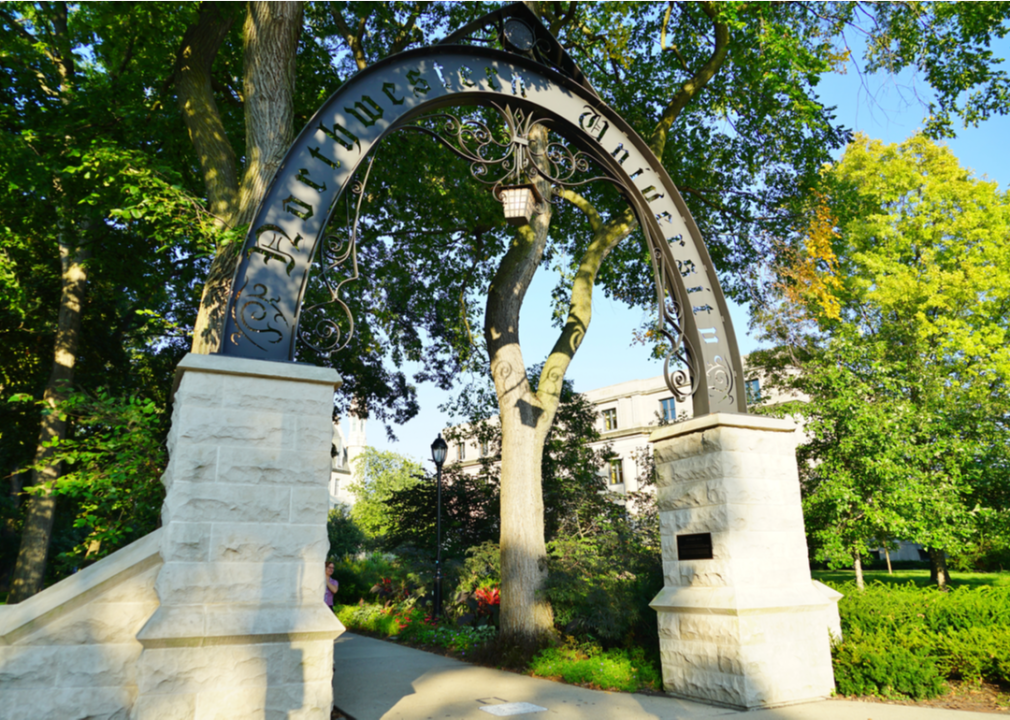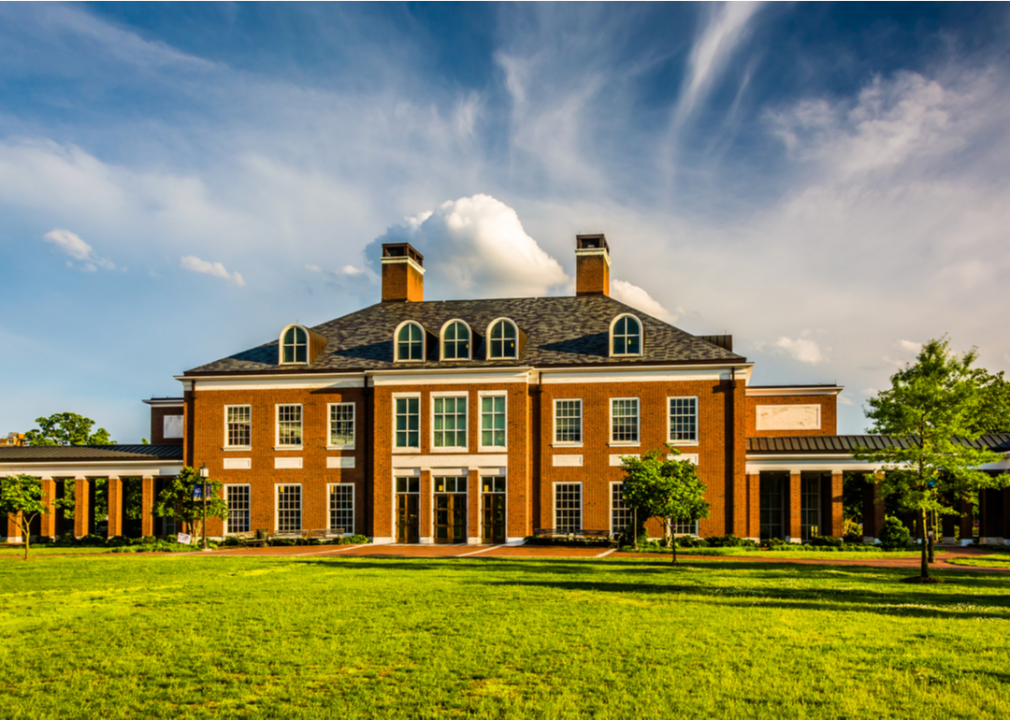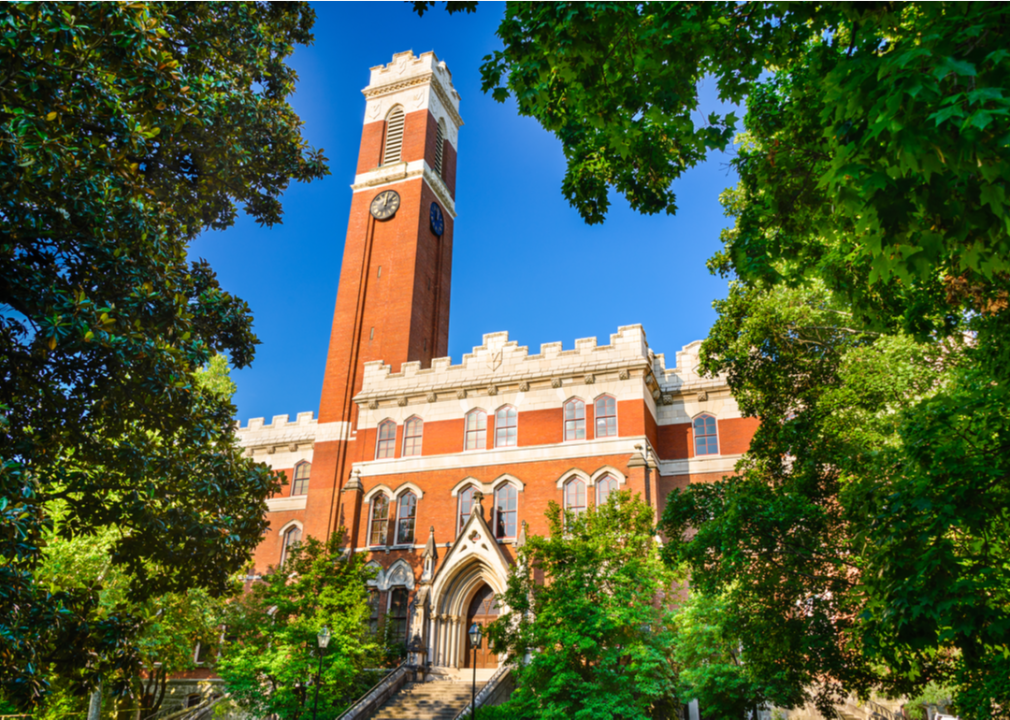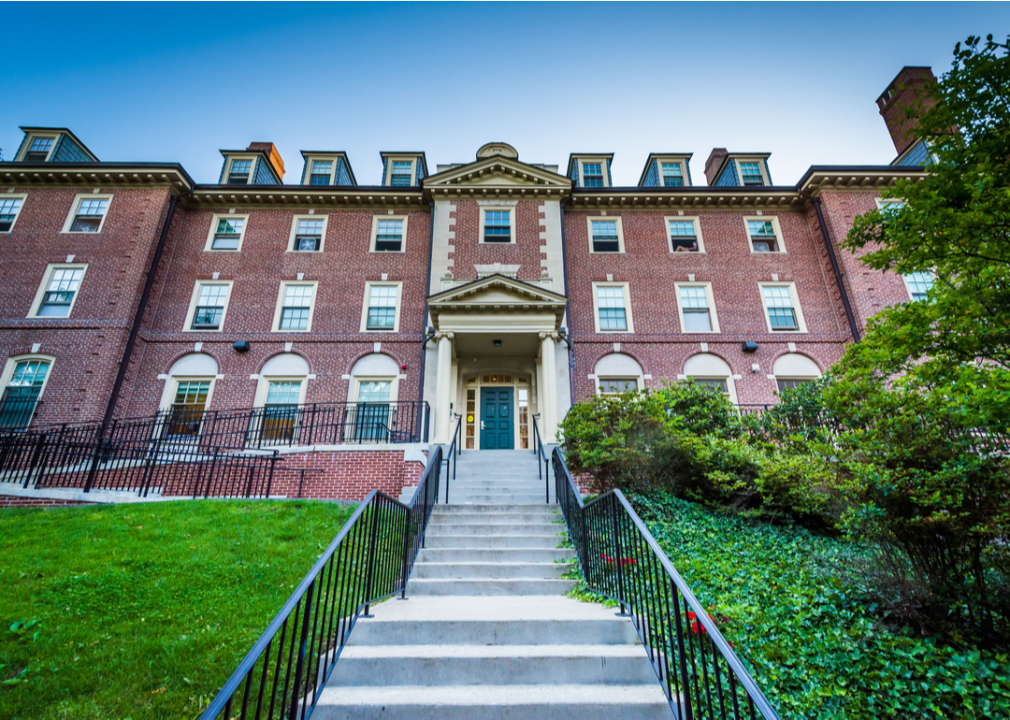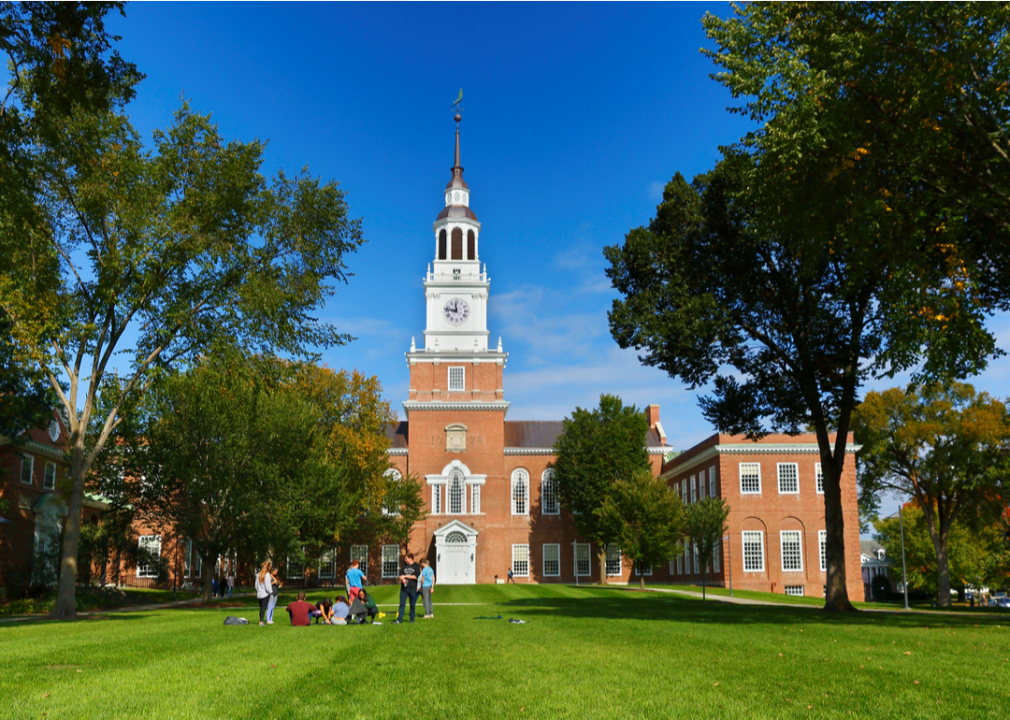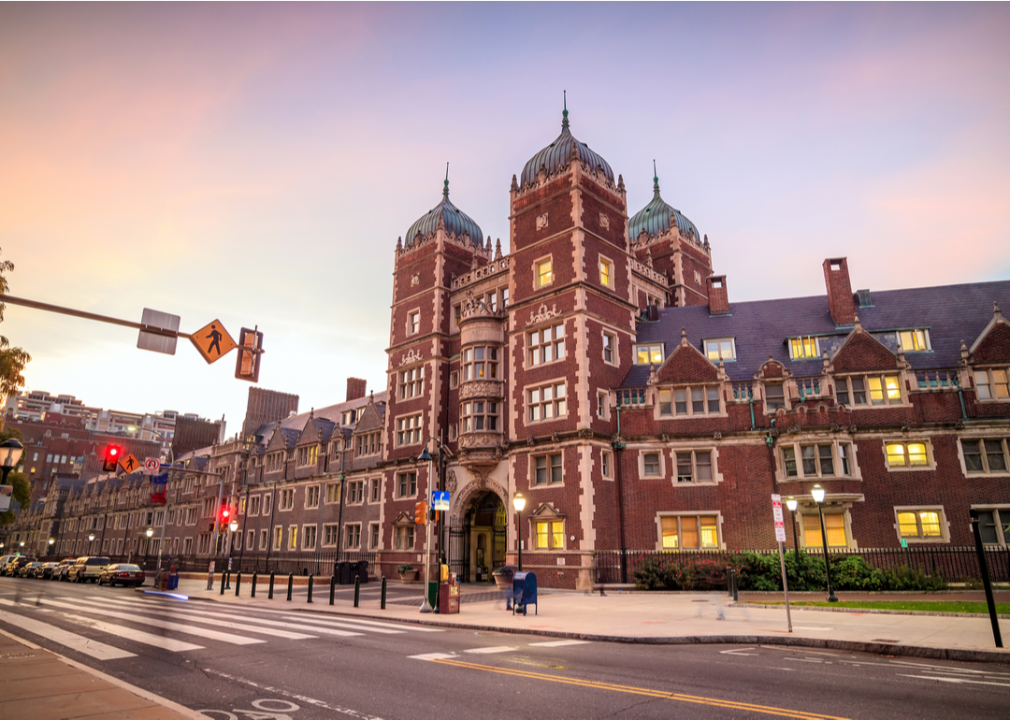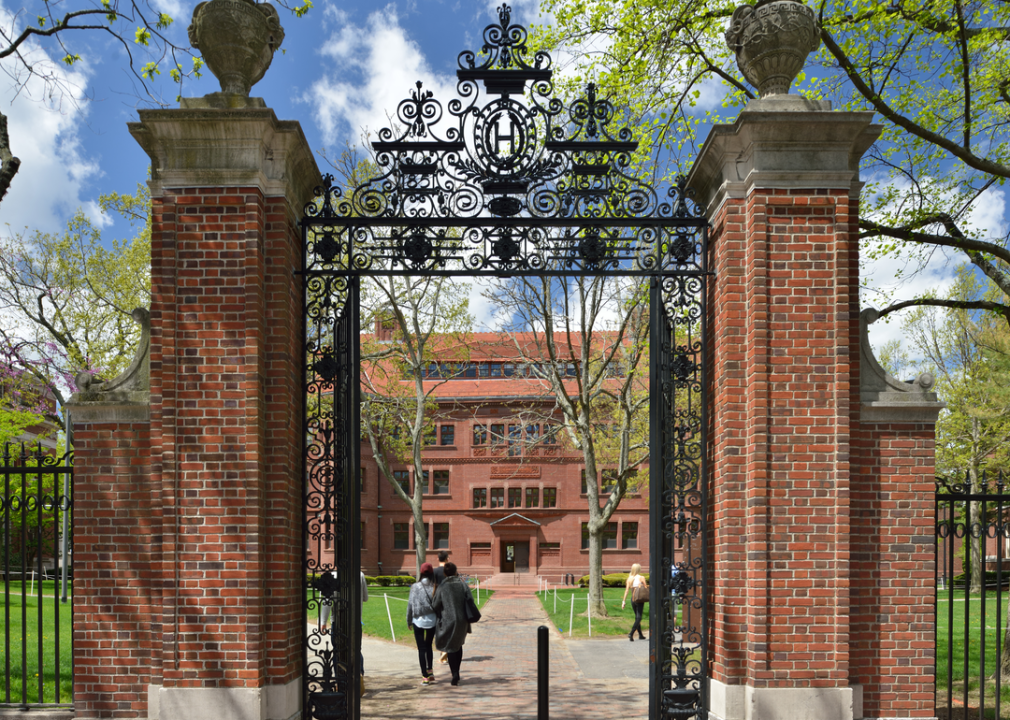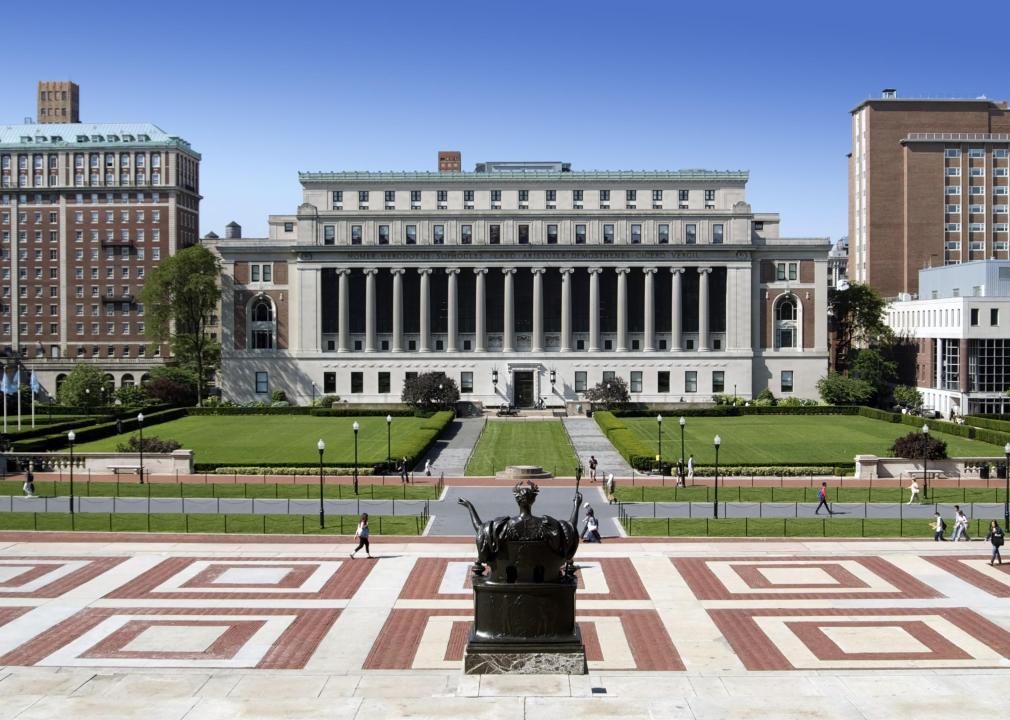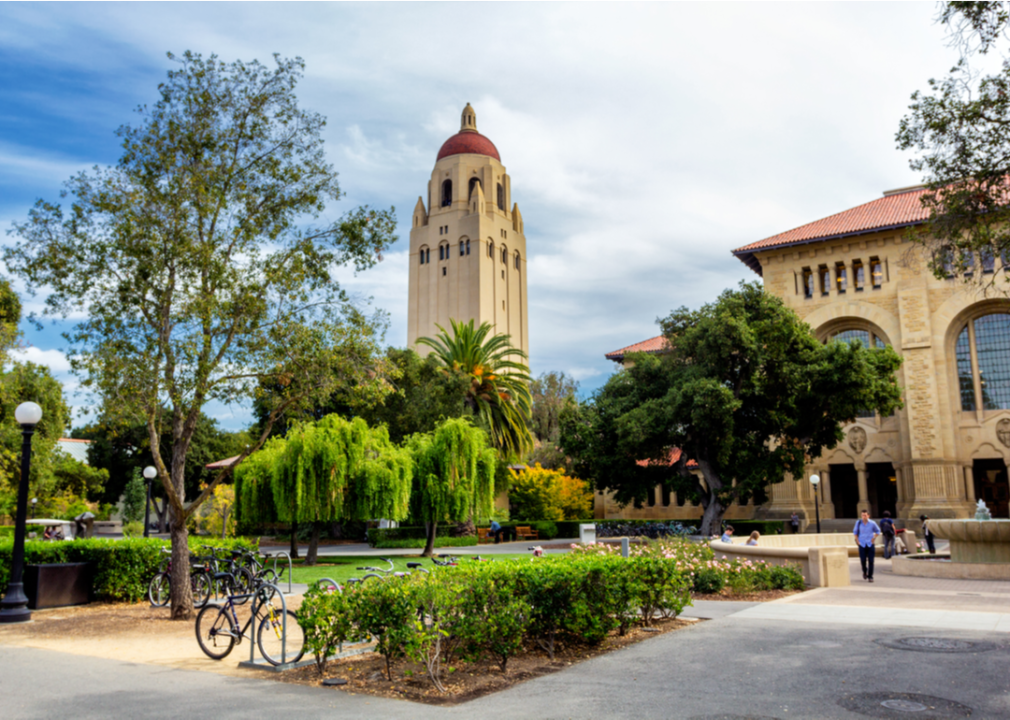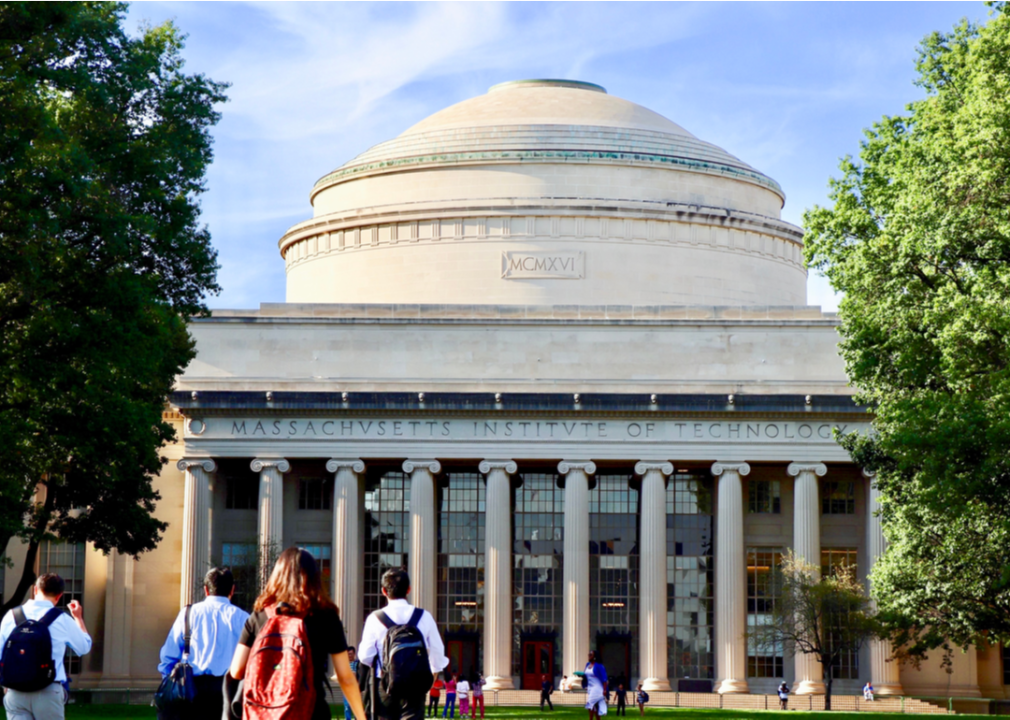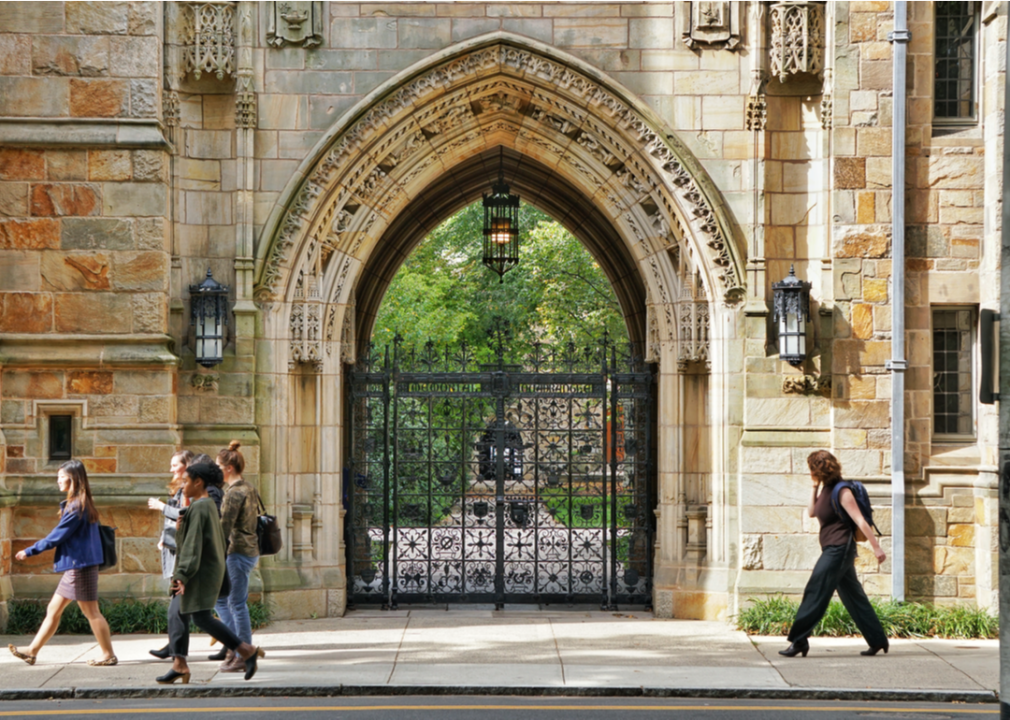Best colleges in America
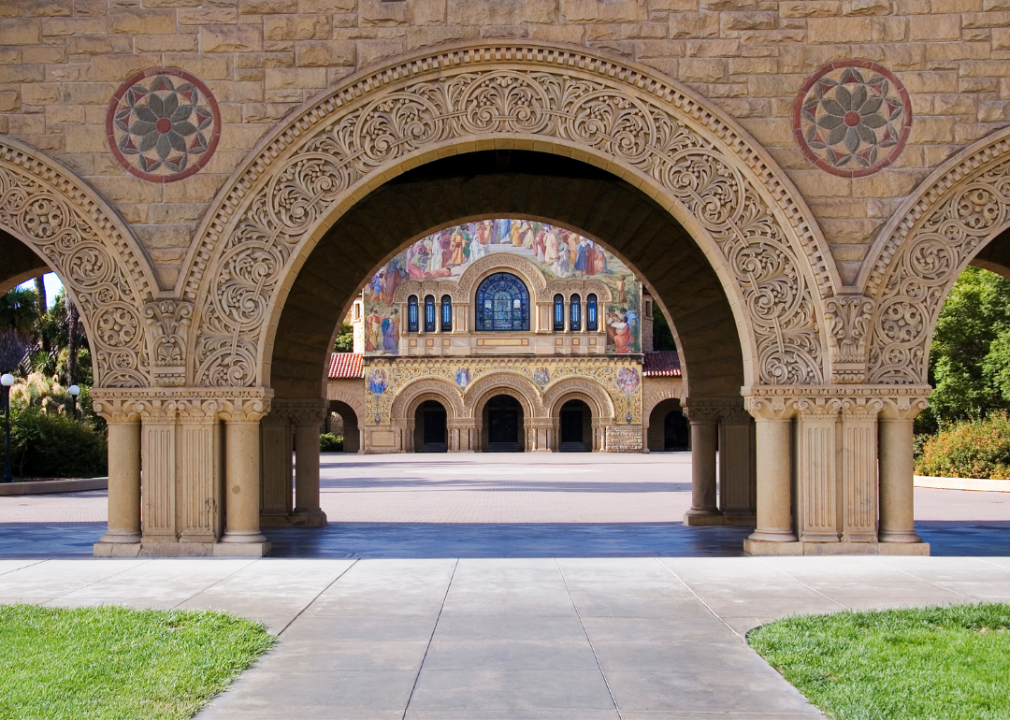
Canva
Best colleges in America
The main quad at Stanford University in California.
The 2024-25 school year has kicked off at colleges around the United States—and the number of students at campuses nationwide is growing. Undergraduate enrollment was up 2.5% in the spring, the second consecutive semester of growth, according to the National Student Clearinghouse Research Center.
As enrollment stabilizes following the coronavirus pandemic and more students pursue degrees than have in years, Stacker compiled a list of the best colleges in America using Niche’s 2025 rankings. All four-year schools in Niche’s database were considered. Niche ranks colleges using various factors, including academics, admissions, finances, and student life.
The list includes institutions public and private, from West Coast research colleges to East Coast liberal arts schools. There’s also a fair share of sprawling state schools as well as religion-centric universities.
These colleges offer pioneering programs in sciences, entrepreneurship, and even bagpipe performance. While some members of the list may be best known for athletic achievements, many so-called football schools are making rapid advancements in education, producing a number of Rhodes scholars and collaborating with tech industry giants. Of course, some have cool perks that few others do, including an on-campus ice cream factory or nuclear reactor.
While the Ivy League is considered the cream of the crop when it comes to American colleges, that’s not necessarily the case with this list. Keep reading to see which school grabbed the #1 spot.
You may also like: Preschool is popular, and more school districts are adding it
![]()
Bryan Pollard // Shutterstock
#100. University of South Carolina
South Carolina State House at the University of South Carolina.
– Location: Columbia, South Carolina
– Undergraduate enrollment: 27,389
– Student-to-faculty ratio: 14:1
– Acceptance rate: 64%
– Graduation rate: 78%
– Six-year median earnings: $44,900
– Two-year employment rate: 95%
The Columbia campus is the flagship of the University of South Carolina system and offers over 350 degrees. It holds particular sway with literature lovers, featuring a collection of more than 1,200 Ernest Hemingway works and an expansive store of Robert Burns pieces as well.
Amy Lutz // Shutterstock
#99. Drexel University
Drexel University entrance sign.
– Location: Philadelphia
– Undergraduate enrollment: 12,505
– Student-to-faculty ratio: 8:1
– Acceptance rate: 80%
– Graduation rate: 78%
– Six-year median earnings: $68,800
– Two-year employment rate: 94%
Drexel University was founded in 1891 as the Drexel Institute of Art, Science and Industry. In 1983, it was the first university in the U.S. to require students to use personal computers, available to them through an innovative partnership with a major computer manufacturer. Undergraduates can take advantage of the school’s co-op program, which allows them to gain up to 18 months of full-time, paid work experience.
Jacob Boomsma // Shutterstock
#98. Auburn University
Aerial view of the town and University of Auburn.
– Location: Auburn, Alabama
– Undergraduate enrollment: 24,135
– Student-to-faculty ratio: 16:1
– Acceptance rate: 44%
– Graduation rate: 81%
– Six-year median earnings: $48,800
– Two-year employment rate: 95%
Auburn University is an institution entrenched in history. After opening its doors in 1856, the school closed during the Civil War to serve as a hospital. It became the first land-grant university in the South and today is a world-class institution across the sciences, arts, and other disciplines.
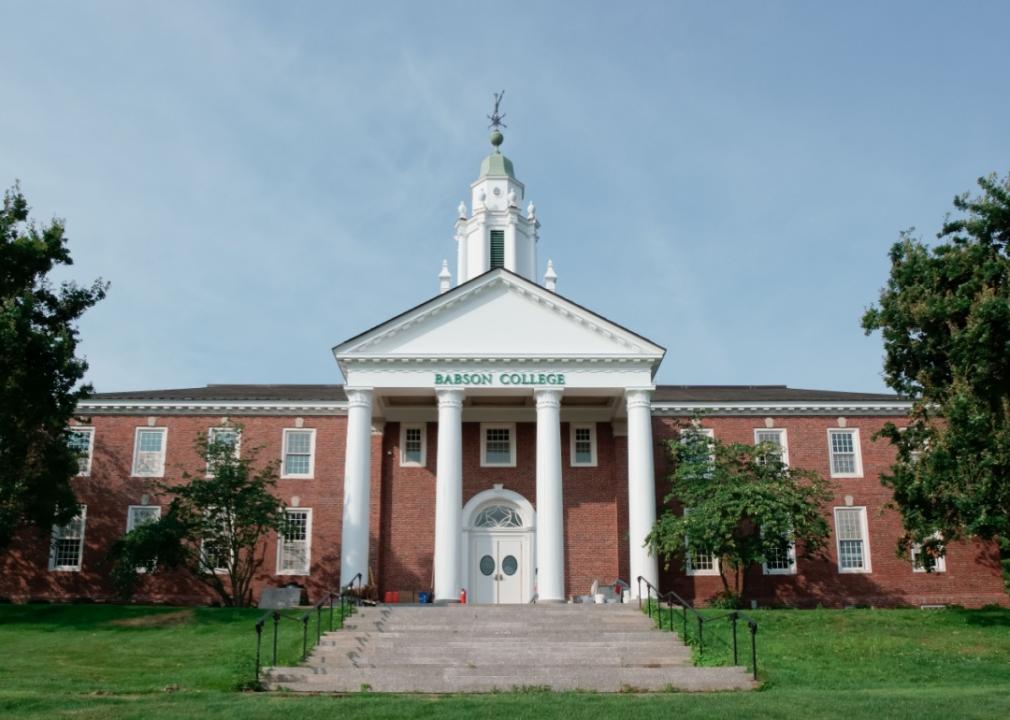
Yingna Cai // Shutterstock
#97. Babson College
An exterior view of Babson College.
– Location: Wellesley, Massachusetts
– Undergraduate enrollment: 2,737
– Student-to-faculty ratio: 12:1
– Acceptance rate: 22%
– Graduation rate: 93%
– Six-year median earnings: $96,100
– Two-year employment rate: 91%
Babson College is big on entrepreneurship. The school offers programs specializing in women’s entrepreneurial leadership, family entrepreneurship, and retail supply chain management. Babson has also expanded to Miami and San Francisco.
JHVEPhoto // Shutterstock
#96. University of Utah
University of Utah sign with Rice-Eccles Stadium.
– Location: Salt Lake City
– Undergraduate enrollment: 21,291
– Student-to-faculty ratio: 9:1
– Acceptance rate: 89%
– Graduation rate: 65%
– Six-year median earnings: $53,000
– Two-year employment rate: 90%
The University of Utah was commissioned in 1850 when the newly arrived Mormon community decided to create a university for their new home, then called Deseret. The university maintains recognition of and connection to the Ute Indian Tribe, on whose ancestral home it is located. Ahead of the 2002 Salt Lake City Olympics, the university made several changes that students still enjoy today, including expanding student housing and upgrading on-campus health care facilities.
You may also like: In some school districts, it’s the end of the snow day
Chad Robertson Media // Shutterstock
#95. Oklahoma State University
Aerial view of Boone Pickens Stadium at the Oklahoma State University.
– Location: Stillwater, Oklahoma
– Undergraduate enrollment: 18,265
– Student-to-faculty ratio: 14:1
– Acceptance rate: 71%
– Graduation rate: 65%
– Six-year median earnings: $46,500
– Two-year employment rate: 93%
Oklahoma State University was founded as Oklahoma Agricultural and Mechanical College almost two decades before Oklahoma became a state. OSU is one of only five universities nationwide to have become a Sun Grant Center, using regional resources for research and education on sustainable energy.
Nicholas J Klein // Shutterstock
#94. Indiana University Bloomington
Entrance to the campus at Indiana University in Bloomington.
– Location: Bloomington, Indiana
– Undergraduate enrollment: 34,665
– Student-to-faculty ratio: 15:1
– Acceptance rate: 82%
– Graduation rate: 81%
– Six-year median earnings: $47,700
– Two-year employment rate: 95%
Indiana University Bloomington’s name is instantly recognizable to college sports fans, who know it as home of the Hoosiers, men and women who perform nationally in soccer, basketball, swimming, and other sports. Old Crescent is an area on campus that is home to historic buildings that display architecture from the late 19th and early 20th centuries, including Gothic and Jacobean styles.
Steve Cwik // Shutterstock
#93. Binghamton University State University of New York
Binghamton University Innovative Technology building.
– Location: Vestal, New York
– Undergraduate enrollment: 14,402
– Student-to-faculty ratio: 16:1
– Acceptance rate: 42%
– Graduation rate: 83%
– Six-year median earnings: $61,600
– Two-year employment rate: 92%
Binghamton University is one of 64 universities making up the State University of New York system, and one spot on its 10-person governing council is reserved for a student selected by peers. For nature lovers, the campus is hard to beat. It includes a preserve with hiking trails, and rock climbing, kayaking—and winter sports are a day trip away.
Png Studio Photography // Shutterstock
#92. Reed College
Reed College campus building.
– Location: Portland, Oregon
– Undergraduate enrollment: 1,404
– Student-to-faculty ratio: 8:1
– Acceptance rate: 30%
– Graduation rate: 80%
– Six-year median earnings: $42,200
– Two-year employment rate: 88%
Reed College is not for those who want a traditional academic experience. The university forgoes grades in lieu of a pass-fail system, and there is no dean’s list or honor roll. Classes tend to be small and invite close collaboration between professors and students.
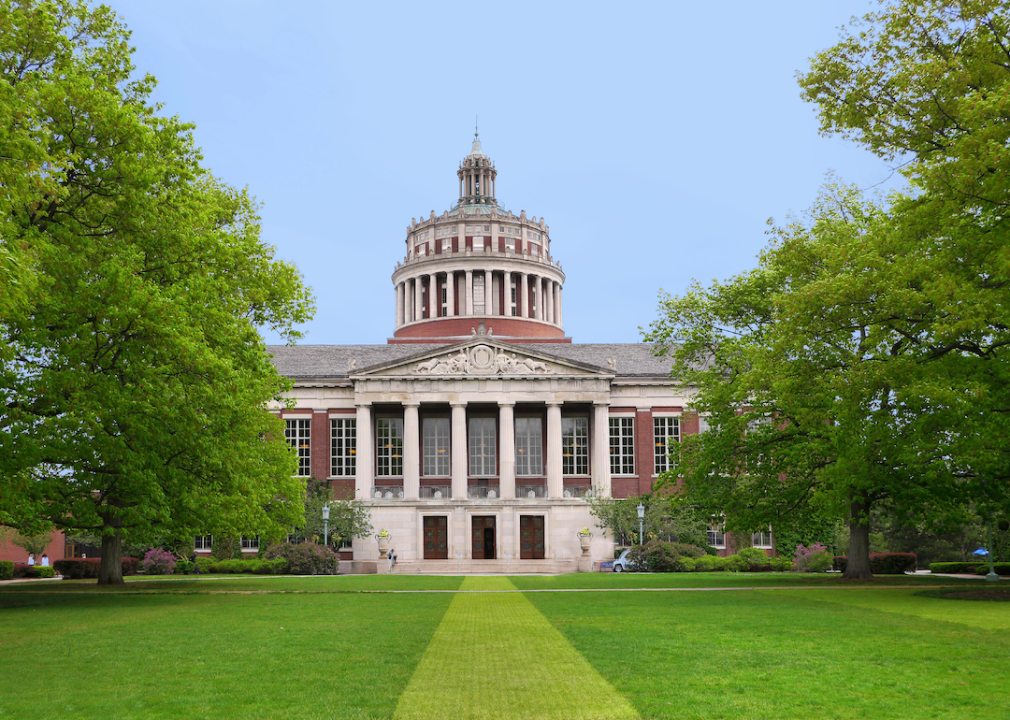
Spiroview Inc // Shutterstock
#91. University of Rochester
Rush Rhees Library at the University of Rochester.
– Location: Rochester, New York
– Undergraduate enrollment: 6,425
– Student-to-faculty ratio: 2:1
– Acceptance rate: 39%
– Graduation rate: 90%
– Six-year median earnings: $61,200
– Two-year employment rate: 92%
The University of Rochester is home to the storied Institute of Optics, the first optics education program in the nation. Its school of music also has an impressive legacy and was established by industrialist George Eastman, founder of Eastman Kodak Company.
You may also like: How to keep your personal data a little more private while pursuing higher education
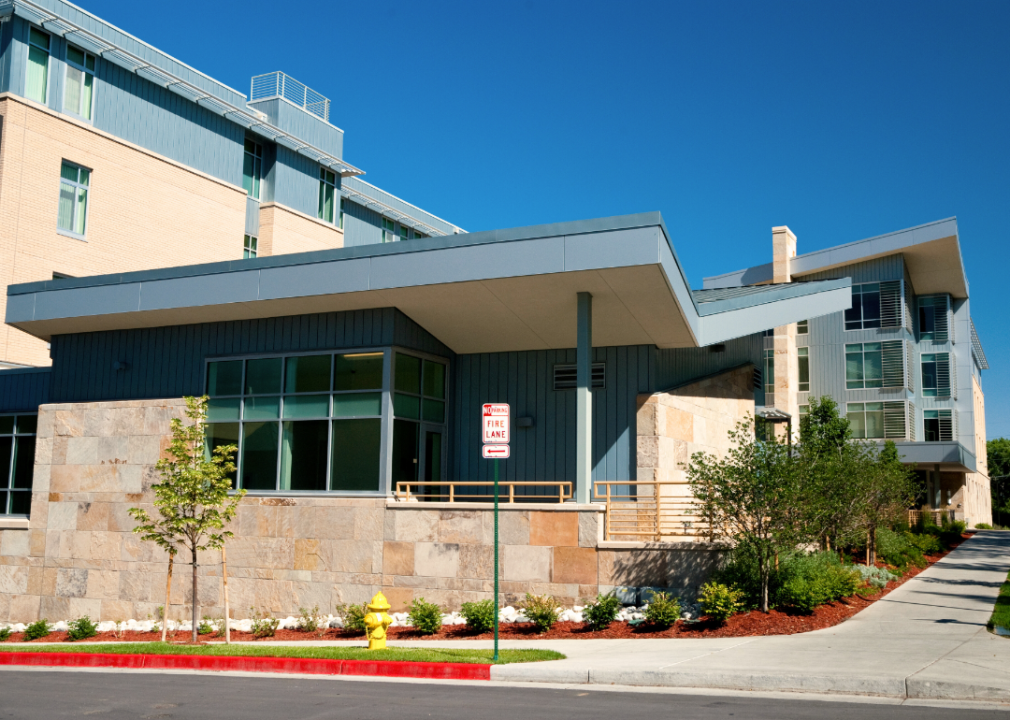
Canva
#90. Colorado School of Mines
A building on the Colorado School of Mines campus.
– Location: Golden, Colorado
– Undergraduate enrollment: 5,201
– Student-to-faculty ratio: 13:1
– Acceptance rate: 58%
– Graduation rate: 82%
– Six-year median earnings: $84,900
– Two-year employment rate: 95%
The Colorado School of Mines boasts strong ties to the National Renewable Energy Laboratory, National Institute of Standards and Technology, and U.S. Geological Survey. Located in the Rocky Mountains, it provides one of the most intriguing recreational atmospheres for a college, with numerous trails and ski areas nearby. Mining is not the only specialty emphasized, as the college also has programs in economics, biochemistry, and applied mathematics and statistics.
EQRoy // Shutterstock
#89. Florida International University
View of the Biscayne Bay Campus of Florida International University.
– Location: Miami
– Undergraduate enrollment: 26,106
– Student-to-faculty ratio: 19:1
– Acceptance rate: 64%
– Graduation rate: 69%
– Six-year median earnings: $46,300
– Two-year employment rate: 90%
Florida International University is split into two campuses, one in west Miami-Dade County and another along the waters of Biscayne Bay. The latter is home to a prestigious, hands-on marine biology program. Over half of the student body is Hispanic, making the school one of the most prolific for undergraduate degrees among that demographic.
Chad Robertson Media // Shutterstock
#88. Clemson University
Memorial Stadium on the Clemson University Campus.
– Location: Clemson, South Carolina
– Undergraduate enrollment: 21,741
– Student-to-faculty ratio: 14:1
– Acceptance rate: 43%
– Graduation rate: 85%
– Six-year median earnings: $52,400
– Two-year employment rate: 94%
Clemson University is located in the Experimental Forest, with 17,500 acres reserved for education, research, and demonstration to foster an understanding of forest management. As a land-grant institution, Clemson encourages students and faculty alike to give back to the local community through their research, including on topics such as irrigation and youth bullying.
JHVEPhoto // Shutterstock
#87. University of Connecticut
University of Connecticut Stamford campus building.
– Location: Storrs, Connecticut
– Undergraduate enrollment: 18,397
– Student-to-faculty ratio: 8:1
– Acceptance rate: 55%
– Graduation rate: 83%
– Six-year median earnings: $58,400
– Two-year employment rate: 95%
The University of Connecticut’s nationally ranked sports teams—especially in basketball—are a huge draw for students and alums. The school’s relatively rural setting leads to a strong culture and plenty of on-campus activities, with over 450 clubs and a popular Greek life scene. This vibe is on display during the annual Spring Weekend, a pre-exams carnival that started in the 1940s.
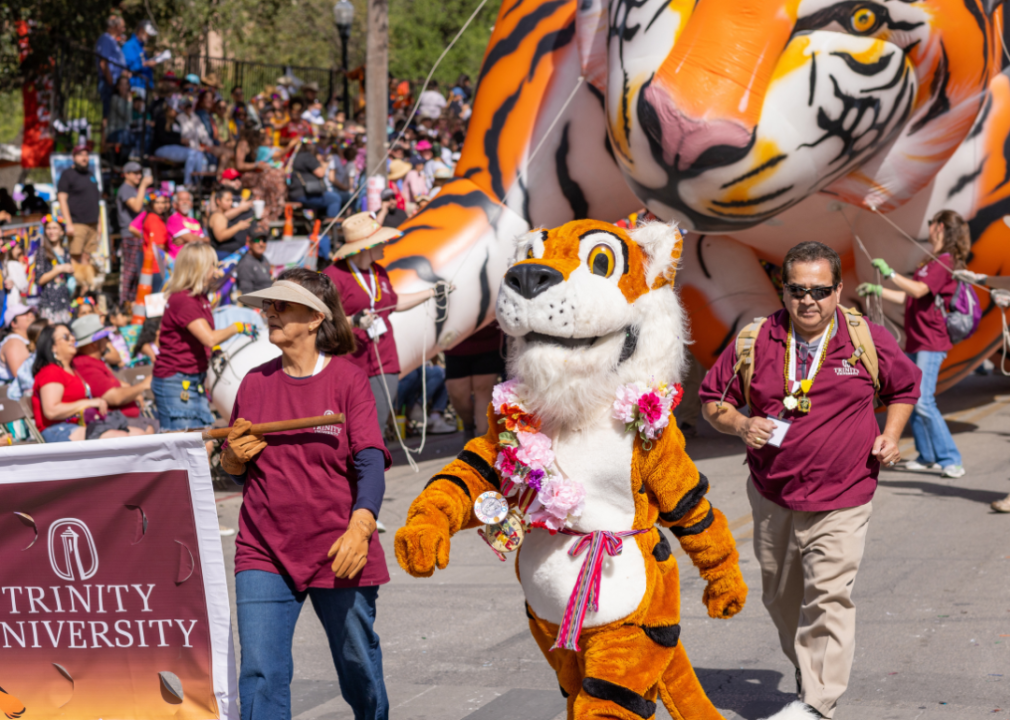
Roberto Galan // Shutterstock
#86. Trinity University
The tiger mascot of Trinity University marches in a parade.
– Location: San Antonio
– Undergraduate enrollment: 2,482
– Student-to-faculty ratio: 8:1
– Acceptance rate: 31%
– Graduation rate: 76%
– Six-year median earnings: $54,900
– Two-year employment rate: 93%
Trinity University has historically ranked high for its undergraduate research, undergraduate engineering program, and schoolwide innovation. It’s widely considered the best small college in Texas—backed up by Niche’s #1 ranking in that category—and among the best small colleges in the U.S.
You may also like: Largest college campuses in the US by acreage
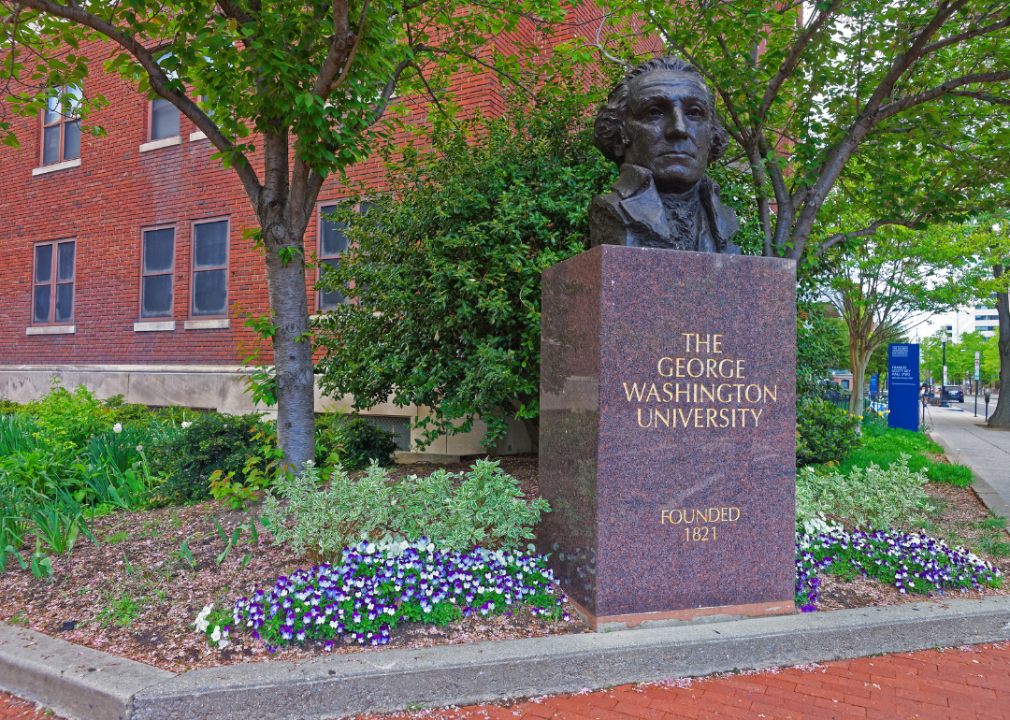
Canva
#85. George Washington University
A marble sign with a bust of George Washington on the campus of George Washington University.
– Location: Washington D.C.·
– Undergraduate enrollment: 10,332
– Student-to-faculty ratio: 6:1
– Acceptance rate: 49%
– Graduation rate: 85%
– Six-year median earnings: $69,600
– Two-year employment rate: 92%
In addition to top-tier academics, George Washington University boasts unique internships and myriad service opportunities. GW has more than 475 student organizations that cater to a variety of student interests and experiences, and 2 in 5 undergraduates study abroad.
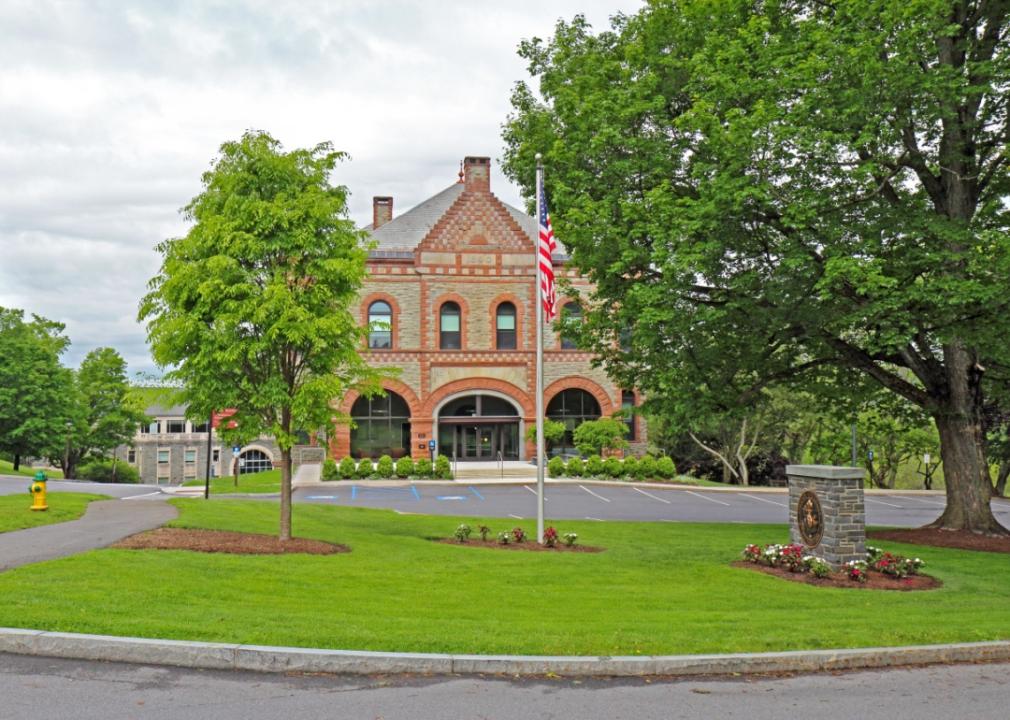
Stephen B. Goodwin // Shutterstock
#84. Colgate University
The James B. Colgate admissions and administration building on the campus of Colgate University.
– Location: Hamilton, New York
– Undergraduate enrollment: 3,112
– Student-to-faculty ratio: 9:1
– Acceptance rate: 12%
– Graduation rate: 91%
– Six-year median earnings: $63,600
– Two-year employment rate: 93%
Located in the quaint village of Hamilton in upstate New York, Colgate University is an oasis away from the bustle of the big city. Highlights on campus include the Longyear Museum of Anthropology and the Picker Art Gallery, with a focus on 20th-century paper works, photographs, and paintings. Colgate has over 200 clubs and organizations.
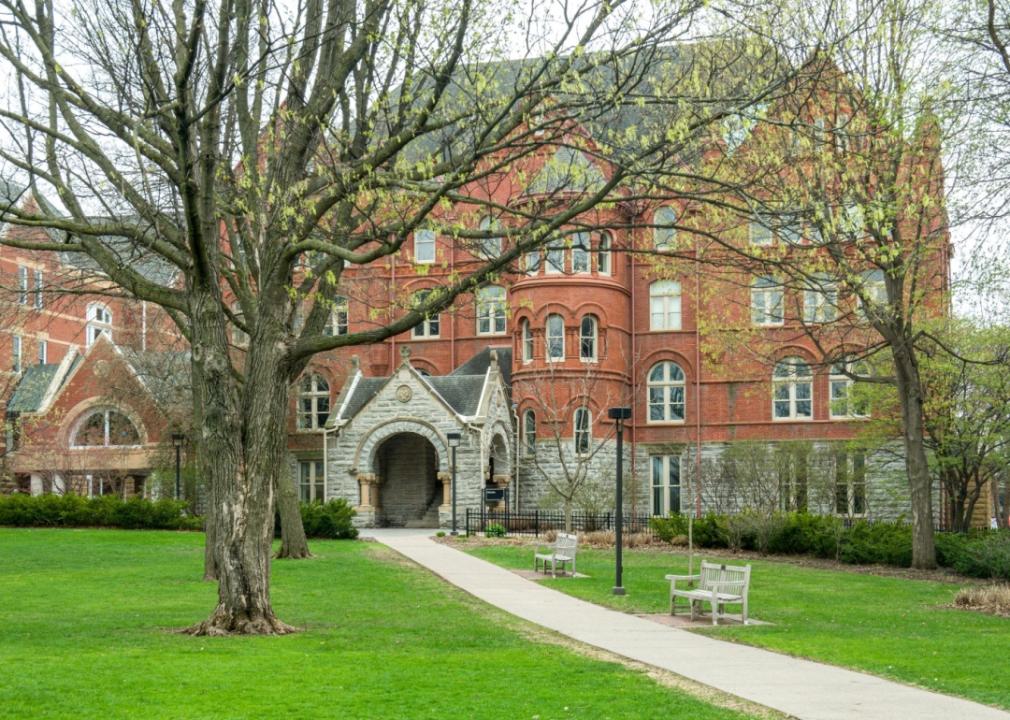
Ken Wolter // Shutterstock
#83. Macalester College
An exterior view of Old Main at Macalester College.
– Location: Saint Paul, Minnesota
– Undergraduate enrollment: 2,110
– Student-to-faculty ratio: 10:1
– Acceptance rate: 28%
– Graduation rate: 88%
– Six-year median earnings: $47,600
– Two-year employment rate: 91%
Though the backdrop of the Twin Cities provides plenty of plush scenery, Macalester College encourages study away experiences to develop scholarship, internationalism, multiculturalism, and service to society, with nearly 60% of students taking part. The college has a commitment to sustainability, with the residential EcoHouse serving as a live-in laboratory.
Focused Adventures // Shutterstock
#82. Michigan State University
Michigan State University entrance sign.
– Location: East Lansing, Michigan
– Undergraduate enrollment: 37,492
– Student-to-faculty ratio: 12:1
– Acceptance rate: 88%
– Graduation rate: 82%
– Six-year median earnings: $53,600
– Two-year employment rate: 95%
Michigan State University was the first school in the country to be named a land-grant institution under the Morrill Act in 1862. Today, that tradition of agricultural focus is still alive: MSU has one of the only environmental journalism programs in the nation as well as an organic farm overseen by students.
Eli Wilson // Shutterstock
#81. William & Mary
Aerial view of Zable Stadium at The College of William and Mary.
– Location: Williamsburg, Virginia
– Undergraduate enrollment: 6,887
– Student-to-faculty ratio: 9:1
– Acceptance rate: 33%
– Graduation rate: 91%
– Six-year median earnings: $58,500
– Two-year employment rate: 94%
William & Mary’s law school is the oldest in the U.S.—dating to 1779. The college also has several improv comedy groups, and Jon Stewart happens to be an alum. The Christmas season is widely celebrated on campus, with the school president dressing up as Santa Claus at the annual Yule Log ceremony.
You may also like: Coalition maintains undocumented kids have a right to attend public schools
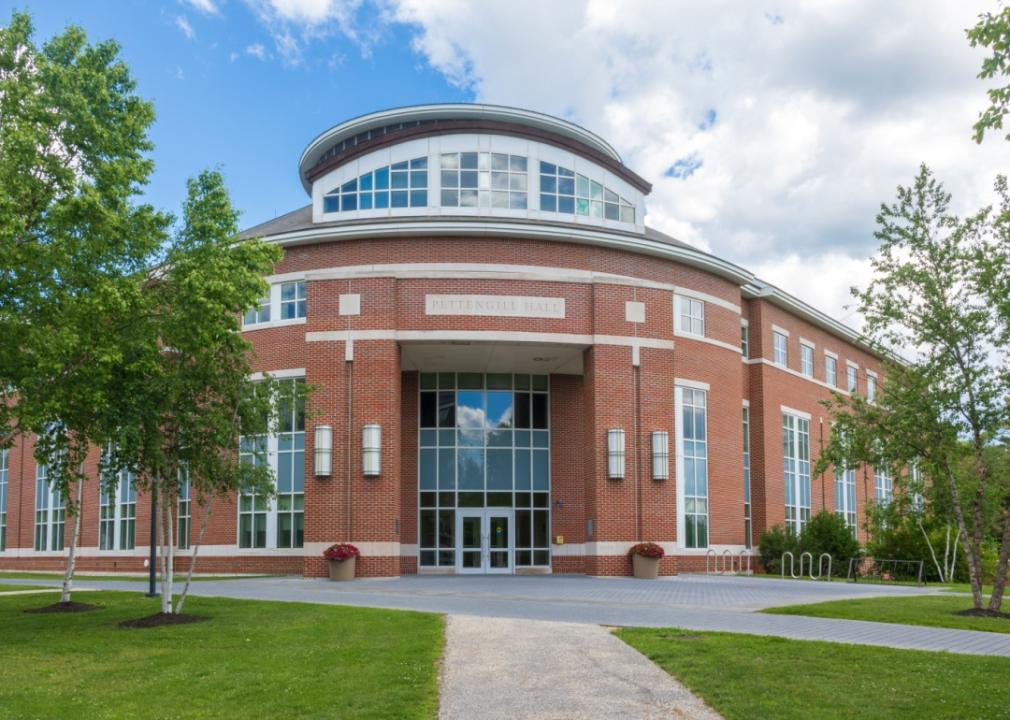
Jennifer Yakey-Ault // Shutterstock
#80. Bates College
An exterior view of Pettengill Hall on the campus of Bates College.
– Location: Lewiston, Maine
– Undergraduate enrollment: 1,712
– Student-to-faculty ratio: 9:1
– Acceptance rate: 14%
– Graduation rate: 93%
– Six-year median earnings: $59,200
– Two-year employment rate: 94%
Known for the 19th-century buildings on its historic quad, Bates College could be the prototype of a small New England college. Students can study in conjunction with schools such as Columbia, Dartmouth, and Rensselaer Polytechnic Institute. Those who are inspired by movement can see professional performances at the annual Bates Dance Festival.
quiggyt4 // Shutterstock
#79. Rutgers University–New Brunswick
View of Winants Hall at the campus of Rutgers University.
– Location: Piscataway, New Jersey
– Undergraduate enrollment: 34,667
– Student-to-faculty ratio: 8:1
– Acceptance rate: 66%
– Graduation rate: 84%
– Six-year median earnings: $57,900
– Two-year employment rate: 93%
Rutgers University–New Brunswick is woven into the New Jersey landscape, with five campuses around the region. The school was named after Revolutionary War Col. Henry Rutgers. It is particularly well known for its Graduate School of Education, and students can also pursue studies at the Center for Advanced Infrastructure and Transportation and New Jersey Agricultural Experiment Station.
Jonathan Feinstein // Shutterstock
#78. Vassar College
The campus of Vassar College in summer.
– Location: Poughkeepsie, New York
– Undergraduate enrollment: 2,436
– Student-to-faculty ratio: 8:1
– Acceptance rate: 19%
– Graduation rate: 92%
– Six-year median earnings: $54,600
– Two-year employment rate: 93%
This former women’s college is one of the better-known liberal arts schools on the East Coast. Vassar College boasts its own ecological preserve along with several historic buildings. Also appealing: Students receive an average financial aid award of $51,508, with the school meeting 100% of demonstrated need.
Emma’sPhotos // Shutterstock
#77. University of Massachusetts Amherst
An academic building at University of Massachusetts, Amherst.
– Location: Amherst, Massachusetts
– Undergraduate enrollment: 22,920
– Student-to-faculty ratio: 15:1
– Acceptance rate: 64%
– Graduation rate: 83%
– Six-year median earnings: $51,400
– Two-year employment rate: 94%
The University of Massachusetts Amherst is the flagship of the UMass system and includes the tallest academic library in the world, the W.E.B. Du Bois Library. Under the Five College Interchange, students can take courses at nearby Smith, Mount Holyoke, Amherst, and Hampshire colleges. Besides typical offerings, UMass Amherst also allows students to design their own majors through the bachelor’s degree with individual concentration program.
Kenneth Sponsler // Shutterstock
#76. Case Western Reserve University
The Peter B. Lewis building, designed by renowned architect Frank Gehry, on the campus of Case Western Reserve University.
– Location: Cleveland
– Undergraduate enrollment: 5,907
– Student-to-faculty ratio: 5:1
– Acceptance rate: 27%
– Graduation rate: 86%
– Six-year median earnings: $74,600
– Two-year employment rate: 94%
Case Western Reserve University is known for its excellent social work and nursing schools. Located in the heart of Cleveland, Case Western has affiliations with many city businesses, and students can register for courses at the Cleveland Institute of Art and the Cleveland Institute of Music.
You may also like: 6 hidden (and not-so-hidden) factors driving America’s student absenteeism crisis
Lucky-photographer // Shutterstock
#75. University of Central Florida
Knight on a horse statue at the University of Central Florida in front of the FBC Mortgage Stadium.
– Location: Orlando, Florida
– Undergraduate enrollment: 41,098
– Student-to-faculty ratio: 26:1
– Acceptance rate: 41%
– Graduation rate: 76%
– Six-year median earnings: $45,400
– Two-year employment rate: 93%
Colloquially known as “Space University,” the University of Central Florida has strong ties to the U.S. space program at the nearby Kennedy Space Center. The school was founded as Florida Technological University with an explicit focus on STEM education. Though its curriculum has since expanded, today the university is still involved with nearly 700 NASA projects.
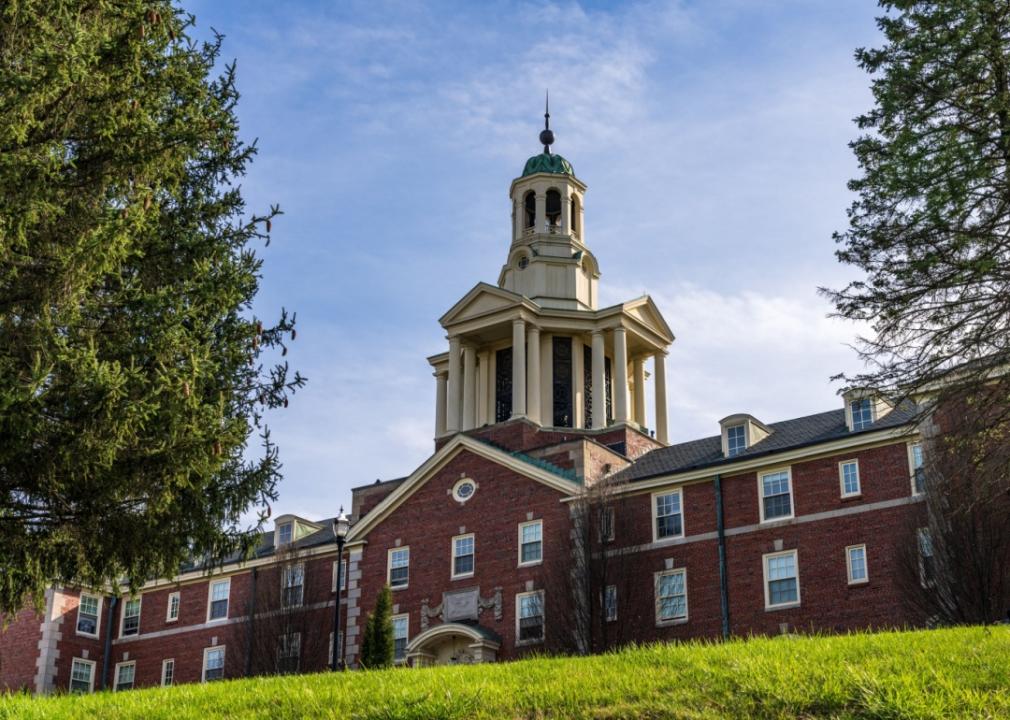
Steve Heap // Shutterstock
#74. Wesleyan University
Historic Stuyvesant Hall used as a residential building at Ohio Wesleyan University.
– Location: Middletown, Connecticut
– Undergraduate enrollment: 3,006
– Student-to-faculty ratio: 7:1
– Acceptance rate: 14%
– Graduation rate: 93%
– Six-year median earnings: $54,700
– Two-year employment rate: 90%
Wesleyan University’s 316-acre campus in the middle of New England has educated Lin-Manuel Miranda, Bill Belichick, and Michael Bay. For almost 100 years, Wesleyan has had a thriving theater program, and since 1995 it has provided full tuition to students from Asia with the Freeman Asian Scholarship Program.

Canva
#73. Hamilton College
A student seated on a blanket in on the grass with an open textbook and laptop on their lap.
– Location: Clinton, New York
– Undergraduate enrollment: 2,026
– Student-to-faculty ratio: 9:1
– Acceptance rate: 12%
– Graduation rate: 92%
– Six-year median earnings: $60,200
– Two-year employment rate: 91%
All Hamilton College students live in residence halls to foster community. They study with an open curriculum and can skate on Sage Rink, the second-oldest college ice arena in the country. Venus Williams, Tina Fey, and Hillary Clinton are among the renowned figures to speak on campus.
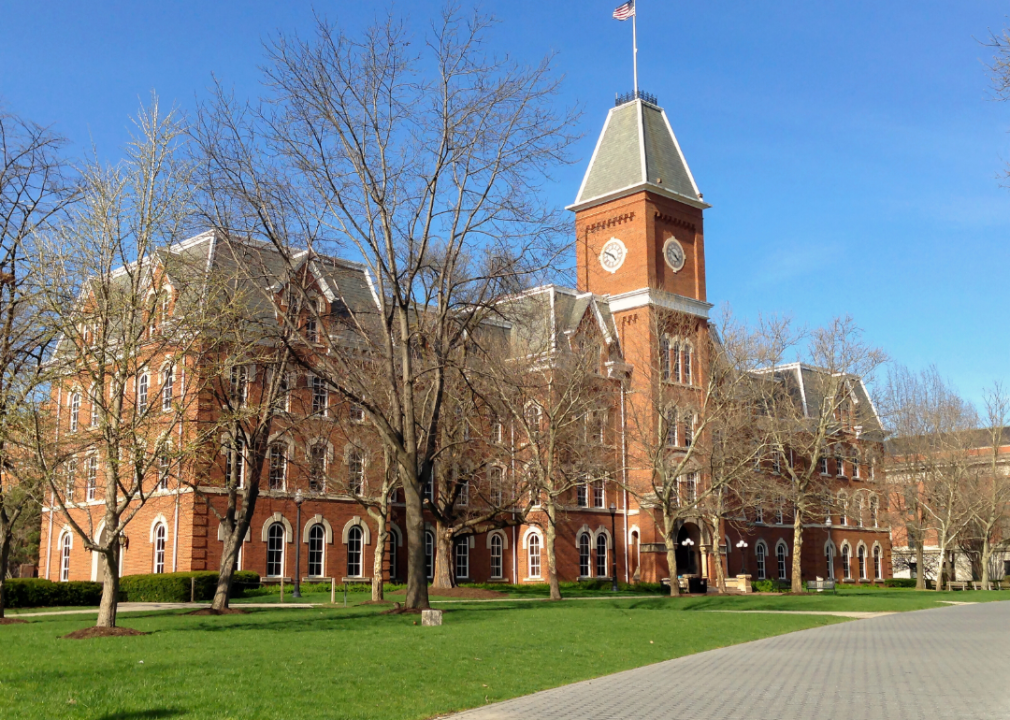
Canva
#72. The Ohio State University
An exterior view of University Hall on the Ohio State University campus.
– Location: Columbus, Ohio
– Undergraduate enrollment: 42,360
– Student-to-faculty ratio: 8:1
– Acceptance rate: 53%
– Graduation rate: 88%
– Six-year median earnings: $46,100
– Two-year employment rate: 94%
The Ohio State University is notable for its aerospace engineering program and investment in research. Students have been at the forefront of electric vehicle technology, and the school maintains a collegiate campus feel within the big city of Columbus.
Fotoluminate LLC // Shutterstock
#71. Tulane University
An exterior view of Tulane University.
– Location: New Orleans
– Undergraduate enrollment: 8,231
– Student-to-faculty ratio: 5:1
– Acceptance rate: 11%
– Graduation rate: 87%
– Six-year median earnings: $61,700
– Two-year employment rate: 91%
Tulane University has a strong bond with the city of New Orleans, particularly after Hurricane Katrina. Its medical and law schools are some of the oldest in the country, and students rank among the happiest in the nation, according to The Princeton Review.
You may also like: For a second year, FAFSA will again be delayed
Mark Yarchoan // Shutterstock
#70. Amherst College
A spire from Amherst College rises above fall foliage.
– Location: Amherst, Massachusetts
– Undergraduate enrollment: 1,898
– Student-to-faculty ratio: 7:1
– Acceptance rate: 7%
– Graduation rate: 92%
– Six-year median earnings: $65,000
– Two-year employment rate: 90%
Amherst College is repeatedly recognized as one of the top liberal arts schools in the country. Students can take advantage of an open curriculum with no core requirements. Amherst is home to the Beneski Museum of Natural History and a 500-acre wildlife sanctuary.
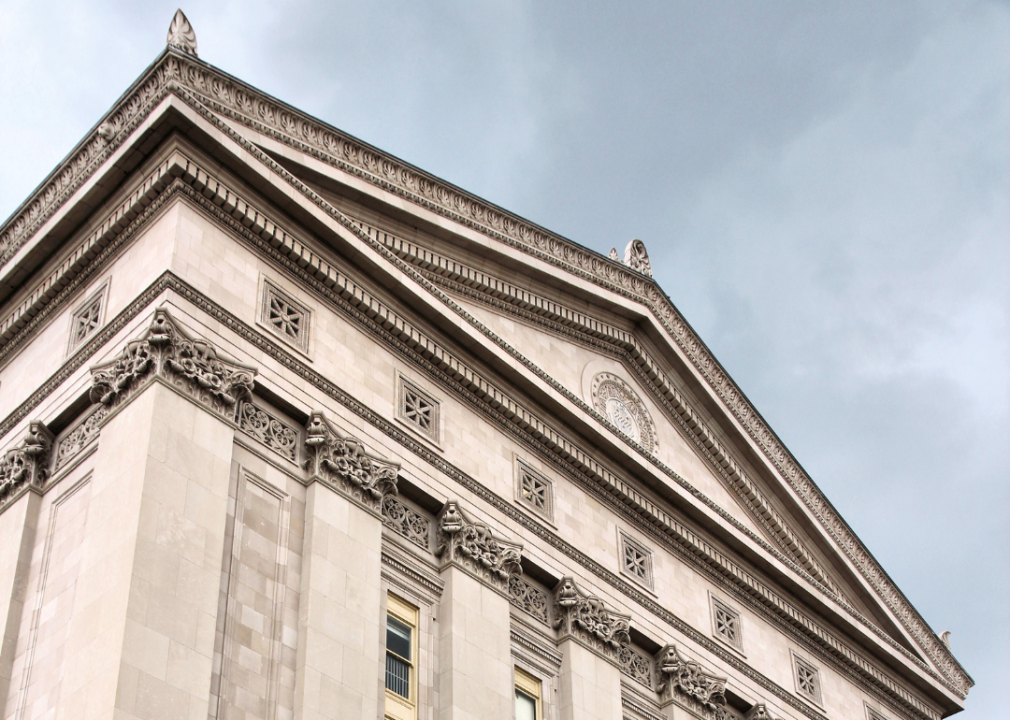
Canva
#69. University of Pittsburgh
An ornate facade of a building at the University of Pittsburgh.
– Location: Pittsburgh
– Undergraduate enrollment: 19,291
– Student-to-faculty ratio: 4:1
– Acceptance rate: 49%
– Graduation rate: 84%
– Six-year median earnings: $53,900
– Two-year employment rate: 94%
The University of Pittsburgh comprises 16 schools and colleges that offer over 650 degree and certificate programs. The school boasts an internship initiative that helps students gain real-world experience in their fields. Founded in 1787, it was a log cabin before becoming a top-five supporter of National Institutes of Health research.
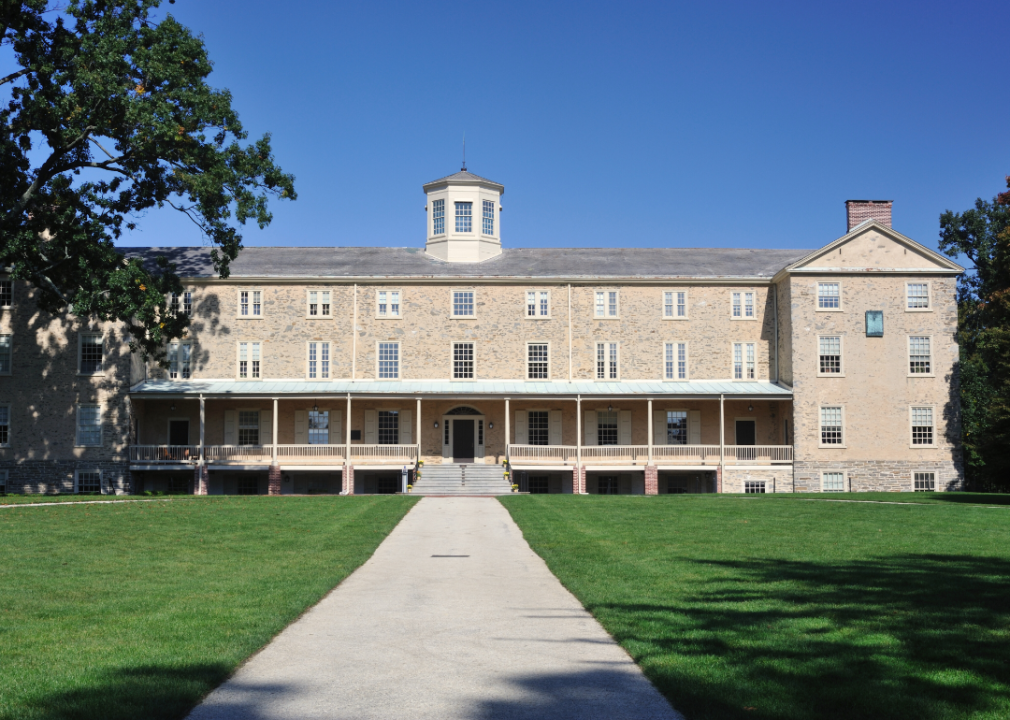
Canva
#68. Haverford College
Founders Hall on the campus of Haverford College.
– Location: Haverford, Pennsylvania
– Undergraduate enrollment: 1,419
– Student-to-faculty ratio: 8:1
– Acceptance rate: 14%
– Graduation rate: 91%
– Six-year median earnings: $60,700
– Two-year employment rate: 92%
Haverford College emphasizes discussion and debate with seminar-style classes, and 98% of students as well as 40% of faculty live on campus. The school is known for students’ input on the honor code, hiring committees, and budgets and also features an arboretum.
Bryan Pollard // Shutterstock
#67. North Carolina State University
North Carolina State University amid fall foliage.
– Location: Raleigh, North Carolina
– Undergraduate enrollment: 23,828
– Student-to-faculty ratio: 13:1
– Acceptance rate: 47%
– Graduation rate: 85%
– Six-year median earnings: $52,500
– Two-year employment rate: 94%
Located in the Research Triangle, North Carolina State University is a leader in education about textiles, agriculture and life sciences, and engineering. The school has helped launch hundreds of startups that have received $1.7 billion in venture capital and get thousands of patents approved, leading to 600-plus consumer products.
Ken Wolter // Shutterstock
#66. University of Minnesota Twin Cities
A red sign atop a wrought iron fence with gold letters spelling out University of Minnesota.
– Location: Minneapolis
– Undergraduate enrollment: 29,057
– Student-to-faculty ratio: 8:1
– Acceptance rate: 75%
– Graduation rate: 84%
– Six-year median earnings: $51,900
– Two-year employment rate: 94%
The University of Minnesota has a sprawling campus in the Twin Cities, and Bob Dylan was briefly a student. Twenty-five Gophers have won a Nobel Prize, and three faculty have earned a Pulitzer Prize. Others invented GORE-TEX and K-rations, and the school is a leader with its Stem Cell Institute and Tucker Center for Research on Girls & Women in Sport.
You may also like: The best computer science universities in Asia
Rui Serra Maia // Shutterstock
#65. Virginia Tech
The campus of Virginia Tech under cloudy skies.
– Location: Blacksburg, Virginia
– Undergraduate enrollment: 29,569
– Student-to-faculty ratio: 13:1
– Acceptance rate: 57%
– Graduation rate: 86%
– Six-year median earnings: $62,500
– Two-year employment rate: 96%
Virginia Tech has its own power plant and is also a leading center for automotive research with its Transportation Institute. The school will open its Innovation Campus—a space dedicated to startups, public agencies, and corporations that is six years in the making—in 2025.
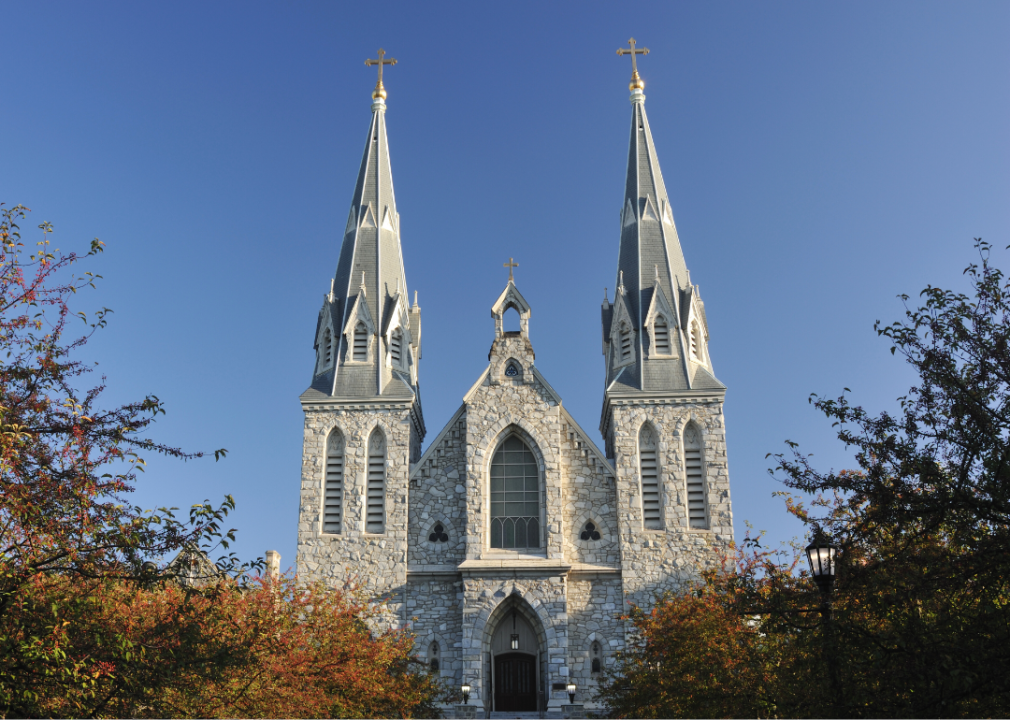
Canva
#64. Villanova University
Exterior view of the St. Thomas of Villanova Chapel.
– Location: Villanova, Pennsylvania
– Undergraduate enrollment: 7,087
– Student-to-faculty ratio: 8:1
– Acceptance rate: 23%
– Graduation rate: 91%
– Six-year median earnings: $77,900
– Two-year employment rate: 95%
Located just outside of Philadelphia, Villanova University is centered in the Augustinian tradition. Its business school consistently places near the top of rankings, and its men’s basketball program is accomplished as well. The college provides faith-based learning as well as service experiences, including the largest student-run Special Olympics in the world.
Bryan Pollard // Shutterstock
#63. Wake Forest University
Wake chapel on the campus of Wake Forest University.
– Location: Winston-Salem, North Carolina
– Undergraduate enrollment: 5,391
– Student-to-faculty ratio: 2:1
– Acceptance rate: 21%
– Graduation rate: 90%
– Six-year median earnings: $63,800
– Two-year employment rate: 94%
Studying abroad is a focus at Wake Forest University, where 3 in 5 students take classes overseas. The campus has its own charms, too, with its stunning architecture and natural beauty. Innovation Quarter is a center of collaboration with 90 health care, research, technology, and other companies, including many in health care, research and technology.
VDB Photos // Shutterstock
#62. University of California, Santa Barbara
Exterior view of the University of California, Santa Barbara.
– Location: Santa Barbara, California
– Undergraduate enrollment: 22,793
– Student-to-faculty ratio: 20:1
– Acceptance rate: 26%
– Graduation rate: 86%
– Six-year median earnings: $55,300
– Two-year employment rate: 91%
The Kavli Institute for Theoretical Physics is a centerpiece of the University of California, Santa Barbara. As much as 70% of the student body gets around the scenic campus by bike, attending classes in esteemed buildings such as the Institute for Social, Behavioral and Economic Research.
Tricia Daniel // Shutterstock
#61. Texas A&M University
Flags flying on the Texas A&M University campus.
– Location: College Station, Texas
– Undergraduate enrollment: 51,150
– Student-to-faculty ratio: 16:1
– Acceptance rate: 63%
– Graduation rate: 84%
– Six-year median earnings: $58,000
– Two-year employment rate: 95%
Texas A&M University is one of six senior military colleges in the U.S., and the Corps of Cadets prepares those students for leadership and organizational management roles. The school also hosts the George H.W. Bush Presidential Library and Museum and has maintained a long partnership with NASA.
You may also like: They thought graduation was near. Instead, these immigrant students were pressured to transfer.
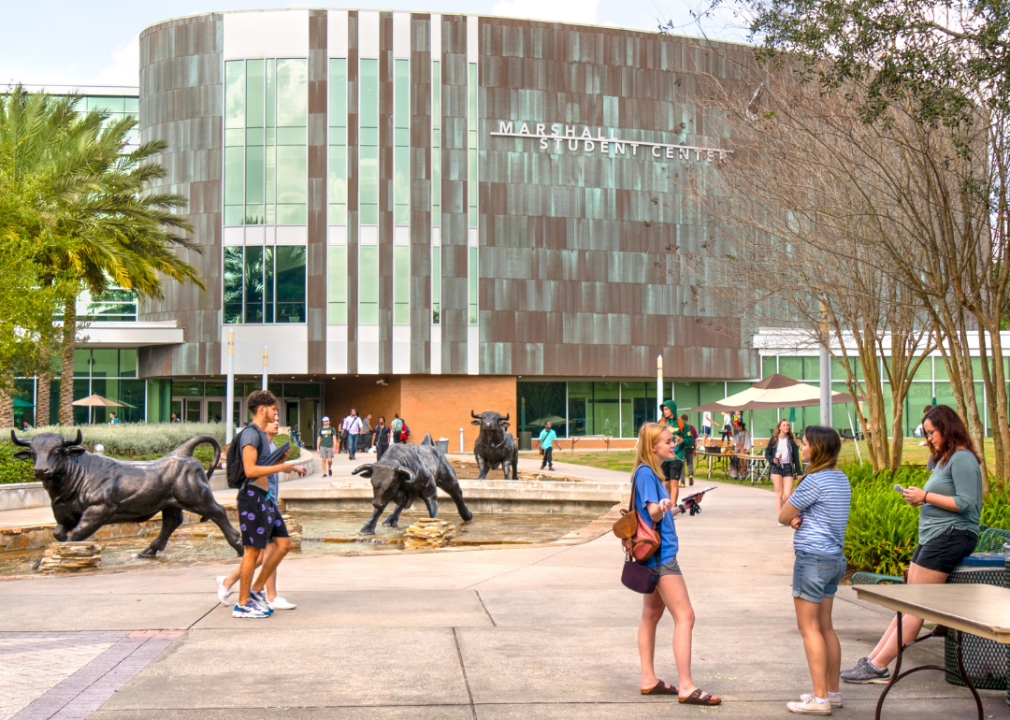
Leigh Trail // Shutterstock
#60. University of South Florida
The Marshall Student Center at the University of South Florida.
– Location: Tampa, Florida
– Undergraduate enrollment: 30,097
– Student-to-faculty ratio: 13:1
– Acceptance rate: 44%
– Graduation rate: 74%
– Six-year median earnings: $43,500
– Two-year employment rate: 91%
The University of South Florida earns high marks for its research and innovation and has top graduate programs in industrial and organizational psychology, criminology, audiology, and more. USF is also one of 18 Tillman Partnership Universities, which offer an array of veteran-specific support services.
Ken Wolter // Shutterstock
#59. University of Wisconsin
Bascom Hall at the University of Wisconsin.
– Location: Madison, Wisconsin
– Undergraduate enrollment: 33,838
– Student-to-faculty ratio: 8:1
– Acceptance rate: 49%
– Graduation rate: 89%
– Six-year median earnings: $56,200
– Two-year employment rate: 95%
The University of Wisconsin is a hub of innovation where vitamins A and B were discovered. It is also known for its Stem Cell and Regenerative Medicine Center and on-campus nuclear reactor, which is used for research and teaching. Few college events are as iconic as Jump Around at Badgers football games.
Joy Brown // Shutterstock
#58. Lehigh University
Exterior of a stone building at Lehigh University.
– Location: Bethlehem, Pennsylvania
– Undergraduate enrollment: 5,624
– Student-to-faculty ratio: 9:1
– Acceptance rate: 37%
– Graduation rate: 91%
– Six-year median earnings: $81,900
– Two-year employment rate: 95%
The P.C. Rossin College of Engineering and Applied Science is a centerpiece of academic study at Lehigh University, which is nestled in Pennsylvania’s Lehigh Valley, not too far from Philadelphia and New York City. Students at the engineering school went on to invent the escalator and first implantable artificial heart and found Packard Motor Car Company.
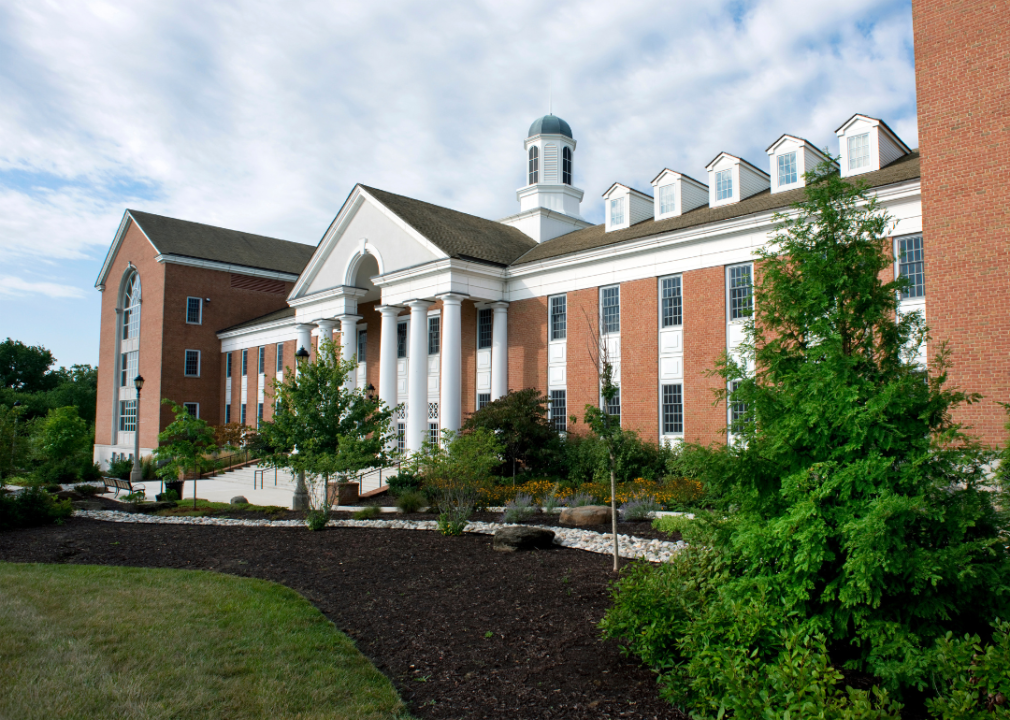
Canva
#57. University of Maryland, College Park
An exterior view of the University of Maryland, College Park.
– Location: College Park, Maryland
– Undergraduate enrollment: 28,069
– Student-to-faculty ratio: 14:1
– Acceptance rate: 45%
– Graduation rate: 89%
– Six-year median earnings: $62,900
– Two-year employment rate: 93%
Located just outside of Washington D.C., the University of Maryland, College Park is a top public research institution. In 2016, the school became the first Do Good campus, equipping students to become civic-minded and lead nonprofit causes and social innovation. The college ranks highly for its programs in quantum science, artificial intelligence, and climate change.
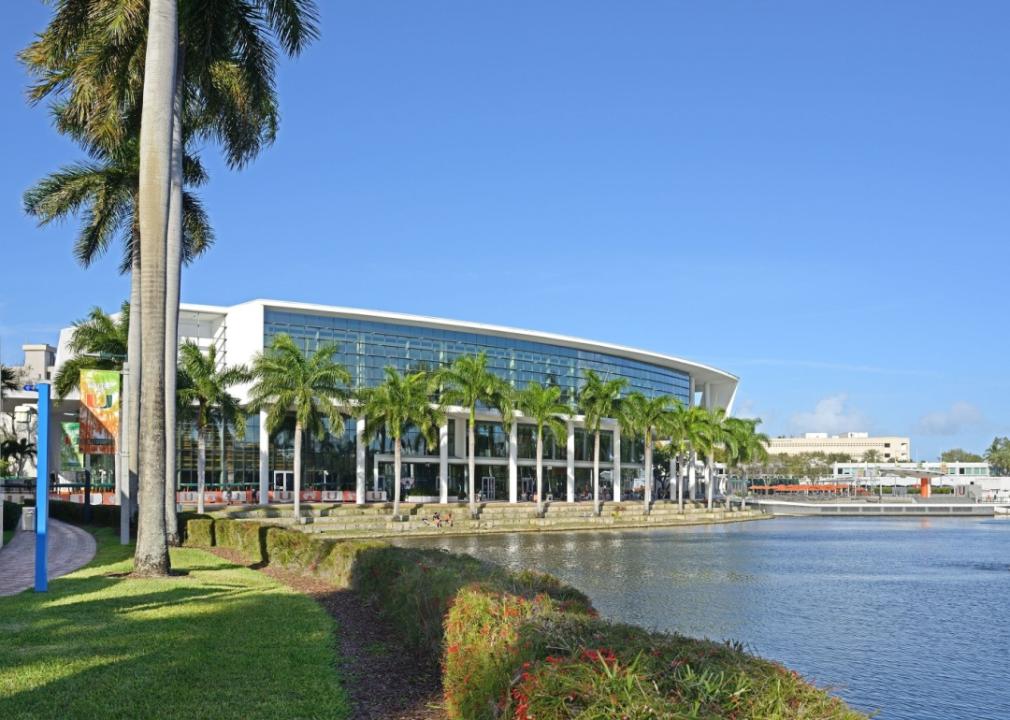
Popova Valeriya // Shutterstock
#56. University of Miami
Shalala Student Center looking over Lake Osceola on University of Miami campus.
– Location: Coral Gables, Florida
– Undergraduate enrollment: 12,570
– Student-to-faculty ratio: 8:1
– Acceptance rate: 19%
– Graduation rate: 84%
– Six-year median earnings: $60,100
– Two-year employment rate: 90%
Don’t let the proximity to South Beach and stories of partying fool you; the University of Miami is a leading center of academic study. Miami has top-flight programs in oceanography, medicine, and climate change. And yes, the main campus in Coral Gables is located near the beach.
You may also like: Demand for sustainability, AI, and equity and inclusion courses are on the rise globally among prospective business students
Aeypix // Shutterstock
#55. Purdue University
An abstract sculpture in front of the campus of Purdue University.
– Location: West Lafayette, Indiana
– Undergraduate enrollment: 36,484
– Student-to-faculty ratio: 16:1
– Acceptance rate: 53%
– Graduation rate: 83%
– Six-year median earnings: $55,100
– Two-year employment rate: 95%
Twenty-seven astronauts attended Purdue University, including Neil Armstrong. The school also boasts America’s first university-owned airport, which provides the perfect setting for an elite flight school. The Online Writing Lab has set an industry standard in grammar and style, too.
Jay Yuan // Shutterstock
#54. Boston College
A red sign hangs from an iron post with the words Boston College.
– Location: Chestnut Hill, Massachusetts
– Undergraduate enrollment: 9,575
– Student-to-faculty ratio: 9:1
– Acceptance rate: 17%
– Graduation rate: 91%
– Six-year median earnings: $72,500
– Two-year employment rate: 94%
Boston College hosts a famous Arts Festival as well as a plethora of dance competitions. The Carroll School of Management is a top business program, and BC is also a top Jesuit, Catholic and liberal arts institution. Founded in 1863, it was the first school of higher education to operate in Boston.
Felix Mizioznikov // Shutterstock
#53. Florida State University
An aerial view of the Florida State University Campus.
– Location: Tallahassee, Florida
– Undergraduate enrollment: 29,579
– Student-to-faculty ratio: 17:1
– Acceptance rate: 25%
– Graduation rate: 85%
– Six-year median earnings: $46,400
– Two-year employment rate: 93%
Florida State University is a preeminent research university, a designation earned from the state, with four international study centers. It has taught a number of Rhodes scholars and offers esteemed instruction in criminology and criminal justice, education, and motion picture arts. Bonus: FSU has its own circus.
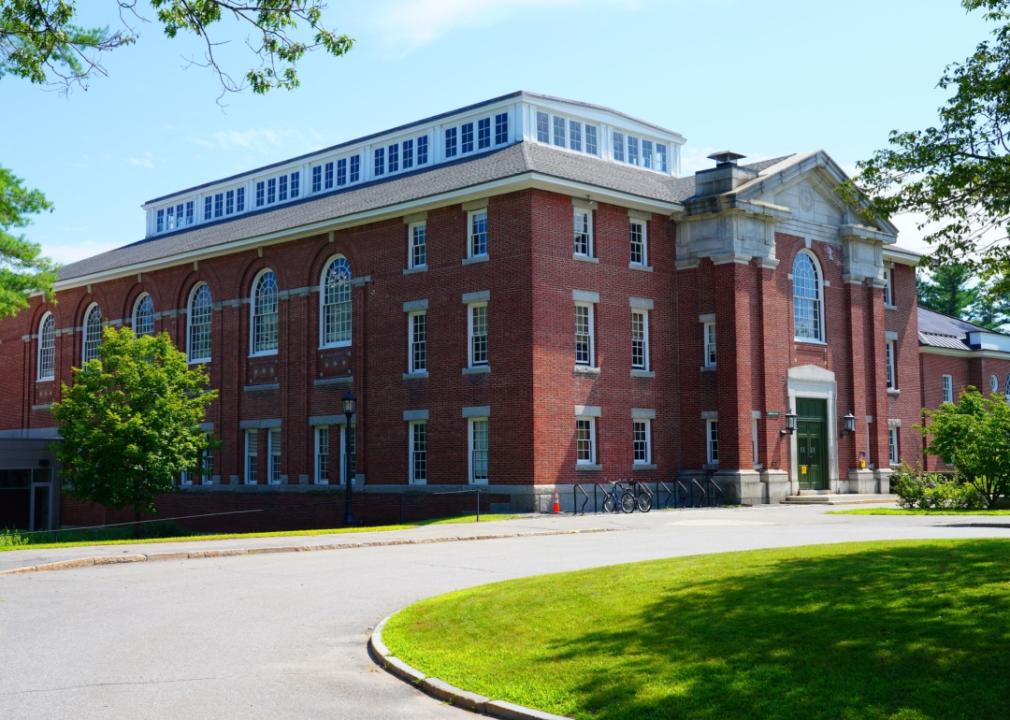
EQRoy // Shutterstock
#52. Bowdoin College
An exterior view of the campus of Bowdoin College.
– Location: Brunswick, Maine
– Undergraduate enrollment: 1,845
– Student-to-faculty ratio: 8:1
– Acceptance rate: 9%
– Graduation rate: 94%
– Six-year median earnings: $65,500
– Two-year employment rate: 93%
Bowdoin College trumpets its cooperative environment with dozens of areas of study. Students focus on brainstorming with faculty, working in teams, and welcoming difficult questions. Graduates are frequently employed by Google, the U.S. government, financial institutions, and hospitals. Another perk: SAT scores are optional for admission.
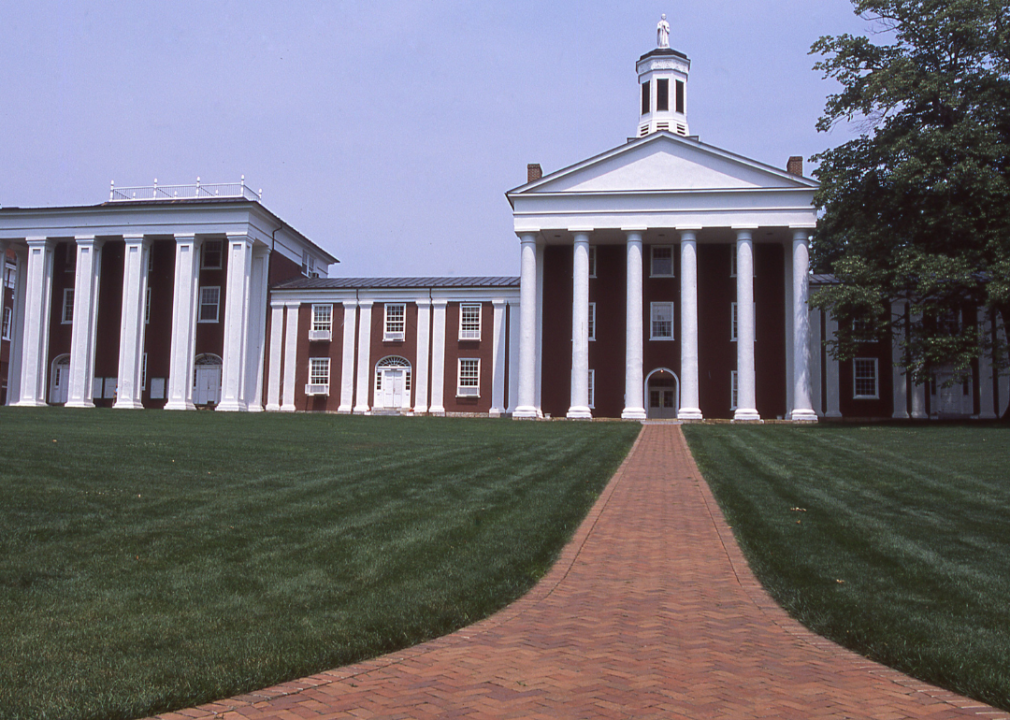
Canva
#51. Washington and Lee University
White pillars contrast with brick buildings on the campus of Washington and Lee University.
– Location: Lexington, Virginia
– Undergraduate enrollment: 1,887
– Student-to-faculty ratio: 7:1
– Acceptance rate: 17%
– Graduation rate: 95%
– Six-year median earnings: $76,100
– Two-year employment rate: 94%
One of Washington and Lee University’s hallmarks is its small class size and access to faculty. The school, the ninth-oldest in the country, dates to 1749 and offers a small but outstanding law program. Additionally, it is the only leading liberal arts college in the country with a nationally accredited undergraduate business program too.
You may also like: What difference does it make if you are involved in your student’s school and its activities and events?
Bryan Pollard // Shutterstock
#50. University of Georgia
Students walk the grounds of the University of Georgia.
– Location: Athens, Georgia
– Undergraduate enrollment: 28,823
– Student-to-faculty ratio: 13:1
– Acceptance rate: 43%
– Graduation rate: 88%
– Six-year median earnings: $50,500
– Two-year employment rate: 92%
The University of Georgia’s business school was the first of its kind in the South, and it remains a top institution in the field. The College of Environment and Design also consistently ranks among the nation’s best and confers degrees in landscape architecture, historic preservation, urban planning, and environmental design. In athletics, UGA is all about football.
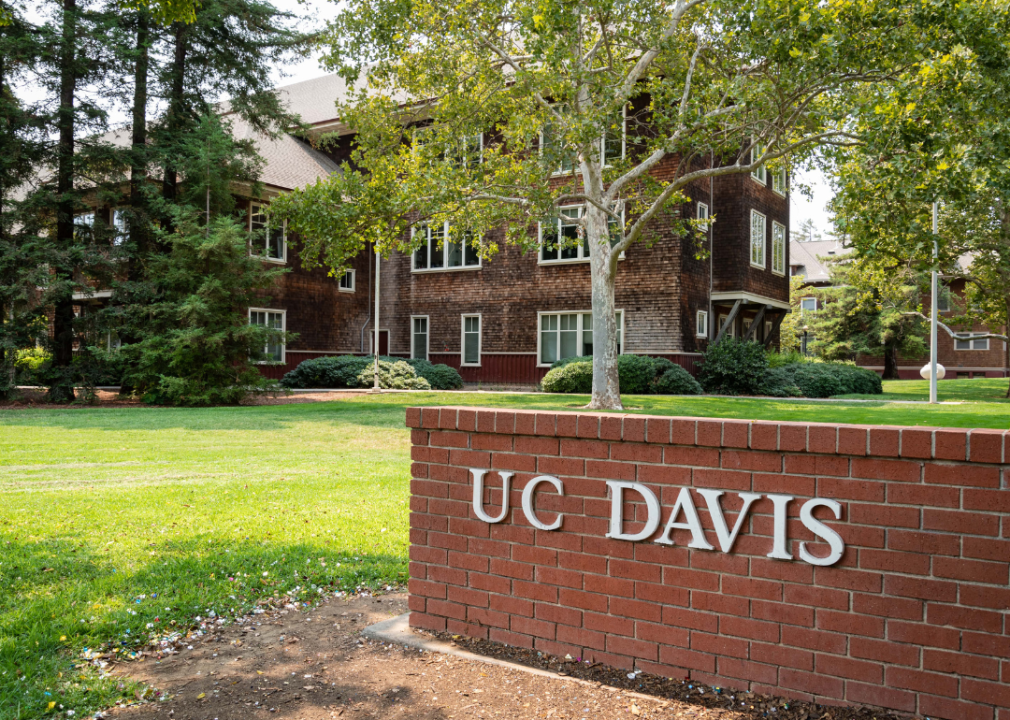
Chris Allan // Shutterstock
#49. University of California, Davis
White letters on a brick sign read, U.C. Davis.
– Location: Davis, California
– Undergraduate enrollment: 30,673
– Student-to-faculty ratio: 11:1
– Acceptance rate: 37%
– Graduation rate: 86%
– Six-year median earnings: $58,200
– Two-year employment rate: 91%
The University of California, Davis offers more than 100 majors. For those interested in pursuing medical studies, UC Davis has a renowned program with hands-on training in a teaching hospital. Research is a major part of the fabric of the school, which received over $1 billion in external research funding for the third straight year in 2023-24.
Wangkun Jia // Shutterstock
#48. Wellesley College
An ornate, red brick building on the Wellesley College campus.
– Location: Wellesley, Massachusetts
– Undergraduate enrollment: 2,316
– Student-to-faculty ratio: 7:1
– Acceptance rate: 14%
– Graduation rate: 90%
– Six-year median earnings: $60,800
– Two-year employment rate: 94%
Wellesley College, known as the best women’s school in the world, emphasizes civic engagement, and a young alum holds a spot on the board of trustees. The Albright Institute, Davis Museum, and Wellesley Centers for Women offer educational and exclusive programming to the community. Students can also cross-register for classes at nearby MIT.
cpaulfell // Shutterstock
#47. University of Washington
A fountain on the campus of the University of Washington.
– Location: Seattle
– Undergraduate enrollment: 29,226
– Student-to-faculty ratio: 6:1
– Acceptance rate: 48%
– Graduation rate: 84%
– Six-year median earnings: $57,700
– Two-year employment rate: 91%
If the picturesque campus in Seattle isn’t enough to entice you, the University of Washington has strong networks with Boeing, Amazon, and Microsoft. The school is also investing heavily in its health sciences program and is known for its research in education, public affairs, and business.
Margaret Berry // Shutterstock
#46. Middlebury College
Adirondack chairs and fall foliage on the campus of Middlebury College.
– Location: Middlebury, Vermont
– Undergraduate enrollment: 2,835
– Student-to-faculty ratio: 8:1
– Acceptance rate: 13%
– Graduation rate: 94%
– Six-year median earnings: $58,200
– Two-year employment rate: 87%
Middlebury College is recognized for its environmental studies program, which began in 1965 as the first of its kind in the U.S. The school committed to taking action on climate change with its Energy2028 initiative to use 100% renewable energy sources by the end of that year. It also owns its own ski area, the Middlebury Snowbowl.
You may also like: Community schools work to boost student performance by meeting their non-academic needs
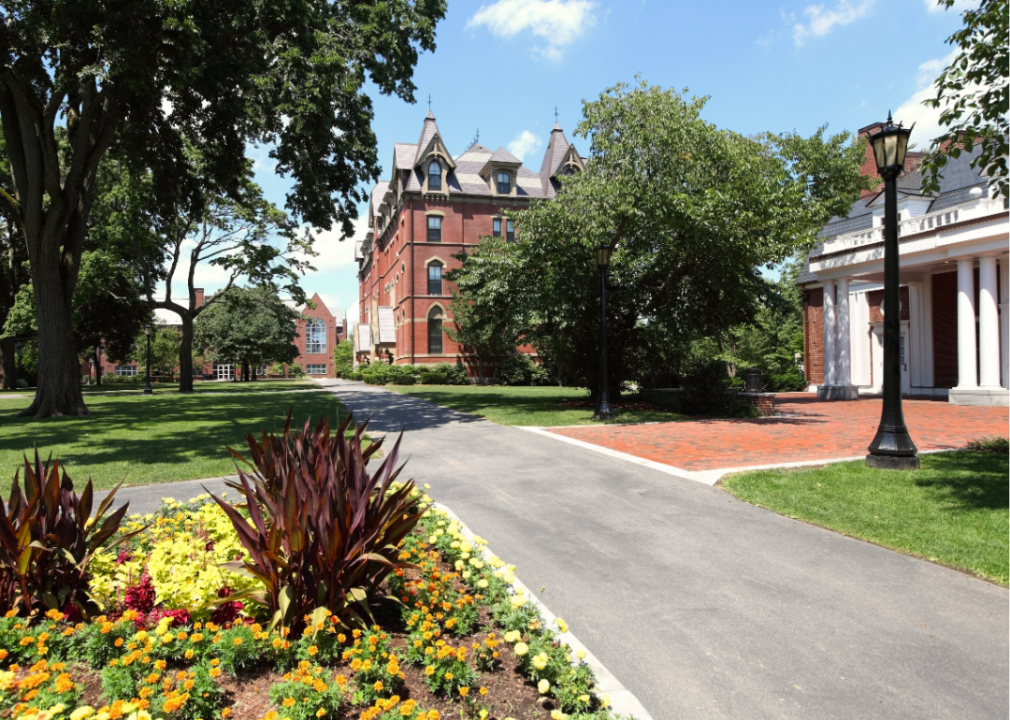
Canva
#45. Tufts University
Exterior view of a driveway leading into the campus of Tufts University.
– Location: Medford, Massachusetts
– Undergraduate enrollment: 6,635
– Student-to-faculty ratio: 6:1
– Acceptance rate: 10%
– Graduation rate: 94%
– Six-year median earnings: $75,800
– Two-year employment rate: 92%
Tufts University students have a variety of activities at their disposal, including with the Geological Society and popular a cappella groups. Its art collection features works from Pablo Picasso and Andy Warhol, and the university has partnerships with Harvard, MIT, and more.
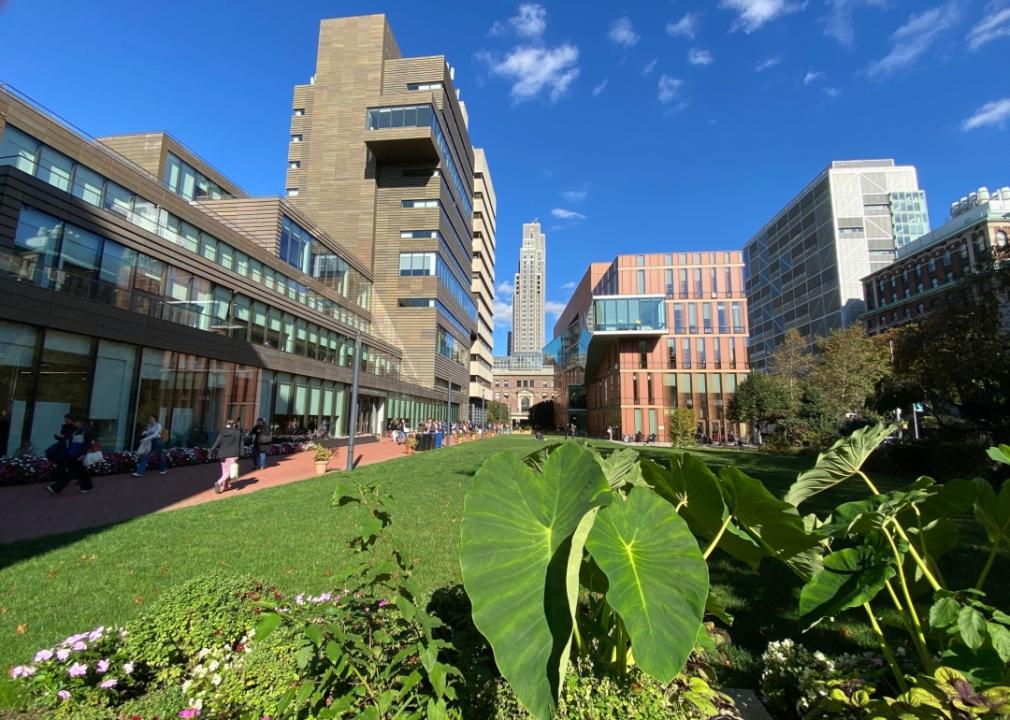
Here Now // Shutterstock
#44. Barnard College
View of Barnard College main campus with the Milstein Center and Futter Field.
– Location: New York City
– Undergraduate enrollment: 3,091
– Student-to-faculty ratio: 10:1
– Acceptance rate: 9%
– Graduation rate: 92%
– Six-year median earnings: $57,900
– Two-year employment rate: 90%
Located across the street from Columbia University, Barnard College offers the same privileges to its students. The Barnard Center for Research on Women and the Athena Film Festival are two celebrated resources on campus. A center for teaching and learning, which opened in 2018, has given the school its own distinctive hub.
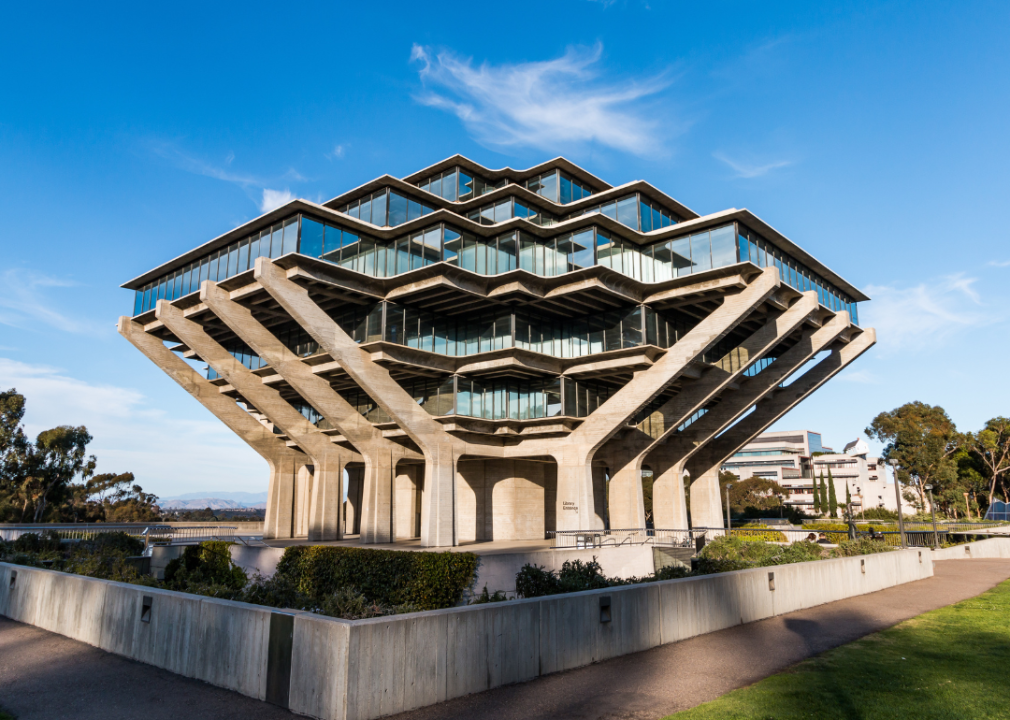
Sherry V Smith // Shutterstock
#43. University of California San Diego
The Geisel Library on the campus of the University of California San Diego.
– Location: La Jolla, California
– Undergraduate enrollment: 32,138
– Student-to-faculty ratio: 10:1
– Acceptance rate: 24%
– Graduation rate: 88%
– Six-year median earnings: $59,900
– Two-year employment rate: 89%
The University of California San Diego is one of the top research universities in the world and received $1.73 billion in funding for fiscal year 2024. UC San Diego boasts renowned faculty, including 16 Nobel laureates throughout the school’s history. Students are also focused on civic engagement and public service.
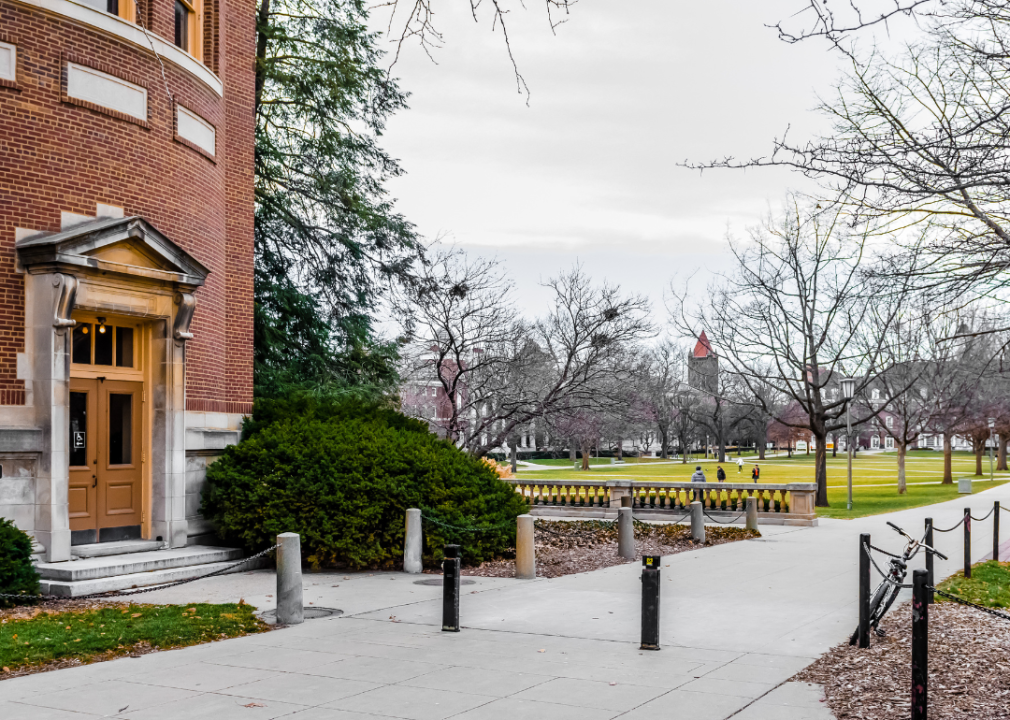
Canva
#42. University of Illinois Urbana-Champaign
An exterior view of the campus of the University of Illinois Urbana-Champaign with the bell tower in the distance.
– Location: Champaign, Illinois
– Undergraduate enrollment: 33,813
– Student-to-faculty ratio: 14:1
– Acceptance rate: 45%
– Graduation rate: 85%
– Six-year median earnings: $61,500
– Two-year employment rate: 95%
The University of Illinois Urbana-Champaign counts dozens of Nobel and Pulitzer Prize winners among its alumni and faculty. The school offers one of the largest public university libraries in the world, with more than 15 million volumes and 24 million other items. It is highly regarded for its leading research in technology, agriculture, and government policy.
f11photo // Shutterstock
#41. University of Texas at Austin
The Main Building, known colloquially as The Tower, at the center of the University of Texas at Austin campus.
– Location: Austin, Texas
– Undergraduate enrollment: 38,591
– Student-to-faculty ratio: 13:1
– Acceptance rate: 31%
– Graduation rate: 88%
– Six-year median earnings: $58,200
– Two-year employment rate: 93%
University of Texas at Austin students can take advantage of the McDonald Observatory, one of many prestigious facilities at this state school. The campus has a wealth of museums, from the LBJ Presidential Library to the Blanton Museum of Art, and you might even catch Matthew McConaughey at a Longhorns football game. Outside of campus, students can partake in the capital’s cultural institutions, such as South by Southwest and Franklin Barbecue.
You may also like: When it comes to using AI, nursing students trust themselves to use it correctly—but not their peers or administrators
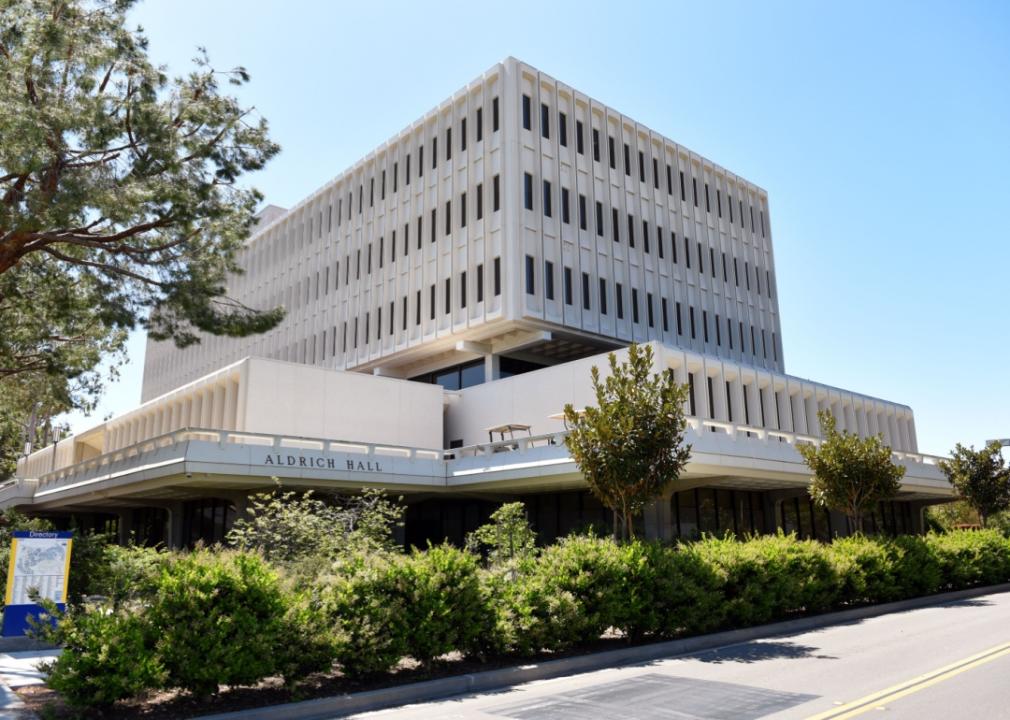
Steve Cukrov // Shutterstock
#40. University of California, Irvine
Aldrich Hall on the campus of the University of California Irvine.
– Location: Irvine, California
– Undergraduate enrollment: 27,932
– Student-to-faculty ratio: 12:1
– Acceptance rate: 21%
– Graduation rate: 87%
– Six-year median earnings: $58,400
– Two-year employment rate: 90%
The University of California, Irvine is consistently one of the top-ranked public universities in the country. It has a particularly well-regarded medical program and supports research and innovation across disciplines. The school is also another that houses a nuclear reactor on campus.
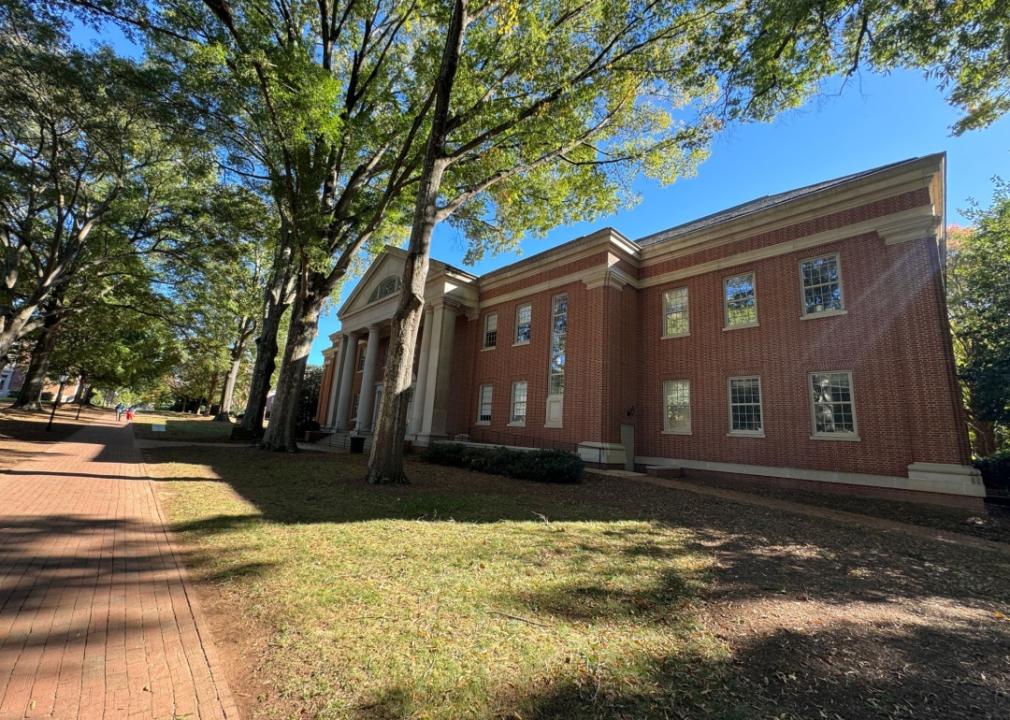
marlin goodwin // Shutterstock
#39. Davidson College
An exterior view of Davidson North Carolina college campus.
– Location: Davidson, North Carolina
– Undergraduate enrollment: 1,927
– Student-to-faculty ratio: 9:1
– Acceptance rate: 17%
– Graduation rate: 92%
– Six-year median earnings: $58,900
– Two-year employment rate: 88%
Davidson College, just north of Charlotte, North Carolina, is known for its tight-knit community, which comes together for events including flickerball—a variation of touch football created on campus in 1951. The Farm teaches students about sustainable growth and provides them with fresh produce.
Spiroview Inc // Shutterstock
#38. Swarthmore College
Stone buildings on the campus of Swarthmore College.
– Location: Swarthmore, Pennsylvania
– Undergraduate enrollment: 1,625
– Student-to-faculty ratio: 6:1
– Acceptance rate: 7%
– Graduation rate: 94%
– Six-year median earnings: $56,700
– Two-year employment rate: 85%
Swarthmore College has several sustainability initiatives, with the goal of becoming a zero-waste campus by 2035. The 300-acre Scott Arboretum is a highlight of the 425-acre grounds, located 11 miles from Philadelphia, and the Peaslee Debate Society is among the popular extracurricular options.
Colin D. Young // Shutterstock
#37. Williams College
An ivy covered building on the campus of Williams College.
– Location: Williamstown, Massachusetts
– Undergraduate enrollment: 2,146
– Student-to-faculty ratio: 6:1
– Acceptance rate: 8%
– Graduation rate: 95%
– Six-year median earnings: $59,000
– Two-year employment rate: 90%
Fraternities no longer exist at Williams College, but more than 1 in 3 students participates in intercollegiate sports. Nearly everyone engages in clubs or activities, and the school has an exclusive program with the University of Oxford. January is dedicated to winter study, when students pursue one single subject on a pass-fail basis, conduct research, land an internship, or travel.
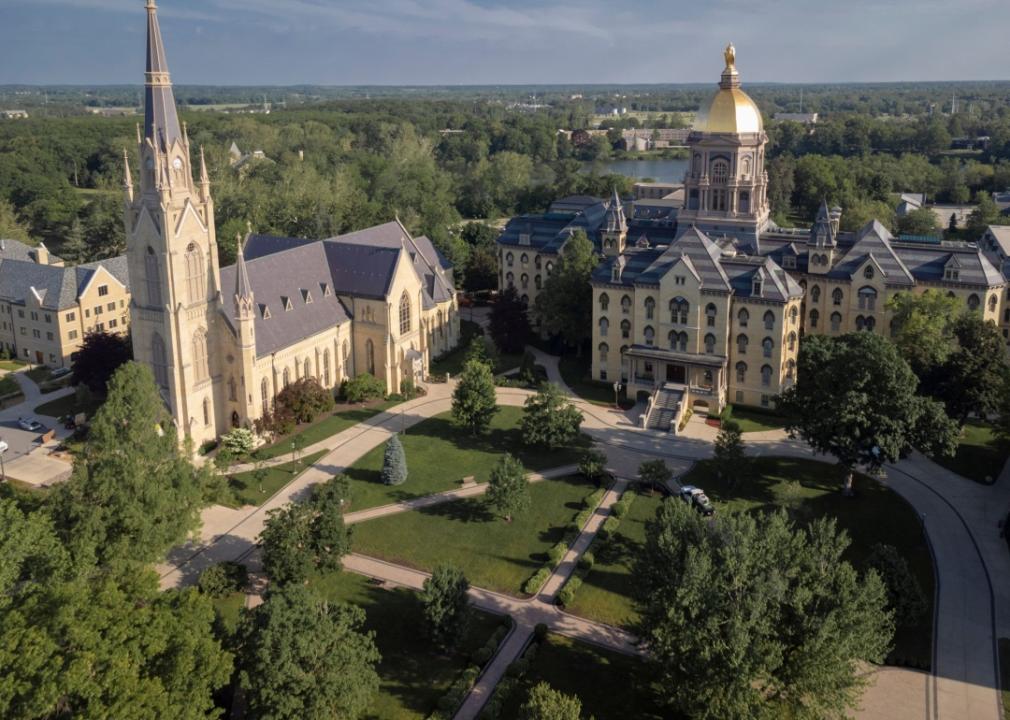
University of College // Shutterstock
#36. University of Notre Dame
Aerial view of Basilica of the Sacred Heart and Main Building at the University of Notre Dame campus.
– Location: Notre Dame, Indiana
– Undergraduate enrollment: 8,953
– Student-to-faculty ratio: 7:1
– Acceptance rate: 13%
– Graduation rate: 96%
– Six-year median earnings: $78,400
– Two-year employment rate: 95%
The University of Notre Dame combines Catholic and intellectual pursuits in a leading school known for its theology and philosophy departments. The college is a top undergraduate teaching institution and research center, and the Raclin Murphy Museum of Art and the DeBartolo Performing Arts Center provide insightful programming. The campus also has more than 60 chapels.
You may also like: Best colleges for LGBTQ+ students in 2024
Ken Wolter // Shutterstock
#35. University of California, Berkeley
An aerial view of the campus of the University of California, Berkeley.
– Location: Berkeley, California
– Undergraduate enrollment: 30,824
– Student-to-faculty ratio: 14:1
– Acceptance rate: 11%
– Graduation rate: 94%
– Six-year median earnings: $64,700
– Two-year employment rate: 88%
Often considered the top public university in the country, the University of California, Berkeley has many Nobel Prize winners among its alumni and faculty and has produced the most Peace Corps volunteers—almost 4,000. With many important projects emanating from the Space Sciences Laboratory, and a history of entrepreneurship, students often become leaders in their fields.
littlenySTOCK // Shutterstock
#34. New York University
The arched entrance to New York University School of Law in Manhattan.
– Location: New York City
– Undergraduate enrollment: 28,354
– Student-to-faculty ratio: 3:1
– Acceptance rate: 12%
– Graduation rate: 87%
– Six-year median earnings: $61,900
– Two-year employment rate: 91%
New York University has more international students and those studying abroad than any school in America. It draws creatives and filmmakers to its chic campus centered in historic Greenwich Village. The school offers a range of unique courses, from its Center for Disability Studies to classes on injustice, disaster nursing and emergency preparedness, and the New York Underground.
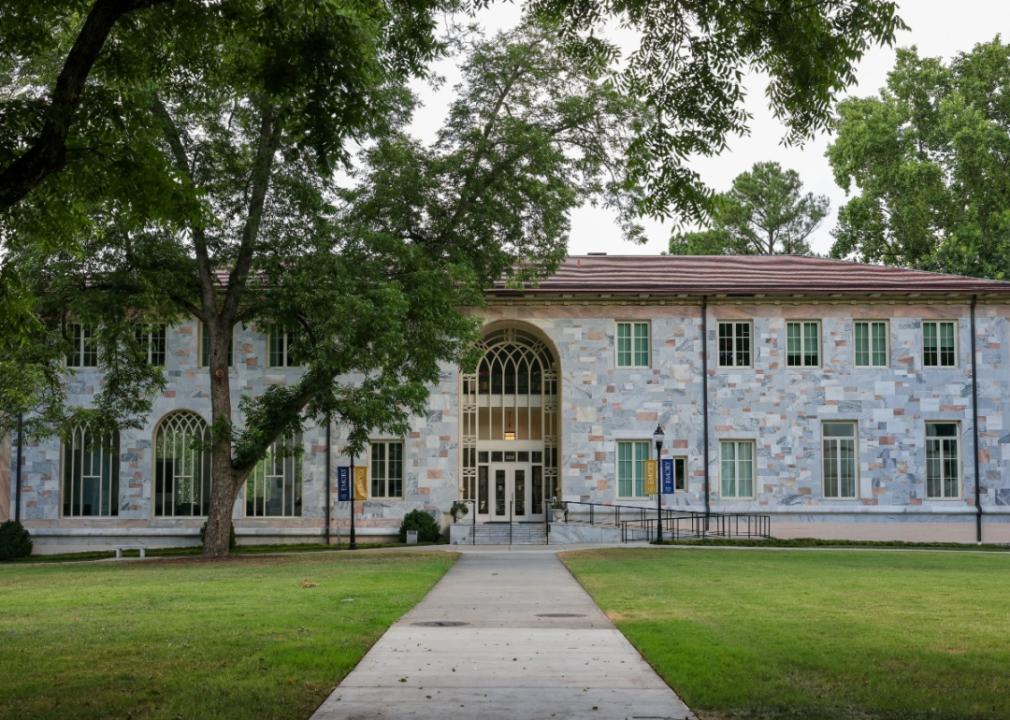
Bo Shen // Shutterstock
#33. Emory University
Convocation hall on Emory University’s Atlanta campus.
– Location: Atlanta
– Undergraduate enrollment: 7,022
– Student-to-faculty ratio: 4:1
– Acceptance rate: 11%
– Graduation rate: 90%
– Six-year median earnings: $66,000
– Two-year employment rate: 92%
Emory University is internationally known for its liberal arts colleges, graduate and professional schools, and academic health care system. The Goizueta Business School is consistently ranked as one of the nation’s best. The Carter Center, created by former President Jimmy Carter, offers internships and lectures throughout the year.
Bryan Pollard // Shutterstock
#32. University of Florida
The exterior of a modern building at the University of Florida.
– Location: Gainesville, Florida
– Undergraduate enrollment: 31,017
– Student-to-faculty ratio: 10:1
– Acceptance rate: 23%
– Graduation rate: 90%
– Six-year median earnings: $56,000
– Two-year employment rate: 92%
The University of Florida hosts the most powerful supercomputer owned by a college in the country, and all students are taught about artificial intelligence. Accelerate at Sid Martin Biotech is a business incubator affiliated with the school, and UF Innovate offers other research- and innovation-oriented programs.
Ritu Manoj Jethani // Shutterstock
#31. Northeastern University
A frontal view of the Northeastern University campus.
– Location: Boston
– Undergraduate enrollment: 16,278
– Student-to-faculty ratio: 8:1
– Acceptance rate: 7%
– Graduation rate: 91%
– Six-year median earnings: $67,400
– Two-year employment rate: 95%
Northeastern University is regularly considered one of the best colleges for co-op and internship experiences. It has 13 campuses in the U.S., Canada, and the United Kingdom and 3,500 employer partners around the world. Fields of study include robotics research and chemical imaging.
You may also like: Just one-third of students say college is worth the cost
Bryan Pollard // Shutterstock
#30. University of North Carolina at Chapel Hill
An exterior view of Carroll Hall at the University of North Carolina.
– Location: Chapel Hill, North Carolina
– Undergraduate enrollment: 19,939
– Student-to-faculty ratio: 9:1
– Acceptance rate: 17%
– Graduation rate: 91%
– Six-year median earnings: $55,600
– Two-year employment rate: 94%
The University of North Carolina at Chapel Hill’s medical programs, particularly in dentistry and pharmacy, receive high praise. The school prides itself on teaching, research, and public service as well as carrying on a storied history and tradition; it opened in 1795.
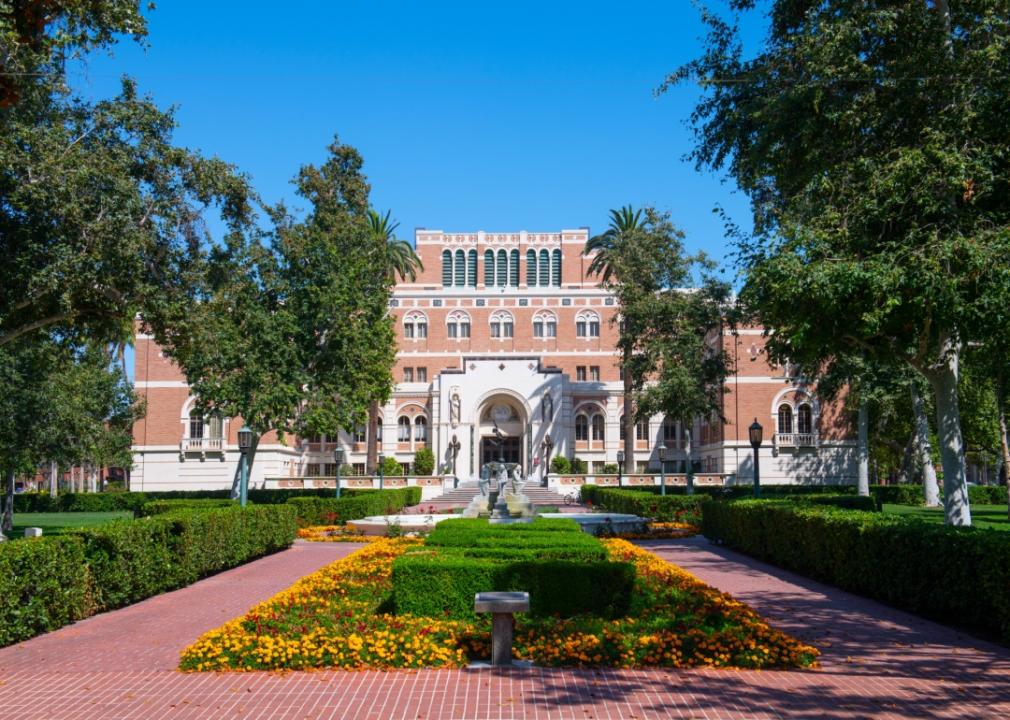
Wangkun Jia // Shutterstock
#29. University of Southern California
The Edward L. Doheny Jr. Memorial Library on University of Southern California in downtown Los Angeles.
– Location: Los Angeles
– Undergraduate enrollment: 20,185
– Student-to-faculty ratio: 7:1
– Acceptance rate: 12%
– Graduation rate: 92%
– Six-year median earnings: $74,000
– Two-year employment rate: 92%
Located in southwest Los Angeles, the University of Southern California has a network of over 480,000 living alumni for making connections in Hollywood and elsewhere. George Lucas and Robert Zemeckis are just some of the directors to attend the School of Cinematic Arts. The Spirit of Troy marching band is one of the best in the nation.
Barbara Kalbfleisch // Shutterstock
#28. Claremont McKenna College
A stone sign at the entrance to Claremont McKenna College.
– Location: Claremont, California
– Undergraduate enrollment: 1,380
– Student-to-faculty ratio: 7:1
– Acceptance rate: 10%
– Graduation rate: 91%
– Six-year median earnings: $72,900
– Two-year employment rate: 92%
Located 30 miles east of Los Angeles, Claremont McKenna College, despite encompassing only 1 square mile, has plenty on campus to keep students busy, including the Athenaeum, which hosts a variety of speakers four nights a week. This small school has close student-faculty bonds, as about 75% of students engage in research with faculty.
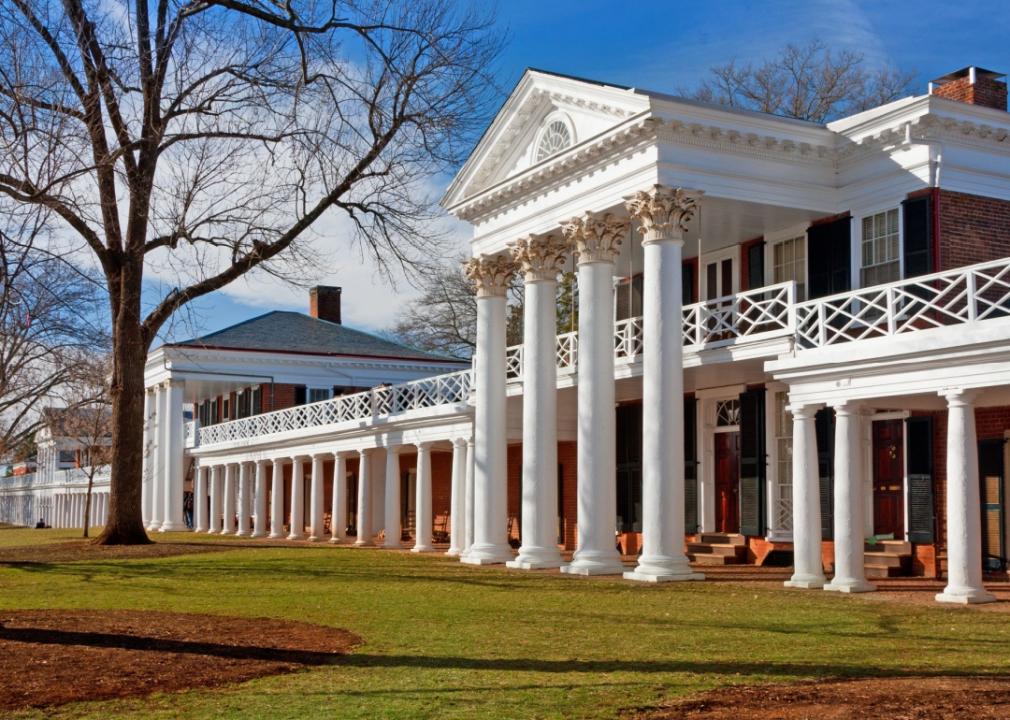
Melinda Fawver // Shutterstock
#27. University of Virginia
Academical village at the University of Virginia, Charlottesville.
– Location: Charlottesville, Virginia
– Undergraduate enrollment: 16,523
– Student-to-faculty ratio: 7:1
– Acceptance rate: 19%
– Graduation rate: 95%
– Six-year median earnings: $61,200
– Two-year employment rate: 94%
The University of Virginia is a public school that earns high marks for its business program and hospital. The college has counted $2.76 billion in research proposal activity in 2024, with the Data Science Institute and Biocomplexity Institute and Initiative anchoring that area.
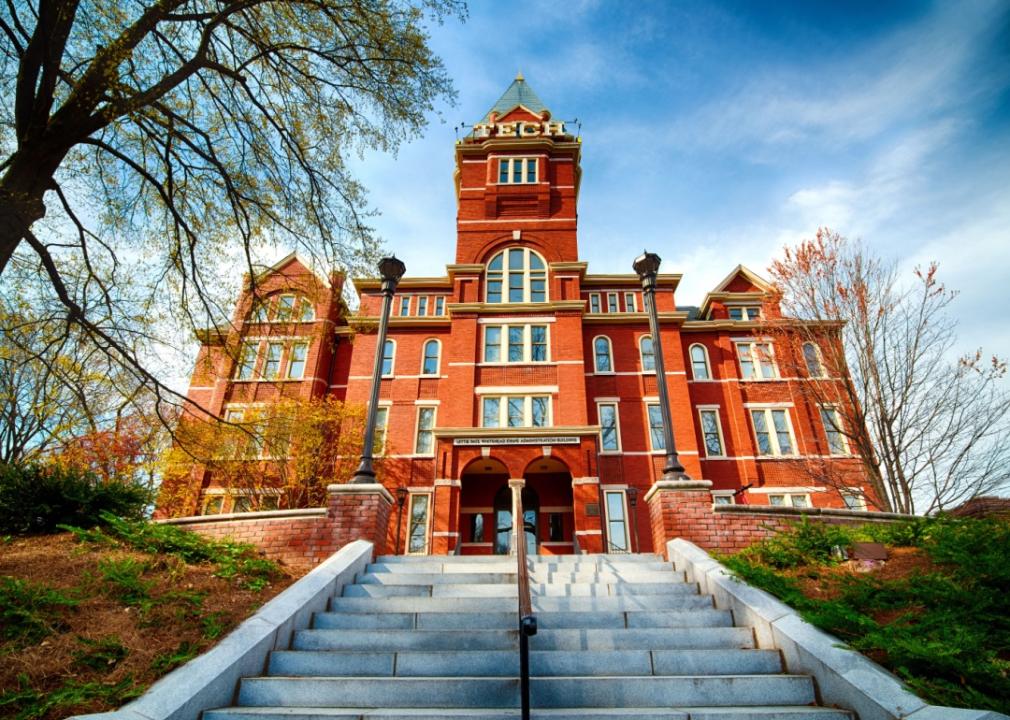
Rob Hainer // Shutterstock
#26. Georgia Institute of Technology
Tech Tower at the Georgia Institute of Technology in Atlanta.
– Location: Atlanta
– Undergraduate enrollment: 16,207
– Student-to-faculty ratio: 14:1
– Acceptance rate: 17%
– Graduation rate: 93%
– Six-year median earnings: $79,100
– Two-year employment rate: 95%
Centered in Atlanta, the Georgia Institute of Technology has a top-ranked undergraduate engineering program. It produces the most women and underrepresented minorities with engineering degrees in the nation, and the Institute for Robotics and Intelligent Machines breaks ground in autonomy, medical robotics and human augmentation, and collaborative robotics.
You may also like: Public schooling is best in these US cities
Wangkun Jia // Shutterstock
#25. Boston University
A Boston University flag flies on the grounds of the campus.
– Location: Boston
– Undergraduate enrollment: 17,734
– Student-to-faculty ratio: 5:1
– Acceptance rate: 14%
– Graduation rate: 89%
– Six-year median earnings: $65,300
– Two-year employment rate: 93%
Located in one of America’s busiest college cities, Boston University offers a mix of big city buildings and intimate brownstones. It stands on accessible education and prioritizes research, artistic creation, and professional practice. The school is also home to the Boston Playwrights’ Theatre and easily accessible from most parts of the city by public transportation.

Sandra Foyt // Shutterstock
#24. Pomona College
The historic Carnegie Library at Pomona College.
– Location: Claremont, California
– Undergraduate enrollment: 1,739
– Student-to-faculty ratio: 7:1
– Acceptance rate: 7%
– Graduation rate: 95%
– Six-year median earnings: $58,100
– Two-year employment rate: 90%
Despite its small size, Pomona College—one of five Claremont Colleges—has more than 250 clubs and organizations, and 94% of students live on campus for four years, creating a tight-knit atmosphere. Near Los Angeles in a bucolic mountain setting, students enjoy skiing and beaches, including the annual Ski-Beach Day. The school also has an art museum and eight music ensembles.
Jay Yuan // Shutterstock
#23. Carnegie Mellon University
An aerial view of the Carnegie Mellon University campus.
– Location: Pittsburgh
– Undergraduate enrollment: 6,858
– Student-to-faculty ratio: 5:1
– Acceptance rate: 11%
– Graduation rate: 92%
– Six-year median earnings: $83,600
– Two-year employment rate: 91%
Carnegie Mellon University students study topics including brain science and driverless vehicles, with the latter pursuit having begun four decades ago. It is commonly recognized for its premier computer science, business, and engineering programs and boasts a highly respected drama program. It is one of the only schools to offer a degree in bagpipe performance.
Jay Yuan // Shutterstock
#22. Princeton University
Pink-flowering dogwood trees with in front of an arched entrance at Princeton University.
– Location: Princeton, New Jersey
– Undergraduate enrollment: 5,540
– Student-to-faculty ratio: 5:1
– Acceptance rate: 6%
– Graduation rate: 97%
– Six-year median earnings: $74,700
– Two-year employment rate: 87%
Ninety-six percent of students live on campus at Princeton University, which is in downtown Princeton and a short train ride to New York City and Philadelphia. Noted for its economics and engineering departments, Princeton also thrives in modern sciences such as plasma physics, and a quantum science center has been in the works for years. Eating clubs are at an intersection of social life and tradition.
EQRoy // Shutterstock
#21. The University of Chicago
Graduation preparations, folding chairs set up in rows in front of a red curtain with the words, University of Chicago, and the university’s coat of arms.
– Location: Chicago
– Undergraduate enrollment: 7,563
– Student-to-faculty ratio: 3:1
– Acceptance rate: 5%
– Graduation rate: 96%
– Six-year median earnings: $68,100
– Two-year employment rate: 92%
The University of Chicago has been instrumental in pioneering various cancer treatments, discovering new dinosaur species, and proposing the existence of black holes. The school hosts Frank Lloyd Wright’s Robie House, a National Historic Landmark and part of a UNESCO World Heritage inscription. The school also has a long tradition of nurturing successful improv comedy troupes.
You may also like: FAFSA complications impact college-related decisions for 79% of first-gen applicants
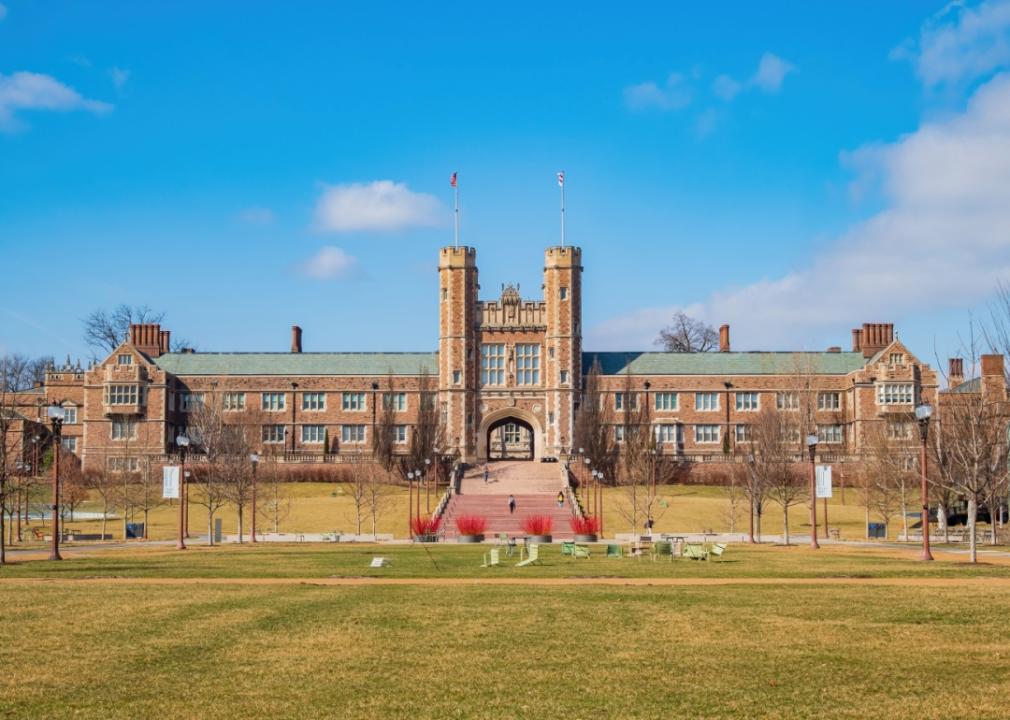
Kit Leong // Shutterstock
#20. Washington University in St. Louis
Sunny view of the Brookings Hall of Washington University in St. Louis.
– Location: Saint Louis
– Undergraduate enrollment: 7,445
– Student-to-faculty ratio: 4:1
– Acceptance rate: 12%
– Graduation rate: 94%
– Six-year median earnings: $70,100
– Two-year employment rate: 94%
Students at Washington University in St. Louis come from over 110 countries, and 8 in 10 undergraduates pursue multiple majors or minors. WashU received $978 million in sponsored support in 2023 for medical, environmental and energy, innovation and entrepreneurial, plant science, and other research. The university also has nine libraries and its own art museum.
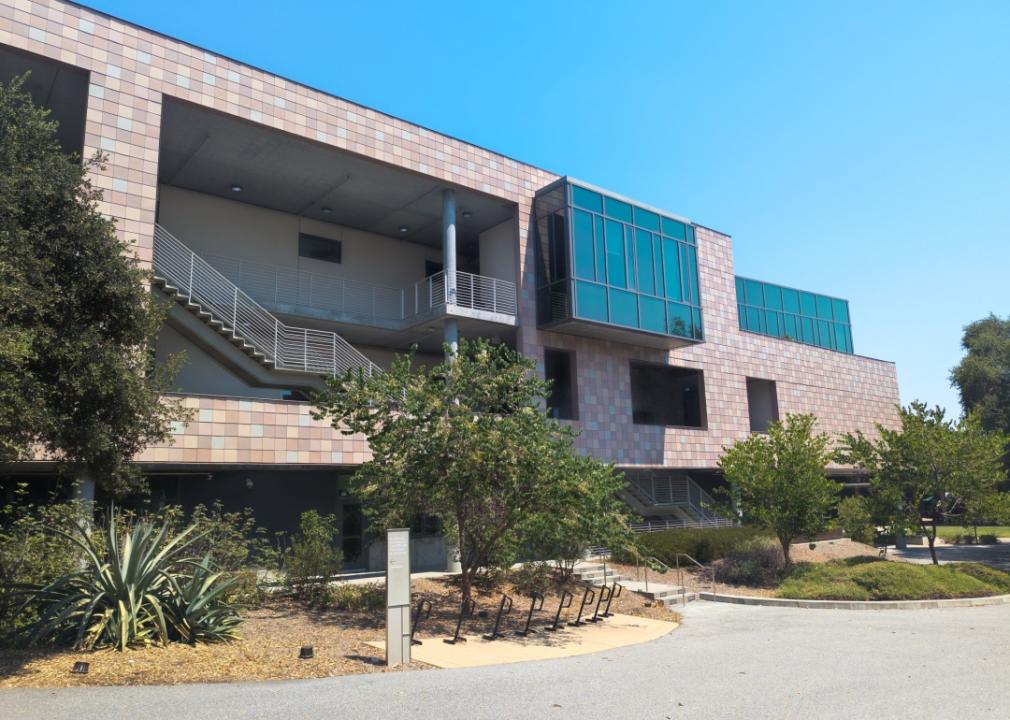
Jim_Brown_Photography // Shutterstock
#19. Harvey Mudd College
An exterior view of an academic building at Harvey Mudd College.
– Location: Claremont, California
– Undergraduate enrollment: 906
– Student-to-faculty ratio: 8:1
– Acceptance rate: 13%
– Graduation rate: 92%
– Six-year median earnings: $88,800
– Two-year employment rate: 89%
Harvey Mudd College focuses on engineering, science, and math, offering real-world experience through its Clinic Program. Students regularly engage in elaborate pranks. Ski slopes are less than 30 minutes away, beaches less than an hour, and the desert 90 minutes.
SNEHIT PHOTO // Shutterstock
#18. University of Michigan
An exterior view of a campus building with blue sky and a green lawn.
– Location: Ann Arbor, Michigan
– Undergraduate enrollment: 31,319
– Student-to-faculty ratio: 4:1
– Acceptance rate: 18%
– Graduation rate: 93%
– Six-year median earnings: $63,400
– Two-year employment rate: 94%
In 2023, the University of Michigan produced 580 inventions and 25 business startups. U-M regularly lands among the schools with the most research volume, has a top academic medical center and multiple renowned graduate programs, and scores well in affordability with its financial aid. Michigan Stadium is the largest in the country with a capacity for 109,901 fans.
Lewis Liu // Shutterstock
#17. Cornell University
An aerial view of the Cornell University campus.
– Location: Ithaca, New York
– Undergraduate enrollment: 15,735
– Student-to-faculty ratio: 8:1
– Acceptance rate: 7%
– Graduation rate: 95%
– Six-year median earnings: $77,200
– Two-year employment rate: 93%
For decades, Cornell University has been vital to space exploration to Mars and advancements in agriculture and farming. Though centered in Ithaca, Cornell has several facilities in New York City and two programs overseas. Gatherings at ice hockey games are full of traditions, and they can be followed by a trip to the Cornell Dairy for ice cream.
Michael Gordon // Shutterstock
#16. University of California, Los Angeles
Exterior of Royce Hall building in the campus of UCLA.
– Location: Los Angeles
– Undergraduate enrollment: 31,763
– Student-to-faculty ratio: 7:1
– Acceptance rate: 9%
– Graduation rate: 92%
– Six-year median earnings: $60,700
– Two-year employment rate: 89%
The University of California, Los Angeles offers more than 140 majors and receives over $1.6 billion annually in competitive grants and contracts. The perfectly situated campus is regularly used as a filming location and hosts several large gatherings throughout the year, including the JazzReggae Festival. Bruins athletic teams have won 124 national championships—the second-most all-time.
You may also like: Where graduation rates for students with disabilities are improving
cheng // Shutterstock
#15. Rice University
Rice University Lovett Hall in the afternoon.
– Location: Houston
– Undergraduate enrollment: 4,150
– Student-to-faculty ratio: 5:1
– Acceptance rate: 9%
– Graduation rate: 94%
– Six-year median earnings: $65,400
– Two-year employment rate: 92%
An oak tree-lined sanctuary in the middle of bustling Houston, Rice University is consistently ranked near the top of lists that gauge students’ quality of life. Rice has been a leader in artificial heart research and other sciences and maintains a close partnership with NASA. It was modeled after English universities, with eight residential colleges.
Ken Wolter // Shutterstock
#14. California Institute of Technology
Exterior of the Beckman Institute at the California Institute of Technology.
– Location: Pasadena, California
– Undergraduate enrollment: 982
– Student-to-faculty ratio: 3:1
– Acceptance rate: 3%
– Graduation rate: 94%
– Six-year median earnings: $85,900
– Two-year employment rate: 89%
The California Institute of Technology is home to the Jet Propulsion Laboratory, the Einstein Papers Project, a seismological laboratory, and an international observatory network. Every Halloween, students combine their interest in sciences with recreation, smashing pumpkins from the top of Caltech Hall. The student body is famous for its pranks.
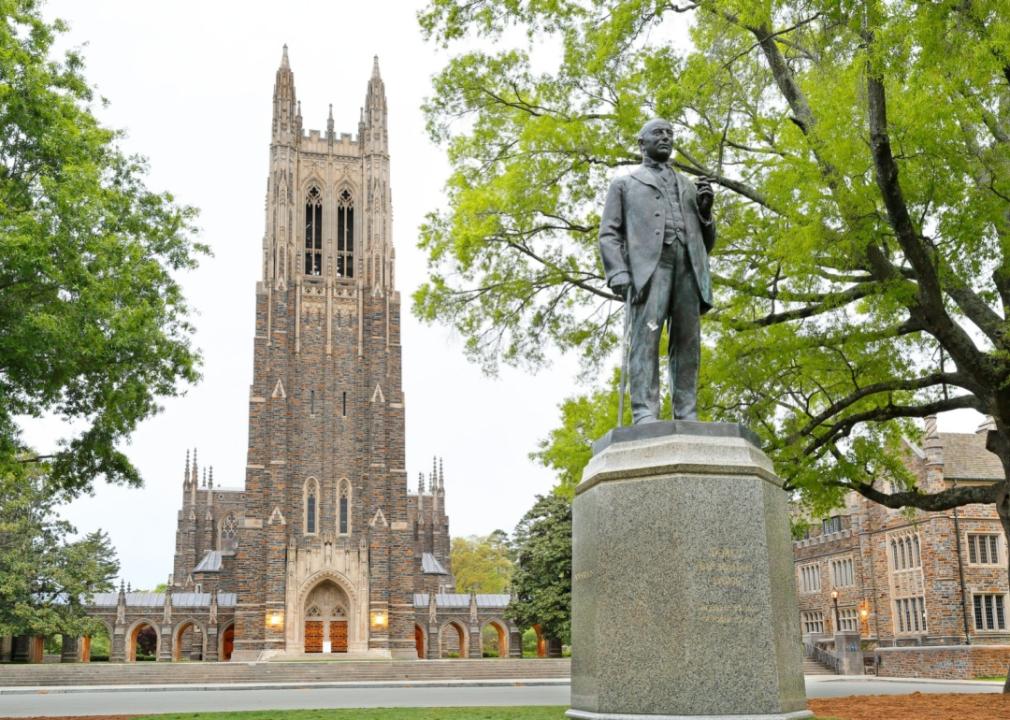
Jay Yuan // Shutterstock
#13. Duke University
Benjamin Duke statue on campus of Duke University.
– Location: Durham, North Carolina
– Undergraduate enrollment: 6,435
– Student-to-faculty ratio: 2:1
– Acceptance rate: 6%
– Graduation rate: 97%
– Six-year median earnings: $84,400
– Two-year employment rate: 94%
Duke University’s law and medical schools regularly rank near the top of lists, and the Levine Science Research Center—one of the country’s largest single-site interdisciplinary research facilities—is impressive too. Duke University Chapel is a center for campus events and religious services, and Cameron Indoor Stadium offers a premier sporting environment.
Sharkshock // Shutterstock
#12. Georgetown University
Students heading to class on the campus of Georgetown University.
– Location: Washington D.C.
– Undergraduate enrollment: 7,187
– Student-to-faculty ratio: 4:1
– Acceptance rate: 12%
– Graduation rate: 96%
– Six-year median earnings: $93,500
– Two-year employment rate: 92%
Georgetown University, the nation’s oldest Catholic and Jesuit university, is home to the largest student-run business in the world, The Corp, and the oldest continuously running student theater group, Mask and Bauble. Its business school launched the Venture Lab for students to incubate ideas and startups. Located in Washington D.C., students are connected to a bevy of internship opportunities with private businesses and local, state, and federal governments.
EQRoy // Shutterstock
#11. Northwestern University
An arched entryway to the Northwestern University campus.
– Location: Evanston, Illinois
– Undergraduate enrollment: 8,794
– Student-to-faculty ratio: 4:1
– Acceptance rate: 7%
– Graduation rate: 97%
– Six-year median earnings: $69,000
– Two-year employment rate: 92%
Northwestern University’s journalism program has a century-long tradition of producing quality reporters. The school’s business and materials science and engineering programs are also highly regarded, while research remains its backbone—with $2.6 billion in revenue from patents and intellectual property licensing. Located outside of Chicago, Northwestern combines suburban tranquility with a big-city feel.
You may also like: Laws and loopholes still perpetuate school segregation across America
Jon Bilous // Shutterstock
#10. Johns Hopkins University
Mason Hall on the campus of Johns Hopkins University.
– Location: Baltimore
– Undergraduate enrollment: 5,644
– Student-to-faculty ratio: 1:1
– Acceptance rate: 7%
– Graduation rate: 94%
– Six-year median earnings: $73,200
– Two-year employment rate: 91%
Johns Hopkins University is one of the preeminent schools for studying medicine. For 44 consecutive years it has led U.S. colleges in research and development spending, and it counts 29 Nobel Prize winners among its associates. The school also runs programs in conjunction with NASA, and the Spring Fair is one of the largest such gatherings in the nation.
Sean Pavone // Shutterstock
#9. Vanderbilt University
A clock tower is seen through green leaves on the campus of Vanderbilt University.
– Location: Nashville, Tennessee
– Undergraduate enrollment: 7,082
– Student-to-faculty ratio: 5:1
– Acceptance rate: 7%
– Graduation rate: 93%
– Six-year median earnings: $69,000
– Two-year employment rate: 94%
Vanderbilt University is one of the world’s most innovative institutions. From 2014-2023, it launched 61 startups and had 593 patents and 923 licenses issued, and the Center for Technology Transfer and Commercialization continues to break ground. Vanderbilt was ranked #1 by The Princeton Review in students’ quality of life and is also known for its medical center and music school.
Jon Bilous // Shutterstock
#8. Brown University
Steps lead up to a building on the Brown University campus.
– Location: Providence, Rhode Island
– Undergraduate enrollment: 7,189
– Student-to-faculty ratio: 7:1
– Acceptance rate: 5%
– Graduation rate: 95%
– Six-year median earnings: $67,500
– Two-year employment rate: 91%
Brown University is well known for its open curriculum, which encourages creative thinkers, intellectual risk-takers, and entrepreneurial problem-solvers. The Carney Institute for Brain Science and the Institute at Brown for Environment and Society provide unique perspectives to important fields of study. The university values its relationship with Providence, and more than 420 students work or volunteer every year in the city’s public schools.
Jay Yuan // Shutterstock
#7. Dartmouth College
Students relax on the lawn before a clock tower on the campus of Dartmouth College.
– Location: Hanover, New Hampshire
– Undergraduate enrollment: 4,457
– Student-to-faculty ratio: 6:1
– Acceptance rate: 6%
– Graduation rate: 95%
– Six-year median earnings: $75,500
– Two-year employment rate: 94%
Dartmouth College allows students to customize their academic schedules. This Ivy League institution has an abundance of centers for arts and culture as well as various technology and science institutes. Each year, it hosts a Winter Carnival and a Powwow celebrating Indigenous history.
f11photo // Shutterstock
#6. University of Pennsylvania
The Fisher Hassenfeld College House on the campus of the University of Pennsylvania as seen from across the street..
– Location: Philadelphia
– Undergraduate enrollment: 10,412
– Student-to-faculty ratio: 5:1
– Acceptance rate: 7%
– Graduation rate: 96%
– Six-year median earnings: $85,900
– Two-year employment rate: 91%
Researchers at the University of Pennsylvania—including more than 5,000 faculty at 195 centers and institutes—have a budget of $1.37 billion in 2024, focusing on medicine, technology, business, and science. Penn was founded in 1740 and has four undergraduate and 12 graduate schools, including the distinguished Wharton School. Its arts and culture and Philly attractions are nearly limitless, and then, of course, there’s “Ben on the Bench.”
You may also like: Room scans and eye detectors: Robocops are watching your kids take online exams
Jorge Salcedo // Shutterstock
#5. Harvard University
A brick and iron archway leads onto the Harvard campus.
– Location: Cambridge, Massachusetts
– Undergraduate enrollment: 7,516
– Student-to-faculty ratio: 4:1
– Acceptance rate: 3%
– Graduation rate: 98%
– Six-year median earnings: $89,700
– Two-year employment rate: 89%
Harvard University, which dates to 1636, was the first college in the American colonies, and it remains a bastion of success. The school has educated eight U.S. presidents and in 2022 earmarked $100 million to address its history with slavery. Harvard has over 450 organizations and offers 42 varsity sports, the most in the country. The Harvard Lampoon humor magazine has been entertaining (and infuriating) students for almost 150 years.
Suchan // Shutterstock
#4. Columbia University
A view from behind the Alma Mater bronze sculpture, a person seated on a throne in an academic gown and wearing a laurel upon their head, on the steps of the Low Memorial Library on the campus of Columbia University.
– Location: New York City
– Undergraduate enrollment: 8,263
– Student-to-faculty ratio: 2:1
– Acceptance rate: 4%
– Graduation rate: 95%
– Six-year median earnings: $83,300
– Two-year employment rate: 89%
Columbia University is located on the Upper West Side of Manhattan in New York City, near a variety of parks and landmarks. The students form a melting pot, with 17% from international locales and 13% from domestic small towns. Campus media outlets such as the Columbia Daily Spectator, WKCR, and Bwog captivate readers and listeners throughout the city. For decades, students have started protests that have made national headlines.
Dmitrii Sakharov // Shutterstock
#3. Stanford University
Stanford University campus with Hoover Tower in the background.
– Location: Stanford, California
– Undergraduate enrollment: 7,761
– Student-to-faculty ratio: 2:1
– Acceptance rate: 4%
– Graduation rate: 95%
– Six-year median earnings: $94,000
– Two-year employment rate: 94%
Located in Silicon Valley in Northern California, Stanford University has strong bonds with tech giants such as Google, which was founded by Stanford students. It has seven schools and is known for its acclaimed education, engineering, law, and business programs; theater and music groups; and the Solar Car Project. The university also has a storied athletic program, and its athletes have won hundreds of Olympic medals.
Travel_Adventure // Shutterstock
#2. Massachusetts Institute of Technology
The Great Dome of the Massachusetts Institute of Technology in Cambridge on a sunny day, with people walking around.
– Location: Cambridge, Massachusetts
– Undergraduate enrollment: 4,601
– Student-to-faculty ratio: 3:1
– Acceptance rate: 4%
– Graduation rate: 95%
– Six-year median earnings: $104,700
– Two-year employment rate: 94%
Students and researchers at the Massachusetts Institute of Technology are always on the cutting edge of modern technology. Among the highlights of this school are the Haystack Observatory, Media Lab (designed by alum I. M. Pei), and MIT.nano. MIT has acres of stunning scenery, from quiet Cambridge streets to the futuristic layout of Simmons Hall, and a striking public art collection.
Helioscribe // Shutterstock
#1. Yale University
People walk along a sidewalk near an ornate archway and an intricate iron gate on the campus of Yale University.
– Location: New Haven, Connecticut
– Undergraduate enrollment: 6,594
– Student-to-faculty ratio: 2:1
– Acceptance rate: 5%
– Graduation rate: 98%
– Six-year median earnings: $83,200
– Two-year employment rate: 92%
Thirty percent of the Yale University student body hails from abroad, creating a diverse mix on the neo-Gothic campus nestled in downtown New Haven. Yale has 14 residential colleges and is known for its law, art, nursing, drama, environment, and divinity schools, among others. Founded in 1701, it has many revered traditions, including Class Day, which features prizes and awards, ivy, churchwarden pipes, hats, and more.
Story editing by Mike Taylor. Copy editing by Robert Wickwire and Lois Hince. Photo selection by Clarese Moller.
You may also like: The education requirements for the fastest-growing health care jobs
